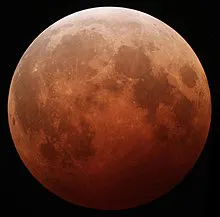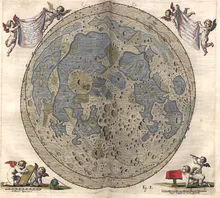

Moon
From Wikipedia, the free encyclopedia
Jump to navigation (Öffnet in neuem Fenster)Jump to search (Öffnet in neuem Fenster)
This article is about Earth's natural satellite. For moons in general, see Natural satellite (Öffnet in neuem Fenster). For other uses, see Moon (disambiguation) (Öffnet in neuem Fenster).
Moon 

Full moon (Öffnet in neuem Fenster) seen from Earth
Designations
Designation
Earth I
Alternative names (Öffnet in neuem Fenster)
Selene (Öffnet in neuem Fenster) (poetic)
Cynthia (Öffnet in neuem Fenster) (poetic)
Adjectives (Öffnet in neuem Fenster)
Selenian (Öffnet in neuem Fenster) (poetic)
Cynthian (Öffnet in neuem Fenster) (poetic)
Moonly (Öffnet in neuem Fenster) (poetic)
Orbital characteristics (Öffnet in neuem Fenster)Epoch (Öffnet in neuem Fenster) J2000 (Öffnet in neuem Fenster)Perigee (Öffnet in neuem Fenster)362600 km
(356400–370400 km)Apogee (Öffnet in neuem Fenster)405400 km
(404000–406700 km)
Semi-major axis (Öffnet in neuem Fenster)
384399 km (1.28 ls (Öffnet in neuem Fenster), 0.00257 AU (Öffnet in neuem Fenster))[1] (Öffnet in neuem Fenster)Eccentricity (Öffnet in neuem Fenster)0.0549[1] (Öffnet in neuem Fenster)
Orbital period (Öffnet in neuem Fenster)
27.321661 d (Öffnet in neuem Fenster)
(27 d 7 h 43 min 11.5 s[1] (Öffnet in neuem Fenster))
Synodic period (Öffnet in neuem Fenster)
29.530589 d
(29 d 12 h 44 min 2.9 s)
Average orbital speed (Öffnet in neuem Fenster)
1.022 km/s (Öffnet in neuem Fenster)Inclination (Öffnet in neuem Fenster)5.145° to the ecliptic (Öffnet in neuem Fenster)[2] (Öffnet in neuem Fenster)[a] (Öffnet in neuem Fenster)
Longitude of ascending node (Öffnet in neuem Fenster)
Regressing by one revolution (Öffnet in neuem Fenster)in 18.61 years
Argument of perigee (Öffnet in neuem Fenster)
Progressing by one
revolution in 8.85 years
Satellite of (Öffnet in neuem Fenster)Earth (Öffnet in neuem Fenster)[b] (Öffnet in neuem Fenster)[3] (Öffnet in neuem Fenster)Physical characteristics
Mean radius
1737.4 km
(0.2727 of Earth's)[1] (Öffnet in neuem Fenster)[4] (Öffnet in neuem Fenster)[5] (Öffnet in neuem Fenster)
Equatorial (Öffnet in neuem Fenster)radius
1738.1 km
(0.2725 of Earth's)[4] (Öffnet in neuem Fenster)
Polar (Öffnet in neuem Fenster) radius
1736.0 km
(0.2731 of Earth's)[4] (Öffnet in neuem Fenster)Flattening (Öffnet in neuem Fenster)0.0012[4] (Öffnet in neuem Fenster)Circumference10921 km (equatorial (Öffnet in neuem Fenster))
Surface area (Öffnet in neuem Fenster)
3.793×107 km2
(0.074 of Earth's)Volume (Öffnet in neuem Fenster)2.1958×1010 km3
(0.020 of Earth's)[4] (Öffnet in neuem Fenster)Mass (Öffnet in neuem Fenster)7.342×1022 kg
(0.012300 of Earth's)[1] (Öffnet in neuem Fenster)[4] (Öffnet in neuem Fenster)[6] (Öffnet in neuem Fenster)
Mean density (Öffnet in neuem Fenster)
3.344 g/cm3 (Öffnet in neuem Fenster)[1] (Öffnet in neuem Fenster)[4] (Öffnet in neuem Fenster)
0.606 × Earth
Surface gravity (Öffnet in neuem Fenster)
1.62 m/s2 (Öffnet in neuem Fenster) (0.1654 g (Öffnet in neuem Fenster))[4] (Öffnet in neuem Fenster)
Moment of inertia factor (Öffnet in neuem Fenster)
0.3929±0.0009[7] (Öffnet in neuem Fenster)
Escape velocity (Öffnet in neuem Fenster)
2.38 km/s
(8600 km/h; 5300 mph)
Sidereal rotation period (Öffnet in neuem Fenster)
27.321661 d (synchronous (Öffnet in neuem Fenster))
Equatorial rotation velocity
4.627 m/s
Axial tilt (Öffnet in neuem Fenster)
1.5424° to ecliptic (Öffnet in neuem Fenster)
6.687° to orbit plane (Öffnet in neuem Fenster)[2] (Öffnet in neuem Fenster)
24° to Earth's equator [8] (Öffnet in neuem Fenster)
North pole right ascension (Öffnet in neuem Fenster)
17h 47m 26s
North pole declination (Öffnet in neuem Fenster)
65.64°[9] (Öffnet in neuem Fenster)Albedo (Öffnet in neuem Fenster)0.136[10] (Öffnet in neuem Fenster)Surface temp. (Öffnet in neuem Fenster)minmeanmaxEquator100 K (Öffnet in neuem Fenster)250 K390 K85°N 150 K230 K[11] (Öffnet in neuem Fenster)
Apparent magnitude (Öffnet in neuem Fenster)
−2.5 to −12.9[c] (Öffnet in neuem Fenster)
−12.74 (mean full moon (Öffnet in neuem Fenster))[4] (Öffnet in neuem Fenster)
Angular diameter (Öffnet in neuem Fenster)
29.3 to 34.1 arcminutes (Öffnet in neuem Fenster)[4] (Öffnet in neuem Fenster)[d] (Öffnet in neuem Fenster)Atmosphere[12] (Öffnet in neuem Fenster)
Surface pressure (Öffnet in neuem Fenster)
10−7 Pa (Öffnet in neuem Fenster) (1 picobar (Öffnet in neuem Fenster)) (day)
10−10 Pa (1 femtobar)
(night)[e] (Öffnet in neuem Fenster)
Composition by volume (Öffnet in neuem Fenster)
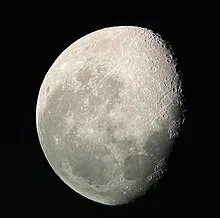
The Moon from Earth
The Moon is Earth (Öffnet in neuem Fenster)'s only proper (Öffnet in neuem Fenster) natural satellite (Öffnet in neuem Fenster). At one-quarter the diameter of Earth (comparable to the width of Australia (Öffnet in neuem Fenster)),[13] (Öffnet in neuem Fenster) it is the largest natural satellite in the Solar System (Öffnet in neuem Fenster) relative to the size of its planet, and the fifth largest satellite (Öffnet in neuem Fenster) in the Solar System overall (larger than any dwarf planet (Öffnet in neuem Fenster)). Orbiting Earth at an average lunar distance (Öffnet in neuem Fenster) of 384,400 km (238,900 mi),[14] (Öffnet in neuem Fenster) or about 30 times Earth's diameter, its gravitational influence is the main driver of Earth's tides (Öffnet in neuem Fenster) and slightly lengthens (Öffnet in neuem Fenster) Earth's day. The Moon is classified as a planetary-mass object (Öffnet in neuem Fenster) and a differentiated (Öffnet in neuem Fenster) rocky (Öffnet in neuem Fenster) body, and lacks any significant atmosphere (Öffnet in neuem Fenster), hydrosphere (Öffnet in neuem Fenster), or magnetic field (Öffnet in neuem Fenster). Its surface gravity is about one-sixth of Earth's (0.1654 g (Öffnet in neuem Fenster)); Jupiter (Öffnet in neuem Fenster)'s moon Io (Öffnet in neuem Fenster) is the only satellite in the Solar System known to have a higher surface gravity and density.
The Moon's orbit (Öffnet in neuem Fenster) around Earth has a sidereal period (Öffnet in neuem Fenster) of 27.3 days, and a synodic period (Öffnet in neuem Fenster) of 29.5 days. The synodic period drives its lunar phases (Öffnet in neuem Fenster), which form the basis for the months of a lunar calendar (Öffnet in neuem Fenster). The Moon is tidally locked (Öffnet in neuem Fenster) to Earth, which means that the length of a full rotation of the Moon on its own axis (a lunar day (Öffnet in neuem Fenster)) is the same as the synodic period, resulting in its same side (the near side (Öffnet in neuem Fenster)) always facing Earth. That said, 59% of the total lunar surface can be seen from Earth through shifts in perspective (its libration (Öffnet in neuem Fenster)).[15] (Öffnet in neuem Fenster)
The near side of the Moon is marked by dark volcanic maria (Öffnet in neuem Fenster) ("seas"), which fill the spaces between bright ancient crustal highlands and prominent impact craters (Öffnet in neuem Fenster). The lunar surface is relatively non-reflective, with a reflectance (Öffnet in neuem Fenster) just slightly brighter than that of worn asphalt (Öffnet in neuem Fenster). However, because it reflects direct sunlight, is contrasted (Öffnet in neuem Fenster) by the relatively dark sky (Öffnet in neuem Fenster), and has a large apparent size (Öffnet in neuem Fenster) when viewed from Earth, the Moon is the brightest celestial object (Öffnet in neuem Fenster) in Earth's sky after the Sun (Öffnet in neuem Fenster). The Moon's apparent size is nearly the same as that of the Sun, allowing it to cover the Sun almost completely during a total solar eclipse (Öffnet in neuem Fenster).
The first manmade object to reach the Moon was the Soviet Union (Öffnet in neuem Fenster)'s Luna 2 (Öffnet in neuem Fenster) uncrewed spacecraft (Öffnet in neuem Fenster) in 1959; this was followed by the first successful soft landing by Luna 9 (Öffnet in neuem Fenster) in 1966. The only human lunar missions to date have been those of the United States (Öffnet in neuem Fenster)' NASA Apollo program (Öffnet in neuem Fenster), which conducted the first manned lunar orbiting mission with Apollo 8 (Öffnet in neuem Fenster) in 1968. Beginning with Apollo 11 (Öffnet in neuem Fenster), six human landings took place between 1969 and 1972. These and later uncrewed missions returned lunar rocks (Öffnet in neuem Fenster) which have been used to develop a detailed geological understanding (Öffnet in neuem Fenster) of the Moon's origins (Öffnet in neuem Fenster), internal structure (Öffnet in neuem Fenster), and subsequent history; the most widely accepted origin explanation posits that the Moon formed about 4.51 billion years ago, not long after Earth (Öffnet in neuem Fenster), out of the debris from a giant impact (Öffnet in neuem Fenster) between the planet and a hypothesized Mars (Öffnet in neuem Fenster)-sized body called Theia (Öffnet in neuem Fenster).
Both the Moon's natural prominence in the earthly sky and its regular cycle of phases (Öffnet in neuem Fenster) as seen from Earth have provided cultural references and influences for human societies and cultures throughout history. Such cultural influences can be found in language, calendar systems, art, and mythology.
Contents
3Physical characteristics (Öffnet in neuem Fenster)3.1Internal structure
(Öffnet in neuem Fenster)3.2Surface geology (Öffnet in neuem Fenster)3.2.1Volcanic features
(Öffnet in neuem Fenster)3.2.2Impact craters
(Öffnet in neuem Fenster)3.2.3Lunar swirls
(Öffnet in neuem Fenster)3.2.4Presence of water
(Öffnet in neuem Fenster)3.3Gravitational field
(Öffnet in neuem Fenster)3.4Magnetic field
(Öffnet in neuem Fenster)3.5Atmosphere (Öffnet in neuem Fenster)3.5.1Dust
(Öffnet in neuem Fenster)3.5.2Past thicker atmosphere
(Öffnet in neuem Fenster)3.6Seasons
(Öffnet in neuem Fenster)3.7Rotation
(Öffnet in neuem Fenster)4Earth–Moon system (Öffnet in neuem Fenster)4.1Lunar distance
(Öffnet in neuem Fenster)4.2Orbit
(Öffnet in neuem Fenster)4.3Relative size
(Öffnet in neuem Fenster)4.4Appearance from Earth
(Öffnet in neuem Fenster)4.5Tidal effects
(Öffnet in neuem Fenster)4.6Eclipses
(Öffnet in neuem Fenster)5Observation and exploration (Öffnet in neuem Fenster)5.1Before spaceflight
(Öffnet in neuem Fenster)5.21959–1970s (Öffnet in neuem Fenster)5.2.1Soviet missions
(Öffnet in neuem Fenster)5.2.2United States missions
(Öffnet in neuem Fenster)5.31970s – present
(Öffnet in neuem Fenster)5.4Future (Öffnet in neuem Fenster)5.4.1Planned commercial missions
(Öffnet in neuem Fenster)6Human presence (Öffnet in neuem Fenster)6.1Human impact
(Öffnet in neuem Fenster)6.2Infrastructure
(Öffnet in neuem Fenster)6.3Astronomy from the Moon
(Öffnet in neuem Fenster)6.4Living on the Moon
(Öffnet in neuem Fenster)8In culture (Öffnet in neuem Fenster)8.1Mythology
(Öffnet in neuem Fenster)8.2Calendar
(Öffnet in neuem Fenster)8.3Lunar effect
(Öffnet in neuem Fenster)10References (Öffnet in neuem Fenster)10.1Citations
(Öffnet in neuem Fenster)12External links (Öffnet in neuem Fenster)12.1Cartographic resources
(Öffnet in neuem Fenster)12.2Observation tools
(Öffnet in neuem Fenster)12.3General
(Öffnet in neuem Fenster)
Name and etymology
See also: List of lunar deities (Öffnet in neuem Fenster)
The Moon, tinted reddish, during a lunar eclipse (Öffnet in neuem Fenster)
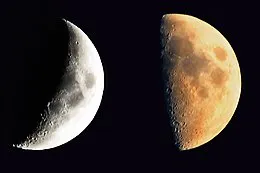
During the lunar phases (Öffnet in neuem Fenster), only portions of the Moon can be observed from Earth (Öffnet in neuem Fenster).
The usual English (Öffnet in neuem Fenster) proper name for Earth's natural satellite is simply the Moon, with a capital M.[16] (Öffnet in neuem Fenster)[17] (Öffnet in neuem Fenster) The noun moon is derived from Old English (Öffnet in neuem Fenster)mōna, which (like all its Germanic (Öffnet in neuem Fenster) cognates) stems from Proto-Germanic (Öffnet in neuem Fenster) *mēnōn,[18] (Öffnet in neuem Fenster) which in turn comes from Proto-Indo-European (Öffnet in neuem Fenster) *mēnsis"month"[19] (Öffnet in neuem Fenster) (from earlier *mēnōt, genitive *mēneses) which may be related to the verb "measure" (of time).[20] (Öffnet in neuem Fenster)
Occasionally, the name Luna /ˈluːnə/ (Öffnet in neuem Fenster) is used in scientific writing[21] (Öffnet in neuem Fenster) and especially in science fiction to distinguish the Earth's moon from others, while in poetry "Luna" has been used to denote personification of Earth's moon.[22] (Öffnet in neuem Fenster) Cynthia /ˈsɪnθiə/ (Öffnet in neuem Fenster) is another poetic name, though rare, for the Moon personified as a goddess,[23] (Öffnet in neuem Fenster) while Selene (Öffnet in neuem Fenster) /səˈliːniː/ (Öffnet in neuem Fenster) (literally "Moon") is the Greek goddess of the Moon.
The usual English adjective pertaining to the Moon is "lunar", derived from the Latin word for the Moon, lūna. The adjective selenian /səliːniən/ (Öffnet in neuem Fenster),[24] (Öffnet in neuem Fenster) derived from the Greek word for the Moon, σελήνη selēnē, and used to describe the Moon as a world rather than as an object in the sky, is rare,[25] (Öffnet in neuem Fenster) while its cognate selenic was originally a rare synonym[26] (Öffnet in neuem Fenster) but now nearly always refers to the chemical element selenium (Öffnet in neuem Fenster).[27] (Öffnet in neuem Fenster) The Greek word for the Moon does however provide us with the prefix seleno-, as in selenography (Öffnet in neuem Fenster), the study of the physical features of the Moon, as well as the element name selenium.[28] (Öffnet in neuem Fenster)[29] (Öffnet in neuem Fenster)
The Greek goddess of the wilderness and the hunt, Artemis (Öffnet in neuem Fenster), equated with the Roman Diana (Öffnet in neuem Fenster), one of whose symbols was the Moon and who was often regarded as the goddess of the Moon, was also called Cynthia (Öffnet in neuem Fenster), from her legendary birthplace on Mount Cynthus (Öffnet in neuem Fenster).[30] (Öffnet in neuem Fenster) These names – Luna, Cynthia and Selene – are reflected in technical terms for lunar orbits (Öffnet in neuem Fenster) such as apolune, pericynthion and selenocentric.
The Moon
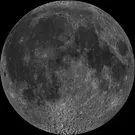
Near side of the Moon (Öffnet in neuem Fenster)
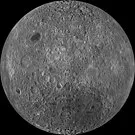
Far side of the Moon (Öffnet in neuem Fenster)

Lunar north pole (Öffnet in neuem Fenster)
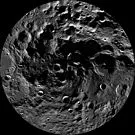
Lunar south pole (Öffnet in neuem Fenster)
Formation
Main articles: Origin of the Moon (Öffnet in neuem Fenster), Giant-impact hypothesis (Öffnet in neuem Fenster), and Circumplanetary disk (Öffnet in neuem Fenster)
The Moon formed 4.51 billion years ago,[f] (Öffnet in neuem Fenster) or even 100 million years earlier, some 50 million years after the origin of the Solar System, as research published in 2019 suggests.[31] (Öffnet in neuem Fenster) Several forming mechanisms have been proposed,[32] (Öffnet in neuem Fenster) including the fission of the Moon from Earth's crust through centrifugal force (Öffnet in neuem Fenster)[33] (Öffnet in neuem Fenster) (which would require too great an initial rotation rate of Earth),[34] (Öffnet in neuem Fenster) the gravitational capture of a pre-formed Moon[35] (Öffnet in neuem Fenster) (which would require an unfeasibly extended atmosphere of Earth (Öffnet in neuem Fenster) to dissipate (Öffnet in neuem Fenster) the energy of the passing Moon),[34] (Öffnet in neuem Fenster) and the co-formation of Earth and the Moon together in the primordial (Öffnet in neuem Fenster) accretion disk (Öffnet in neuem Fenster) (which does not explain the depletion of metals in the Moon).[34] (Öffnet in neuem Fenster) These hypotheses also cannot account for the high angular momentum (Öffnet in neuem Fenster) of the Earth–Moon system.[36] (Öffnet in neuem Fenster)
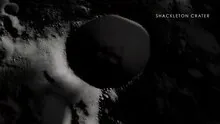
The evolution of the Moon and a tour of the Moon
The prevailing theory is that the Earth–Moon system formed after a giant impact (Öffnet in neuem Fenster) of a Mars (Öffnet in neuem Fenster)-sized body (named Theia (Öffnet in neuem Fenster)) with the proto-Earth (Öffnet in neuem Fenster). The impact blasted material into Earth's orbit and then the material accreted and formed the Moon.[37] (Öffnet in neuem Fenster)[38] (Öffnet in neuem Fenster)
This theory best explains the evidence. Eighteen months prior to an October 1984 conference on lunar origins, Bill Hartmann, Roger Phillips, and Jeff Taylor challenged fellow lunar scientists: "You have eighteen months. Go back to your Apollo data, go back to your computer, do whatever you have to, but make up your mind. Don't come to our conference unless you have something to say about the Moon's birth." At the 1984 conference at Kona, Hawaii, the giant-impact hypothesis emerged as the most consensual.
Before the conference, there were partisans of the three "traditional" theories, plus a few people who were starting to take the giant impact seriously, and there was a huge apathetic middle who didn't think the debate would ever be resolved. Afterward, there were essentially only two groups: the giant impact camp and the agnostics.[39] (Öffnet in neuem Fenster)
Giant impacts are thought to have been common in the early Solar System. Computer simulations of giant impacts have produced results that are consistent with the mass of the lunar core and the angular momentum of the Earth–Moon system. These simulations also show that most of the Moon derived from the impactor, rather than the proto-Earth.[40] (Öffnet in neuem Fenster) However, more recent simulations suggest a larger fraction of the Moon derived from the proto-Earth.[41] (Öffnet in neuem Fenster)[42] (Öffnet in neuem Fenster)[43] (Öffnet in neuem Fenster)[44] (Öffnet in neuem Fenster) Other bodies of the inner Solar System such as Mars and Vesta (Öffnet in neuem Fenster) have, according to meteorites from them, very different oxygen and tungsten isotopic (Öffnet in neuem Fenster) compositions compared to Earth. However, Earth and the Moon have nearly identical isotopic compositions. The isotopic equalization of the Earth-Moon system might be explained by the post-impact mixing of the vaporized material that formed the two,[45] (Öffnet in neuem Fenster) although this is debated.[46] (Öffnet in neuem Fenster)
The impact released a lot of energy and then the released material re-accreted into the Earth–Moon system. This would have melted the outer shell of Earth, and thus formed a magma ocean.[47] (Öffnet in neuem Fenster)[48] (Öffnet in neuem Fenster) Similarly, the newly formed Moon would also have been affected and had its own lunar magma ocean (Öffnet in neuem Fenster); its depth is estimated from about 500 km (300 miles) to 1,737 km (1,079 miles).[47] (Öffnet in neuem Fenster)
While the giant-impact theory explains many lines of evidence, some questions are still unresolved, most of which involve the Moon's composition.[49] (Öffnet in neuem Fenster)
Oceanus Procellarum (Öffnet in neuem Fenster) ("Ocean of Storms")
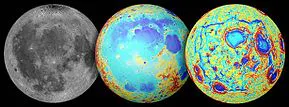
Ancient rift valleys (Öffnet in neuem Fenster) – rectangular structure (visible – topography – GRAIL gravity gradients (Öffnet in neuem Fenster))
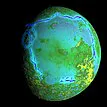
Ancient rift valleys (Öffnet in neuem Fenster)– context
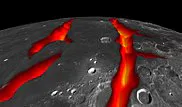
Ancient rift valleys (Öffnet in neuem Fenster) – closeup (artist's concept)
In 2001, a team at the Carnegie Institute of Washington reported the most precise measurement of the isotopic signatures (Öffnet in neuem Fenster) of lunar rocks.[50] (Öffnet in neuem Fenster) The rocks from the Apollo program had the same isotopic signature as rocks from Earth, differing from almost all other bodies in the Solar System. This observation was unexpected, because most of the material that formed the Moon was thought to come from Theia (Öffnet in neuem Fenster) and it was announced in 2007 that there was less than a 1% chance that Theia and Earth had identical isotopic signatures.[51] (Öffnet in neuem Fenster) Other Apollo lunar samples had in 2012 the same titanium isotopes composition as Earth,[52] (Öffnet in neuem Fenster) which conflicts (Öffnet in neuem Fenster) with what is expected if the Moon formed far from Earth or is derived from Theia. These discrepancies may be explained by variations of the giant-impact theory.
Physical characteristics
The Moon is a very slightly scalene ellipsoid (Öffnet in neuem Fenster) due to tidal stretching, with its long axis displaced 30° from facing the Earth (due to gravitational anomalies from impact basins). Its shape is more elongated than current tidal forces can account for. This 'fossil bulge' indicates that the Moon solidified when it orbited at half its current distance to the Earth, and that it is now too cold for its shape to adjust to its orbit.[53] (Öffnet in neuem Fenster)
Internal structure
Main article: Internal structure of the Moon (Öffnet in neuem Fenster)
Lunar surface chemical composition[54] (Öffnet in neuem Fenster)CompoundFormulaCompositionMariaHighlandssilica (Öffnet in neuem Fenster)SiO245.4%45.5%alumina (Öffnet in neuem Fenster)Al2O314.9%24.0%lime (Öffnet in neuem Fenster)CaO11.8%15.9%iron(II) oxide (Öffnet in neuem Fenster)FeO14.1%5.9%magnesia (Öffnet in neuem Fenster)MgO9.2%7.5%titanium dioxide (Öffnet in neuem Fenster)TiO23.9%0.6%sodium oxide (Öffnet in neuem Fenster)Na2O0.6%0.6% 99.9%100.0%
The Moon is a differentiated (Öffnet in neuem Fenster) body. It has a geochemically (Öffnet in neuem Fenster) distinct crust (Öffnet in neuem Fenster), mantle (Öffnet in neuem Fenster), and core (Öffnet in neuem Fenster). The Moon has a solid iron-rich inner core with a radius possibly as small as 240 kilometres (150 mi) and a fluid outer core primarily made of liquid iron with a radius of roughly 300 kilometres (190 mi). Around the core is a partially molten boundary layer with a radius of about 500 kilometres (310 mi).[55] (Öffnet in neuem Fenster)[56] (Öffnet in neuem Fenster) This structure is thought to have developed through the fractional crystallization (Öffnet in neuem Fenster) of a global magma ocean shortly after the Moon's formation 4.5 billion years ago.[57] (Öffnet in neuem Fenster)
Crystallization of this magma ocean would have created a mafic (Öffnet in neuem Fenster) mantle from the precipitation (Öffnet in neuem Fenster) and sinking of the minerals olivine (Öffnet in neuem Fenster), clinopyroxene (Öffnet in neuem Fenster), and orthopyroxene (Öffnet in neuem Fenster); after about three-quarters of the magma ocean had crystallised, lower-density plagioclase (Öffnet in neuem Fenster) minerals could form and float into a crust atop.[58] (Öffnet in neuem Fenster) The final liquids to crystallise would have been initially sandwiched between the crust and mantle, with a high abundance of incompatible (Öffnet in neuem Fenster) and heat-producing elements.[1] (Öffnet in neuem Fenster)
Consistent with this perspective, geochemical mapping made from orbit suggests the crust of mostly anorthosite (Öffnet in neuem Fenster).[12] (Öffnet in neuem Fenster) The Moon rock (Öffnet in neuem Fenster) samples of the flood lavas that erupted onto the surface from partial melting in the mantle confirm the mafic mantle composition, which is more iron-rich than that of Earth.[1] (Öffnet in neuem Fenster) The crust is on average about 50 kilometres (31 mi) thick.[1] (Öffnet in neuem Fenster)
The Moon is the second-densest satellite in the Solar System, after Io (Öffnet in neuem Fenster).[59] (Öffnet in neuem Fenster) However, the inner core of the Moon is small, with a radius of about 350 kilometres (220 mi) or less,[1] (Öffnet in neuem Fenster) around 20% of the radius of the Moon. Its composition is not well understood, but is probably metallic iron alloyed with a small amount of sulfur and nickel; analyses of the Moon's time-variable rotation suggest that it is at least partly molten.[60] (Öffnet in neuem Fenster)
Surface geology
Main articles: Topography of the Moon (Öffnet in neuem Fenster), Geology of the Moon (Öffnet in neuem Fenster), Moon rock (Öffnet in neuem Fenster), and List of lunar features (Öffnet in neuem Fenster)

The Topographic Globe of the Moon

Geological features of the Moon (near side / north pole at left, far side / south pole at right)
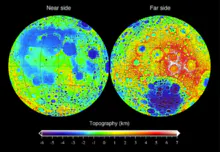
Topography of the Moon
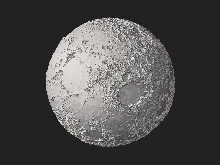
STL 3D model (Öffnet in neuem Fenster) of the Moon with 10× elevation exaggeration rendered with data from the Lunar Orbiter Laser Altimeter of the Lunar Reconnaissance Orbiter (Öffnet in neuem Fenster)
The topography of the Moon (Öffnet in neuem Fenster) has been measured with laser altimetry (Öffnet in neuem Fenster) and stereo image analysis (Öffnet in neuem Fenster).[61] (Öffnet in neuem Fenster) Its most visible topographic feature (Öffnet in neuem Fenster) is the giant far-side South Pole–Aitken basin (Öffnet in neuem Fenster), some 2,240 km (1,390 mi) in diameter, the largest crater on the Moon and the second-largest confirmed impact crater in the Solar System (Öffnet in neuem Fenster).[62] (Öffnet in neuem Fenster)[63] (Öffnet in neuem Fenster) At 13 km (8.1 mi) deep, its floor is the lowest point on the surface of the Moon.[62] (Öffnet in neuem Fenster)[64] (Öffnet in neuem Fenster) The highest elevations of the surface are located directly to the northeast, and it has been suggested might have been thickened by the oblique formation impact of the South Pole–Aitken basin.[65] (Öffnet in neuem Fenster) Other large impact basins such as Imbrium (Öffnet in neuem Fenster), Serenitatis (Öffnet in neuem Fenster), Crisium (Öffnet in neuem Fenster), Smythii (Öffnet in neuem Fenster), and Orientale (Öffnet in neuem Fenster) also possess regionally low elevations and elevated rims.[62] (Öffnet in neuem Fenster) The far side of the lunar surface is on average about 1.9 km (1.2 mi) higher than that of the near side.[1] (Öffnet in neuem Fenster)
The discovery of fault scarp (Öffnet in neuem Fenster) cliffs by the Lunar Reconnaissance Orbiter (Öffnet in neuem Fenster) suggest that the Moon has shrunk within the past billion years, by about 90 metres (300 ft).[66] (Öffnet in neuem Fenster) Similar shrinkage features exist on Mercury (Öffnet in neuem Fenster). A recent study of over 12000 images from the orbiter has observed that Mare Frigoris near the north pole, a vast basin assumed to be geologically dead, has been cracking and shifting. Since the Moon doesn't have tectonic plates, its tectonic activity is slow and cracks develop as it loses heat over the years.[67] (Öffnet in neuem Fenster)
Volcanic features
Main article: Volcanism on the Moon (Öffnet in neuem Fenster)
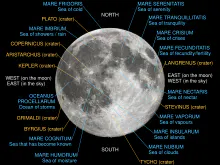
Lunar nearside (Öffnet in neuem Fenster) with major maria (Öffnet in neuem Fenster) and craters (Öffnet in neuem Fenster) labeled
The dark and relatively featureless lunar plains, clearly seen with the naked eye, are called maria (Öffnet in neuem Fenster) (Latin (Öffnet in neuem Fenster) for "seas"; singular mare), as they were once believed to be filled with water;[68] (Öffnet in neuem Fenster) they are now known to be vast solidified pools of ancient basaltic (Öffnet in neuem Fenster) lava. Although similar to terrestrial basalts, lunar basalts have more iron and no minerals altered by water.[69] (Öffnet in neuem Fenster) The majority of these lavas erupted or flowed into the depressions associated with impact basins (Öffnet in neuem Fenster). Several geologic provinces (Öffnet in neuem Fenster) containing shield volcanoes (Öffnet in neuem Fenster) and volcanic domes (Öffnet in neuem Fenster) are found within the near side "maria".[70] (Öffnet in neuem Fenster)

Evidence of young lunar volcanism (Öffnet in neuem Fenster)
Almost all maria are on the near side of the Moon, and cover 31% of the surface of the near side,[71] (Öffnet in neuem Fenster) compared with 2% of the far side.[72] (Öffnet in neuem Fenster) This is thought to be due to a concentration of heat-producing elements (Öffnet in neuem Fenster) under the crust on the near side, seen on geochemical maps obtained by Lunar Prospector (Öffnet in neuem Fenster)'s gamma-ray spectrometer, which would have caused the underlying mantle to heat up, partially melt, rise to the surface and erupt.[58] (Öffnet in neuem Fenster)[73] (Öffnet in neuem Fenster)[74] (Öffnet in neuem Fenster) Most of the Moon's mare basalts (Öffnet in neuem Fenster) erupted during the Imbrian period, 3.0–3.5 billion years ago, although some radiometrically dated samples are as old as 4.2 billion years.[75] (Öffnet in neuem Fenster) Until recently, the youngest eruptions, dated by crater counting (Öffnet in neuem Fenster), appeared to have been only 1.2 billion years ago.[76] (Öffnet in neuem Fenster) In 2006, a study of Ina (Öffnet in neuem Fenster), a tiny depression in Lacus Felicitatis (Öffnet in neuem Fenster), found jagged, relatively dust-free features that, because of the lack of erosion by infalling debris, appeared to be only 2 million years old.[77] (Öffnet in neuem Fenster) Moonquakes (Öffnet in neuem Fenster) and releases of gas also indicate some continued lunar activity.[77] (Öffnet in neuem Fenster) In 2014 NASA announced "widespread evidence of young lunar volcanism" at 70 irregular mare patches (Öffnet in neuem Fenster) identified by the Lunar Reconnaissance Orbiter, some less than 50 million years old. This raises the possibility of a much warmer lunar mantle than previously believed, at least on the near side where the deep crust is substantially warmer because of the greater concentration of radioactive elements.[78] (Öffnet in neuem Fenster)[79] (Öffnet in neuem Fenster)[80] (Öffnet in neuem Fenster)[81] (Öffnet in neuem Fenster) Just prior to this, evidence has been presented for 2–10 million years younger basaltic volcanism inside the crater Lowell,[82] (Öffnet in neuem Fenster)[83] (Öffnet in neuem Fenster) Orientale basin, located in the transition zone between the near and far sides of the Moon. An initially hotter mantle and/or local enrichment of heat-producing elements in the mantle could be responsible for prolonged activities also on the far side in the Orientale basin.[84] (Öffnet in neuem Fenster)[85] (Öffnet in neuem Fenster)
The lighter-colored regions of the Moon are called terrae, or more commonly highlands, because they are higher than most maria. They have been radiometrically dated to having formed 4.4 billion years ago, and may represent plagioclase (Öffnet in neuem Fenster)cumulates (Öffnet in neuem Fenster) of the lunar magma ocean.[75] (Öffnet in neuem Fenster)[76] (Öffnet in neuem Fenster) In contrast to Earth, no major lunar mountains are believed to have formed as a result of tectonic events.[86] (Öffnet in neuem Fenster)
The concentration of maria on the Near Side likely reflects the substantially thicker crust of the highlands of the Far Side, which may have formed in a slow-velocity impact of a second moon of Earth a few tens of millions of years after their formation.[87] (Öffnet in neuem Fenster)[88] (Öffnet in neuem Fenster)
Impact craters
Further information: List of craters on the Moon (Öffnet in neuem Fenster)
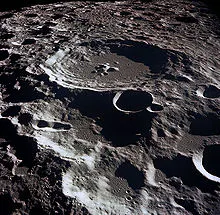
Lunar crater Daedalus (Öffnet in neuem Fenster) on the Moon's far side (Öffnet in neuem Fenster)
The other major geologic process that has affected the Moon's surface is impact cratering (Öffnet in neuem Fenster),[89] (Öffnet in neuem Fenster) with craters formed when asteroids and comets collide with the lunar surface. There are estimated to be roughly 300,000 craters wider than 1 km (0.6 mi) on the Moon's near side alone.[90] (Öffnet in neuem Fenster) The lunar geologic timescale (Öffnet in neuem Fenster) is based on the most prominent impact events, including Nectaris (Öffnet in neuem Fenster), Imbrium (Öffnet in neuem Fenster), and Orientale (Öffnet in neuem Fenster), structures characterized by multiple rings of uplifted material, between hundreds and thousands of kilometers in diameter and associated with a broad apron of ejecta deposits that form a regional stratigraphic horizon (Öffnet in neuem Fenster).[91] (Öffnet in neuem Fenster) The lack of an atmosphere, weather and recent geological processes mean that many of these craters are well-preserved. Although only a few multi-ring basins (Öffnet in neuem Fenster) have been definitively dated, they are useful for assigning relative ages. Because impact craters accumulate at a nearly constant rate, counting the number of craters per unit area can be used to estimate the age of the surface.[91] (Öffnet in neuem Fenster) The radiometric ages of impact-melted rocks collected during the Apollo missions (Öffnet in neuem Fenster) cluster between 3.8 and 4.1 billion years old: this has been used to propose a Late Heavy Bombardment (Öffnet in neuem Fenster) of impacts.[92] (Öffnet in neuem Fenster)
Blanketed on top of the Moon's crust is a highly comminuted (Öffnet in neuem Fenster) (broken into ever smaller particles) and impact gardened (Öffnet in neuem Fenster) surface layer called regolith (Öffnet in neuem Fenster), formed by impact processes. The finer regolith, the lunar soil (Öffnet in neuem Fenster) of silicon dioxide (Öffnet in neuem Fenster) glass, has a texture resembling snow and a scent resembling spent gunpowder (Öffnet in neuem Fenster).[93] (Öffnet in neuem Fenster)The regolith of older surfaces is generally thicker than for younger surfaces: it varies in thickness from 10–20 km (6.2–12.4 mi) in the highlands and 3–5 km (1.9–3.1 mi) in the maria.[94] (Öffnet in neuem Fenster) Beneath the finely comminuted regolith layer is the megaregolith, a layer of highly fractured bedrock many kilometers thick.[95] (Öffnet in neuem Fenster)
Comparison of high-resolution images obtained by the Lunar Reconnaissance Orbiter has shown a contemporary crater-production rate significantly higher than previously estimated. A secondary cratering process caused by distal ejecta (Öffnet in neuem Fenster) is thought to churn the top two centimeters of regolith a hundred times more quickly than previous models suggested – on a timescale of 81,000 years.[96] (Öffnet in neuem Fenster)[97] (Öffnet in neuem Fenster)

Lunar swirls at Reiner Gamma (Öffnet in neuem Fenster)
Lunar swirls
Main article: Lunar swirls (Öffnet in neuem Fenster)
Lunar swirls are enigmatic features found across the Moon's surface. They are characterized by a high albedo, appear optically immature (i.e. the optical characteristics of a relatively young regolith), and have often a sinuous shape. Their shape is often accentuated by low albedo regions that wind between the bright swirls.
Presence of water
Main article: Lunar water (Öffnet in neuem Fenster)
Liquid water cannot persist on the lunar surface. When exposed to solar radiation, water quickly decomposes through a process known as photodissociation (Öffnet in neuem Fenster) and is lost to space. However, since the 1960s, scientists have hypothesized that water ice may be deposited by impacting comets (Öffnet in neuem Fenster) or possibly produced by the reaction of oxygen-rich lunar rocks, and hydrogen from solar wind (Öffnet in neuem Fenster), leaving traces of water which could possibly persist in cold, permanently shadowed craters at either pole on the Moon.[98] (Öffnet in neuem Fenster)[99] (Öffnet in neuem Fenster) Computer simulations suggest that up to 14,000 km2 (5,400 sq mi) of the surface may be in permanent shadow.[100] (Öffnet in neuem Fenster) The presence of usable quantities of water on the Moon is an important factor in rendering lunar habitation (Öffnet in neuem Fenster) as a cost-effective plan; the alternative of transporting water from Earth would be prohibitively expensive.[101] (Öffnet in neuem Fenster)
In years since, signatures of water have been found to exist on the lunar surface.[102] (Öffnet in neuem Fenster) In 1994, the bistatic radar experiment (Öffnet in neuem Fenster) located on the Clementine (Öffnet in neuem Fenster) spacecraft, indicated the existence of small, frozen pockets of water close to the surface. However, later radar observations by Arecibo (Öffnet in neuem Fenster), suggest these findings may rather be rocks ejected from young impact craters.[103] (Öffnet in neuem Fenster) In 1998, the neutron spectrometer (Öffnet in neuem Fenster) on the Lunar Prospector spacecraft showed that high concentrations of hydrogen are present in the first meter of depth in the regolith near the polar regions.[104] (Öffnet in neuem Fenster) Volcanic lava beads, brought back to Earth aboard Apollo 15, showed small amounts of water in their interior.[105] (Öffnet in neuem Fenster)
The 2008 Chandrayaan-1 (Öffnet in neuem Fenster) spacecraft has since confirmed the existence of surface water ice, using the on-board Moon Mineralogy Mapper (Öffnet in neuem Fenster). The spectrometer observed absorption lines common to hydroxyl (Öffnet in neuem Fenster), in reflected sunlight, providing evidence of large quantities of water ice, on the lunar surface. The spacecraft showed that concentrations may possibly be as high as 1,000 ppm (Öffnet in neuem Fenster).[106] (Öffnet in neuem Fenster) Using the mapper's reflectance spectra, indirect lighting of areas in shadow confirmed water ice within 20° latitude of both poles in 2018.[107] (Öffnet in neuem Fenster) In 2009, LCROSS (Öffnet in neuem Fenster) sent a 2,300 kg (5,100 lb) impactor into a permanently shadowed (Öffnet in neuem Fenster) polar crater, and detected at least 100 kg (220 lb) of water in a plume of ejected material.[108] (Öffnet in neuem Fenster)[109] (Öffnet in neuem Fenster) Another examination of the LCROSS data showed the amount of detected water to be closer to 155 ± 12 kg (342 ± 26 lb).[110] (Öffnet in neuem Fenster)
In May 2011, 615–1410 ppm water in melt inclusions (Öffnet in neuem Fenster) in lunar sample 74220 was reported,[111] (Öffnet in neuem Fenster) the famous high-titanium "orange glass soil" of volcanic origin collected during the Apollo 17 (Öffnet in neuem Fenster) mission in 1972. The inclusions were formed during explosive eruptions on the Moon approximately 3.7 billion years ago. This concentration is comparable with that of magma in Earth's upper mantle (Öffnet in neuem Fenster). Although of considerable selenological interest, this announcement affords little comfort to would-be lunar colonists – the sample originated many kilometers below the surface, and the inclusions are so difficult to access that it took 39 years to find them with a state-of-the-art ion microprobe instrument.
Analysis of the findings of the Moon Mineralogy Mapper (M3) revealed in August 2018 for the first time "definitive evidence" for water-ice on the lunar surface.[112] (Öffnet in neuem Fenster)[113] (Öffnet in neuem Fenster) The data revealed the distinct reflective signatures of water-ice, as opposed to dust and other reflective substances.[114] (Öffnet in neuem Fenster) The ice deposits were found on the North and South poles, although it is more abundant in the South, where water is trapped in permanently shadowed craters and crevices, allowing it to persist as ice on the surface since they are shielded from the sun.[112] (Öffnet in neuem Fenster)[114] (Öffnet in neuem Fenster)
In October 2020, astronomers reported detecting molecular water (Öffnet in neuem Fenster) on the sunlit surface of the Moon by several independent spacecraft, including the Stratospheric Observatory for Infrared Astronomy (Öffnet in neuem Fenster) (SOFIA).[115] (Öffnet in neuem Fenster)[116] (Öffnet in neuem Fenster)[117] (Öffnet in neuem Fenster)[118] (Öffnet in neuem Fenster)
Gravitational field
Main article: Gravity of the Moon (Öffnet in neuem Fenster)
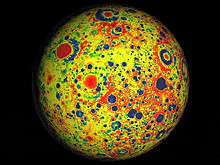
GRAIL (Öffnet in neuem Fenster)'s gravity map of the Moon
The gravitational field (Öffnet in neuem Fenster) of the Moon has been measured through tracking the Doppler shift (Öffnet in neuem Fenster) of radio signals emitted by orbiting spacecraft. The main lunar gravity features are mascons (Öffnet in neuem Fenster), large positive gravitational anomalies associated with some of the giant impact basins, partly caused by the dense mare basaltic lava flows that fill those basins.[119] (Öffnet in neuem Fenster)[120] (Öffnet in neuem Fenster) The anomalies greatly influence the orbit of spacecraft about the Moon. There are some puzzles: lava flows by themselves cannot explain all of the gravitational signature, and some mascons exist that are not linked to mare volcanism.[121] (Öffnet in neuem Fenster)
Magnetic field
Main article: Magnetic field of the Moon (Öffnet in neuem Fenster)
The Moon has an external magnetic field (Öffnet in neuem Fenster) of generally less than 0.2 nanoteslas (Öffnet in neuem Fenster),[122] (Öffnet in neuem Fenster) or less than one hundred thousandth that of Earth (Öffnet in neuem Fenster). The Moon does not currently have a global dipolar (Öffnet in neuem Fenster) magnetic field and only has crustal magnetization likely acquired early in its history when a dynamo was still operating.[123] (Öffnet in neuem Fenster)[124] (Öffnet in neuem Fenster) However, early in its history, 4 billion years ago, its magnetic field strength was likely close to that of Earth today.[122] (Öffnet in neuem Fenster) This early dynamo field apparently expired by about one billion years ago, after the lunar core had completely crystallized.[122] (Öffnet in neuem Fenster) Theoretically, some of the remnant magnetization may originate from transient magnetic fields generated during large impacts through the expansion of plasma clouds. These clouds are generated during large impacts in an ambient magnetic field. This is supported by the location of the largest crustal magnetizations situated near the antipodes (Öffnet in neuem Fenster) of the giant impact basins.[125] (Öffnet in neuem Fenster)
Atmosphere
Main article: Atmosphere of the Moon (Öffnet in neuem Fenster)
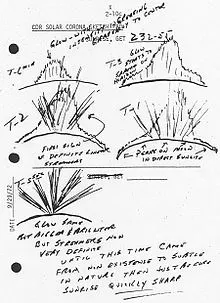
Sketch by the Apollo 17 astronauts. The lunar atmosphere was later studied by LADEE (Öffnet in neuem Fenster).[126] (Öffnet in neuem Fenster)[127] (Öffnet in neuem Fenster)
The Moon has an atmosphere (Öffnet in neuem Fenster) so tenuous as to be nearly vacuum (Öffnet in neuem Fenster), with a total mass of less than 10 tonnes (9.8 long tons; 11 short tons).[128] (Öffnet in neuem Fenster) The surface pressure of this small mass is around 3 × 10−15 atm (Öffnet in neuem Fenster) (0.3 nPa (Öffnet in neuem Fenster)); it varies with the lunar day. Its sources include outgassing (Öffnet in neuem Fenster) and sputtering (Öffnet in neuem Fenster), a product of the bombardment of lunar soil by solar wind ions.[12] (Öffnet in neuem Fenster)[129] (Öffnet in neuem Fenster) Elements that have been detected include sodium (Öffnet in neuem Fenster) and potassium (Öffnet in neuem Fenster), produced by sputtering (also found in the atmospheres of Mercury (Öffnet in neuem Fenster) and Io (Öffnet in neuem Fenster)); helium-4 (Öffnet in neuem Fenster) and neon (Öffnet in neuem Fenster)[130] (Öffnet in neuem Fenster) from the solar wind; and argon-40 (Öffnet in neuem Fenster), radon-222 (Öffnet in neuem Fenster), and polonium-210 (Öffnet in neuem Fenster), outgassed after their creation by radioactive decay (Öffnet in neuem Fenster) within the crust and mantle.[131] (Öffnet in neuem Fenster)[132] (Öffnet in neuem Fenster) The absence of such neutral species (atoms or molecules) as oxygen (Öffnet in neuem Fenster), nitrogen (Öffnet in neuem Fenster), carbon (Öffnet in neuem Fenster), hydrogen (Öffnet in neuem Fenster) and magnesium (Öffnet in neuem Fenster), which are present in the regolith (Öffnet in neuem Fenster), is not understood.[131] (Öffnet in neuem Fenster) Water vapor has been detected by Chandrayaan-1 (Öffnet in neuem Fenster) and found to vary with latitude, with a maximum at ~60–70 degrees; it is possibly generated from the sublimation (Öffnet in neuem Fenster) of water ice in the regolith.[133] (Öffnet in neuem Fenster) These gases either return into the regolith because of the Moon's gravity or are lost to space, either through solar radiation pressure or, if they are ionized, by being swept away by the solar wind's magnetic field.[131] (Öffnet in neuem Fenster)
Dust
A permanent asymmetric Moon dust (Öffnet in neuem Fenster) cloud exists around the Moon, created by small particles from comets. Estimates are 5 tons of comet particles strike the Moon's surface every 24 hours. The particles striking the Moon's surface eject Moon dust above the Moon. The dust stays above the Moon approximately 10 minutes, taking 5 minutes to rise, and 5 minutes to fall. On average, 120 kilograms of dust are present above the Moon, rising to 100 kilometers above the surface. The dust measurements were made by LADEE (Öffnet in neuem Fenster)'s Lunar Dust EXperiment (LDEX), between 20 and 100 kilometers above the surface, during a six-month period. LDEX detected an average of one 0.3 micrometer Moon dust particle each minute. Dust particle counts peaked during the Geminid (Öffnet in neuem Fenster), Quadrantid (Öffnet in neuem Fenster), Northern Taurid (Öffnet in neuem Fenster), and Omicron Centaurid (Öffnet in neuem Fenster) meteor showers (Öffnet in neuem Fenster), when the Earth, and Moon, pass through comet debris. The cloud is asymmetric, more dense near the boundary between the Moon's dayside and nightside.[134] (Öffnet in neuem Fenster)[135] (Öffnet in neuem Fenster)
Past thicker atmosphere
In October 2017, NASA scientists at the Marshall Space Flight Center (Öffnet in neuem Fenster) and the Lunar and Planetary Institute (Öffnet in neuem Fenster) in Houston (Öffnet in neuem Fenster) announced their finding, based on studies of Moon magma samples retrieved by the Apollo (Öffnet in neuem Fenster) missions, that the Moon had once possessed a relatively thick atmosphere for a period of 70 million years between 3 and 4 billion years ago. This atmosphere, sourced from gases ejected from lunar volcanic eruptions, was twice the thickness of that of present-day Mars (Öffnet in neuem Fenster). The ancient lunar atmosphere was eventually stripped away by solar winds and dissipated into space.[136] (Öffnet in neuem Fenster)
Seasons
The Moon's axial tilt (Öffnet in neuem Fenster) with respect to the ecliptic (Öffnet in neuem Fenster) is only 1.5424°,[137] (Öffnet in neuem Fenster) much less than the 23.44° of Earth. Because of this, the Moon's solar illumination varies much less with season, and topographical details play a crucial role in seasonal effects.[138] (Öffnet in neuem Fenster) From images taken by Clementine (Öffnet in neuem Fenster) in 1994, it appears that four mountainous regions on the rim of the crater Peary (Öffnet in neuem Fenster) at the Moon's north pole may remain illuminated for the entire lunar day (Öffnet in neuem Fenster), creating peaks of eternal light (Öffnet in neuem Fenster). No such regions exist at the south pole. Similarly, there are places that remain in permanent shadow at the bottoms of many polar craters,[100] (Öffnet in neuem Fenster) and these "craters of eternal darkness (Öffnet in neuem Fenster)" are extremely cold: Lunar Reconnaissance Orbiter measured the lowest summer temperatures in craters at the southern pole at 35 K (−238 °C; −397 °F)[139] (Öffnet in neuem Fenster) and just 26 K (−247 °C; −413 °F) close to the winter solstice in the north polar crater Hermite (Öffnet in neuem Fenster). This is the coldest temperature in the Solar System ever measured by a spacecraft, colder even than the surface of Pluto (Öffnet in neuem Fenster).[138] (Öffnet in neuem Fenster) Average temperatures of the Moon's surface are reported, but temperatures of different areas will vary greatly depending upon whether they are in sunlight or shadow.[140] (Öffnet in neuem Fenster)
Rotation
The Moon is rotating around its own axis. This rotation is due to tidal locking (Öffnet in neuem Fenster) synchronous to its orbital period (Öffnet in neuem Fenster) around Earth.
The rotation period (Öffnet in neuem Fenster) depends on the frame of reference. There are sidereal rotation periods (or sidereal day (Öffnet in neuem Fenster), in relation to the stars), and synodic rotation periods (or synodic day (Öffnet in neuem Fenster), in relation to the Sun). A lunar day (Öffnet in neuem Fenster) is a synodic day.
Because of the tidal locked rotation, the sidereal and synodic rotation periods correspond to the sidereal (27.3 Earth days) and synodic (29.5 Earth days) orbital periods.[141] (Öffnet in neuem Fenster)
Earth–Moon system
See also: Satellite system (astronomy) (Öffnet in neuem Fenster) and Other moons of Earth (Öffnet in neuem Fenster)
Lunar distance
Main article: Lunar distance (astronomy) (Öffnet in neuem Fenster)
This section is an excerpt from Lunar distance (astronomy) (Öffnet in neuem Fenster)[edit (Öffnet in neuem Fenster)]
Lunar distance (Öffnet in neuem Fenster) (LD or 
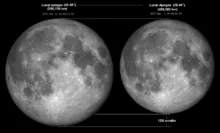 A lunar distance, 384402 km (Öffnet in neuem Fenster), is the Moon's average distance to Earth. The actual distance varies over the course of its orbit (Öffnet in neuem Fenster). The image compares the Moon's apparent size (Öffnet in neuem Fenster) when it is closest (Öffnet in neuem Fenster)and farthest from Earth.
A lunar distance, 384402 km (Öffnet in neuem Fenster), is the Moon's average distance to Earth. The actual distance varies over the course of its orbit (Öffnet in neuem Fenster). The image compares the Moon's apparent size (Öffnet in neuem Fenster) when it is closest (Öffnet in neuem Fenster)and farthest from Earth.
 Scale model (Öffnet in neuem Fenster) of the Earth–Moon system: Sizes and distances are to scale.
Scale model (Öffnet in neuem Fenster) of the Earth–Moon system: Sizes and distances are to scale.

Minimum, mean and maximum distances of the Moon from Earth with its angular diameter as seen from Earth's surface, to scale
Orbit
Main articles: Orbit of the Moon (Öffnet in neuem Fenster) and Lunar theory (Öffnet in neuem Fenster)
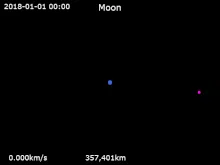
Animation of Moon's orbit around Earth from 2018 to 2027
Moon · Earth (Öffnet in neuem Fenster)
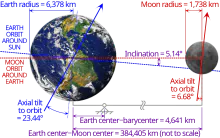
Earth–Moon system (schematic)

DSCOVR satellite (Öffnet in neuem Fenster) sees the Moon passing in front of Earth
The Moon makes a complete orbit around Earth with respect to the fixed stars about once every 27.3 days[g] (Öffnet in neuem Fenster) (its sidereal period (Öffnet in neuem Fenster)). However, because Earth is moving in its orbit around the Sun at the same time, it takes slightly longer for the Moon to show the same phase (Öffnet in neuem Fenster) to Earth, which is about 29.5 days[h] (Öffnet in neuem Fenster) (its synodic period (Öffnet in neuem Fenster)).[71] (Öffnet in neuem Fenster) Unlike most satellites of other planets, the Moon orbits closer to the ecliptic plane (Öffnet in neuem Fenster) than to the planet's equatorial plane (Öffnet in neuem Fenster). The Moon's orbit is subtly perturbed (Öffnet in neuem Fenster) by the Sun and Earth in many small, complex and interacting ways. For example, the plane of the Moon's orbit gradually rotates (Öffnet in neuem Fenster) once every 18.61 years,[142] (Öffnet in neuem Fenster) which affects other aspects of lunar motion. These follow-on effects are mathematically described by Cassini's laws (Öffnet in neuem Fenster).[143] (Öffnet in neuem Fenster)
Relative size
The Moon is an exceptionally large natural satellite relative to Earth: Its diameter is more than a quarter and its mass is 1/81 of Earth's.[71] (Öffnet in neuem Fenster) It is the largest moon in the Solar System relative to the size of its planet,[i] (Öffnet in neuem Fenster) though Charon (Öffnet in neuem Fenster) is larger relative to the dwarf planet Pluto, at 1/9 Pluto's mass.[j] (Öffnet in neuem Fenster)[144] (Öffnet in neuem Fenster) The Earth and the Moon's barycentre (Öffnet in neuem Fenster), their common center of mass, is located 1,700 km (1,100 mi) (about a quarter of Earth's radius) beneath the Earth's surface.
The Earth revolves around the Earth-Moon barycentre once a sidereal month, with 1/81 the speed of the Moon, or about 12.5 metres (41 ft) per second. This motion is superimposed on the much larger revolution of the Earth around the Sun at a speed of about 30 kilometres (19 mi) per second.
The surface area of the Moon is slightly less than the areas of North and South America (Öffnet in neuem Fenster) combined.
Appearance from Earth
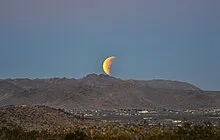
A full moon appears as a half moon during an eclipse moonset over the High Desert (Öffnet in neuem Fenster) in California, on the morning of the Trifecta: Full moon (Öffnet in neuem Fenster), Supermoon (Öffnet in neuem Fenster), Lunar eclipse (Öffnet in neuem Fenster), January 2018 lunar eclipse (Öffnet in neuem Fenster)
See also: Lunar observation (Öffnet in neuem Fenster), Lunar phase (Öffnet in neuem Fenster), Moonlight (Öffnet in neuem Fenster), and Earthlight (astronomy) (Öffnet in neuem Fenster)
The Moon is in synchronous rotation (Öffnet in neuem Fenster) as it orbits (Öffnet in neuem Fenster) Earth; it rotates about its axis in about the same time it takes to orbit Earth. This results in it always keeping nearly the same face turned towards Earth. However, because of the effect of libration (Öffnet in neuem Fenster), about 59% of the Moon's surface can actually be seen from Earth. The side of the Moon that faces Earth is called the near side (Öffnet in neuem Fenster), and the opposite the far side (Öffnet in neuem Fenster). The far side is often inaccurately called the "dark side", but it is in fact illuminated as often as the near side: once every 29.5 Earth days. During new moon (Öffnet in neuem Fenster), the near side is dark.[145] (Öffnet in neuem Fenster)
The Moon had once rotated at a faster rate, but early in its history its rotation slowed and became tidally locked (Öffnet in neuem Fenster) in this orientation as a result of frictional (Öffnet in neuem Fenster) effects associated with tidal (Öffnet in neuem Fenster) deformations caused by Earth.[146] (Öffnet in neuem Fenster) With time, the energy of rotation of the Moon on its axis was dissipated as heat, until there was no rotation of the Moon relative to Earth. In 2016, planetary scientists using data collected on the much earlier NASA Lunar Prospector (Öffnet in neuem Fenster) mission, found two hydrogen-rich areas (most likely former water ice) on opposite sides of the Moon. It is speculated that these patches were the poles of the Moon billions of years ago before it was tidally locked to Earth.[147] (Öffnet in neuem Fenster)
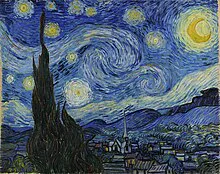
The Moon is prominently featured in Vincent van Gogh (Öffnet in neuem Fenster)'s 1889 painting, The Starry Night (Öffnet in neuem Fenster)
The Moon has an exceptionally low albedo (Öffnet in neuem Fenster), giving it a reflectance (Öffnet in neuem Fenster) that is slightly brighter than that of worn asphalt (Öffnet in neuem Fenster). Despite this, it is the brightest object in the sky after the Sun (Öffnet in neuem Fenster).[71] (Öffnet in neuem Fenster)[k] (Öffnet in neuem Fenster) This is due partly to the brightness enhancement of the opposition surge (Öffnet in neuem Fenster); the Moon at quarter phase is only one-tenth as bright, rather than half as bright, as at full moon (Öffnet in neuem Fenster).[148] (Öffnet in neuem Fenster) Additionally, color constancy (Öffnet in neuem Fenster) in the visual system (Öffnet in neuem Fenster) recalibrates the relations between the colors of an object and its surroundings, and because the surrounding sky is comparatively dark, the sunlit Moon is perceived as a bright object. The edges of the full moon seem as bright as the center, without limb darkening (Öffnet in neuem Fenster), because of the reflective properties (Öffnet in neuem Fenster) of lunar soil (Öffnet in neuem Fenster), which retroreflects (Öffnet in neuem Fenster) light more towards the Sun than in other directions. The Moon does appear larger when close to the horizon, but this is a purely psychological effect, known as the moon illusion (Öffnet in neuem Fenster), first described in the 7th century BC.[149] (Öffnet in neuem Fenster) The full Moon's angular diameter (Öffnet in neuem Fenster) is about 0.52° (on average) in the sky, roughly the same apparent size as the Sun (see § Eclipses (Öffnet in neuem Fenster)).
The Moon's highest altitude (Öffnet in neuem Fenster) at culmination (Öffnet in neuem Fenster) varies by its phase (Öffnet in neuem Fenster) and time of year. The full moon is highest in the sky during winter (for each hemisphere). The orientation of the Moon's crescent (Öffnet in neuem Fenster) also depends on the latitude of the viewing location; an observer in the tropics (Öffnet in neuem Fenster) can see a smile-shaped crescent (Öffnet in neuem Fenster)Moon.[150] (Öffnet in neuem Fenster) The Moon is visible for two weeks every 27.3 days at the North (Öffnet in neuem Fenster) and South Poles (Öffnet in neuem Fenster). Zooplankton (Öffnet in neuem Fenster) in the Arctic (Öffnet in neuem Fenster) use moonlight (Öffnet in neuem Fenster) when the Sun is below the horizon (Öffnet in neuem Fenster) for months on end.[151] (Öffnet in neuem Fenster)
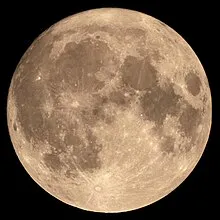
14 November 2016 supermoon (Öffnet in neuem Fenster) was 356,511 kilometres (221,526 mi) away[152] (Öffnet in neuem Fenster) from the center of Earth, the closest occurrence since 26 January 1948. It will not be closer until 25 November 2034.[153] (Öffnet in neuem Fenster)
The distance between the Moon and Earth (Öffnet in neuem Fenster) varies from around 356,400 km (221,500 mi) to 406,700 km (252,700 mi) at perigee (Öffnet in neuem Fenster) (closest) and apogee (farthest), respectively. On 14 November 2016, it was closer to Earth when at full phase than it has been since 1948, 14% closer than its farthest position in apogee.[154] (Öffnet in neuem Fenster) Reported as a "supermoon (Öffnet in neuem Fenster)", this closest point coincided within an hour of a full moon, and it was 30% more luminous than when at its greatest distance because its angular diameter is 14% greater and 
When the actual reduction is 1.00 / 1.30, or about 0.770, the perceived reduction is about 0.877, or 1.00 / 1.14. This gives a maximum perceived increase of 14% between apogee and perigee moons of the same phase.[160] (Öffnet in neuem Fenster)
There has been historical controversy over whether features on the Moon's surface change over time. Today, many of these claims are thought to be illusory, resulting from observation under different lighting conditions, poor astronomical seeing (Öffnet in neuem Fenster), or inadequate drawings. However, outgassing (Öffnet in neuem Fenster) does occasionally occur and could be responsible for a minor percentage of the reported lunar transient phenomena (Öffnet in neuem Fenster). Recently, it has been suggested that a roughly 3 km (1.9 mi) diameter region of the lunar surface was modified by a gas release event about a million years ago.[161] (Öffnet in neuem Fenster)[162] (Öffnet in neuem Fenster)
The Moon's appearance, like the Sun's, can be affected by Earth's atmosphere (Öffnet in neuem Fenster). Common optical effects are the 22° halo ring (Öffnet in neuem Fenster), formed when the Moon's light is refracted through the ice crystals (Öffnet in neuem Fenster) of high cirrostratus (Öffnet in neuem Fenster) clouds, and smaller coronal rings (Öffnet in neuem Fenster) when the Moon is seen through thin clouds.[163] (Öffnet in neuem Fenster)
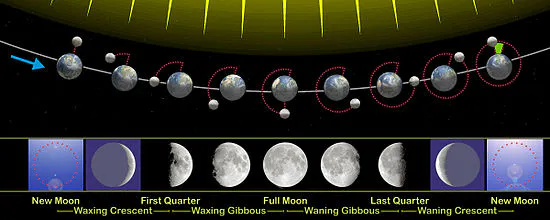
The monthly changes in the angle between the direction of sunlight and view from Earth, and the phases of the Moon (Öffnet in neuem Fenster) that result, as viewed from the Northern Hemisphere (Öffnet in neuem Fenster). The Earth–Moon distance (Öffnet in neuem Fenster) is not to scale.
The illuminated area of the visible sphere (degree of illumination) is given by 

Tidal effects
Main articles: Tidal force (Öffnet in neuem Fenster), Tidal acceleration (Öffnet in neuem Fenster), Tide (Öffnet in neuem Fenster), and Theory of tides (Öffnet in neuem Fenster)
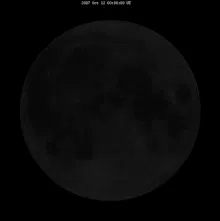
The libration (Öffnet in neuem Fenster) of the Moon over a single lunar month. Also visible is the slight variation in the Moon's visual size from Earth.
The gravitational attraction that masses have for one another decreases inversely with the square of the distance of those masses from each other. As a result, the slightly greater attraction that the Moon has for the side of Earth closest to the Moon, as compared to the part of the Earth opposite the Moon, results in tidal forces (Öffnet in neuem Fenster). Tidal forces affect both the Earth's crust and oceans.
The most obvious effect of tidal forces is to cause two bulges in the Earth's oceans, one on the side facing the Moon and the other on the side opposite. This results in elevated sea levels called ocean tides (Öffnet in neuem Fenster).[164] (Öffnet in neuem Fenster) As the Earth rotates on its axis, one of the ocean bulges (high tide) is held in place "under" the Moon, while another such tide is opposite. As a result, there are two high tides, and two low tides in about 24 hours.[164] (Öffnet in neuem Fenster) Since the Moon is orbiting the Earth in the same direction of the Earth's rotation, the high tides occur about every 12 hours and 25 minutes; the 25 minutes is due to the Moon's time to orbit the Earth. The Sun has the same tidal effect on the Earth, but its forces of attraction are only 40% that of the Moon's; the Sun's and Moon's interplay is responsible for spring and neap tides (Öffnet in neuem Fenster).[164] (Öffnet in neuem Fenster) If the Earth were a water world (one with no continents) it would produce a tide of only one meter, and that tide would be very predictable, but the ocean tides are greatly modified by other effects: the frictional coupling of water to Earth's rotation through the ocean floors, the inertia (Öffnet in neuem Fenster) of water's movement, ocean basins that grow shallower near land, the sloshing of water between different ocean basins.[165] (Öffnet in neuem Fenster) As a result, the timing of the tides at most points on the Earth is a product of observations that are explained, incidentally, by theory.
While gravitation causes acceleration and movement of the Earth's fluid oceans, gravitational coupling between the Moon and Earth's solid body is mostly elastic and plastic. The result is a further tidal effect of the Moon on the Earth that causes a bulge of the solid portion of the Earth nearest the Moon that acts as a torque (Öffnet in neuem Fenster) in opposition to the Earth's rotation. This "drains" angular momentum (Öffnet in neuem Fenster) and rotational kinetic energy (Öffnet in neuem Fenster) from Earth's rotation, slowing the Earth's rotation.[164] (Öffnet in neuem Fenster)[166] (Öffnet in neuem Fenster) That angular momentum, lost from the Earth, is transferred to the Moon in a process (confusingly known as tidal acceleration (Öffnet in neuem Fenster)), which lifts the Moon into a higher orbit and results in its lower orbital speed about the Earth. Thus the distance between Earth and Moon is increasing (Öffnet in neuem Fenster), and the Earth's rotation is slowing in reaction.[166] (Öffnet in neuem Fenster) Measurements from laser reflectors left during the Apollo missions (lunar ranging experiments (Öffnet in neuem Fenster)) have found that the Moon's distance increases by 38 mm (1.5 in) per year[167] (Öffnet in neuem Fenster) (roughly the rate at which human fingernails grow).[168] (Öffnet in neuem Fenster) Atomic clocks (Öffnet in neuem Fenster)also show that Earth's day lengthens by about 15 microseconds (Öffnet in neuem Fenster) every year,[169] (Öffnet in neuem Fenster) slowly increasing the rate at which UTC (Öffnet in neuem Fenster) is adjusted by leap seconds (Öffnet in neuem Fenster). Left to run its course, this tidal drag would continue until the rotation of Earth and the orbital period of the Moon matched, creating mutual tidal locking between the two. As a result, the Moon would be suspended in the sky over one meridian, as is already currently the case with Pluto and its moon Charon. However, the Sun will become a red giant (Öffnet in neuem Fenster) engulfing the Earth-Moon system long before this occurrence.[170] (Öffnet in neuem Fenster)[171] (Öffnet in neuem Fenster) If it were to happen, the rotation of the earth would continue to slow down because of the tides caused by the sun. With the day longer than the month, the moon would move slowly from west to east in the sky. The tides caused by the moon would then cause the opposite effect from before, and the moon would get closer to the earth. Eventually it would come within the Roche limit (Öffnet in neuem Fenster) and be broken up into a ring (Öffnet in neuem Fenster).
In a like manner, the lunar surface experiences tides of around 10 cm (4 in) amplitude over 27 days, with two components: a fixed one due to Earth, because they are in synchronous rotation (Öffnet in neuem Fenster), and a varying component from the Sun.[166] (Öffnet in neuem Fenster) The Earth-induced component arises from libration (Öffnet in neuem Fenster), a result of the Moon's orbital eccentricity (if the Moon's orbit were perfectly circular, there would only be solar tides).[166] (Öffnet in neuem Fenster) Libration also changes the angle from which the Moon is seen, allowing a total of about 59% of its surface to be seen from Earth over time.[71] (Öffnet in neuem Fenster) The cumulative effects of stress built up by these tidal forces produces moonquakes (Öffnet in neuem Fenster). Moonquakes are much less common and weaker than are earthquakes, although moonquakes can last for up to an hour – significantly longer than terrestrial quakes – because of the absence of water to damp out the seismic vibrations. The existence of moonquakes was an unexpected discovery from seismometers (Öffnet in neuem Fenster) placed on the Moon by Apollo (Öffnet in neuem Fenster) astronauts (Öffnet in neuem Fenster) from 1969 through 1972.[172] (Öffnet in neuem Fenster)
According to recent research, scientists suggest that the Moon's influence on the Earth may contribute to maintaining Earth's magnetic field (Öffnet in neuem Fenster).[173] (Öffnet in neuem Fenster)
Eclipses
Main articles: Solar eclipse (Öffnet in neuem Fenster), Lunar eclipse (Öffnet in neuem Fenster), and Eclipse cycle (Öffnet in neuem Fenster)


From Earth, the Moon and the Sun appear the same size, as seen in the 1999 solar eclipse (Öffnet in neuem Fenster) (left), whereas from the STEREO-B (Öffnet in neuem Fenster) spacecraft in an Earth-trailing orbit, the Moon appears much smaller than the Sun (right).[174] (Öffnet in neuem Fenster)
Eclipses only occur when the Sun, Earth, and Moon are all in a straight line (termed "syzygy (Öffnet in neuem Fenster)"). Solar eclipses (Öffnet in neuem Fenster) occur at new moon (Öffnet in neuem Fenster), when the Moon is between the Sun and Earth. In contrast, lunar eclipses (Öffnet in neuem Fenster) occur at full moon, when Earth is between the Sun and Moon. The apparent size of the Moon is roughly the same as that of the Sun, with both being viewed at close to one-half a degree wide. The Sun is much larger than the Moon but it is the vastly greater distance that gives it the same apparent size as the much closer and much smaller Moon from the perspective of Earth. The variations in apparent size, due to the non-circular orbits, are nearly the same as well, though occurring in different cycles. This makes possible both total (Öffnet in neuem Fenster) (with the Moon appearing larger than the Sun) and annular (Öffnet in neuem Fenster) (with the Moon appearing smaller than the Sun) solar eclipses.[175] (Öffnet in neuem Fenster) In a total eclipse, the Moon completely covers the disc of the Sun and the solar corona (Öffnet in neuem Fenster) becomes visible to the naked eye (Öffnet in neuem Fenster). Because the distance between the Moon and Earth is very slowly increasing over time,[164] (Öffnet in neuem Fenster) the angular diameter of the Moon is decreasing. Also, as it evolves toward becoming a red giant (Öffnet in neuem Fenster), the size of the Sun, and its apparent diameter in the sky, are slowly increasing.[l] (Öffnet in neuem Fenster)The combination of these two changes means that hundreds of millions of years ago, the Moon would always completely cover the Sun on solar eclipses, and no annular eclipses were possible. Likewise, hundreds of millions of years in the future, the Moon will no longer cover the Sun completely, and total solar eclipses will not occur.[176] (Öffnet in neuem Fenster)
Because the Moon's orbit around Earth is inclined by about 5.145° (5° 9') to the orbit of Earth around the Sun (Öffnet in neuem Fenster), eclipses do not occur at every full and new moon. For an eclipse to occur, the Moon must be near the intersection of the two orbital planes.[177] (Öffnet in neuem Fenster) The periodicity and recurrence of eclipses of the Sun by the Moon, and of the Moon by Earth, is described by the saros (Öffnet in neuem Fenster), which has a period of approximately 18 years.[178] (Öffnet in neuem Fenster)
Because the Moon continuously blocks the view of a half-degree-wide circular area of the sky,[m] (Öffnet in neuem Fenster)[179] (Öffnet in neuem Fenster) the related phenomenon of occultation (Öffnet in neuem Fenster) occurs when a bright star or planet passes behind the Moon and is occulted: hidden from view. In this way, a solar eclipse is an occultation of the Sun. Because the Moon is comparatively close to Earth, occultations of individual stars are not visible everywhere on the planet, nor at the same time. Because of the precession (Öffnet in neuem Fenster) of the lunar orbit, each year different stars are occulted.[180] (Öffnet in neuem Fenster)
Observation and exploration
Main articles: Exploration of the Moon (Öffnet in neuem Fenster), List of spacecraft that orbited the Moon (Öffnet in neuem Fenster), List of missions to the Moon (Öffnet in neuem Fenster), and List of lunar probes (Öffnet in neuem Fenster)
See also: Timeline of Solar System exploration (Öffnet in neuem Fenster)
Before spaceflight
Main article: Exploration of the Moon: Before spaceflight (Öffnet in neuem Fenster)
Map of the Moon by Johannes Hevelius (Öffnet in neuem Fenster) from his Selenographia (Öffnet in neuem Fenster) (1647), the first map to include the libration (Öffnet in neuem Fenster)zones

A study of the Moon in Robert Hooke's (Öffnet in neuem Fenster) Micrographia (Öffnet in neuem Fenster), 1665
One of the earliest-discovered possible depictions of the Moon is a 5000-year-old rock carving Orthostat 47 (Öffnet in neuem Fenster) at Knowth (Öffnet in neuem Fenster), Ireland.[181] (Öffnet in neuem Fenster)[182] (Öffnet in neuem Fenster)
Understanding of the Moon's cycles was an early development of astronomy: by the 5th century BC, Babylonian astronomers (Öffnet in neuem Fenster) had recorded the 18-year Saros cycle (Öffnet in neuem Fenster) of lunar eclipses (Öffnet in neuem Fenster),[183] (Öffnet in neuem Fenster) and Indian astronomers (Öffnet in neuem Fenster) had described the Moon's monthly elongation.[184] (Öffnet in neuem Fenster) The Chinese astronomer (Öffnet in neuem Fenster) Shi Shen (Öffnet in neuem Fenster)(fl. 4th century BC) gave instructions for predicting solar and lunar eclipses.[185] (Öffnet in neuem Fenster)(p411) Later, the physical form of the Moon and the cause of moonlight (Öffnet in neuem Fenster)became understood. The ancient Greek (Öffnet in neuem Fenster) philosopher Anaxagoras (Öffnet in neuem Fenster) (d. 428 BC) reasoned that the Sun and Moon were both giant spherical rocks, and that the latter reflected the light of the former.[186] (Öffnet in neuem Fenster)[185] (Öffnet in neuem Fenster)(p227) Although the Chinese of the Han Dynasty (Öffnet in neuem Fenster) believed the Moon to be energy equated to qi (Öffnet in neuem Fenster), their 'radiating influence' theory also recognized that the light of the Moon was merely a reflection of the Sun, and Jing Fang (Öffnet in neuem Fenster) (78–37 BC) noted the sphericity of the Moon.[185] (Öffnet in neuem Fenster)(pp413–414) In the 2nd century AD, Lucian (Öffnet in neuem Fenster) wrote the novel A True Story (Öffnet in neuem Fenster), in which the heroes travel to the Moon and meet its inhabitants. In 499 AD, the Indian astronomer Aryabhata (Öffnet in neuem Fenster) mentioned in his Aryabhatiya (Öffnet in neuem Fenster) that reflected sunlight is the cause of the shining of the Moon.[187] (Öffnet in neuem Fenster) The astronomer and physicist Alhazen (Öffnet in neuem Fenster) (965–1039) found that sunlight (Öffnet in neuem Fenster) was not reflected from the Moon like a mirror, but that light was emitted from every part of the Moon's sunlit surface in all directions.[188] (Öffnet in neuem Fenster) Shen Kuo (Öffnet in neuem Fenster) (1031–1095) of the Song dynasty (Öffnet in neuem Fenster) created an allegory equating the waxing and waning of the Moon to a round ball of reflective silver that, when doused with white powder and viewed from the side, would appear to be a crescent.[185] (Öffnet in neuem Fenster)(pp415–416)
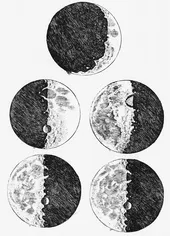
Galileo (Öffnet in neuem Fenster)'s sketches of the Moon from Sidereus Nuncius (Öffnet in neuem Fenster)
In Aristotle (Öffnet in neuem Fenster)'s (384–322 BC) description of the universe (Öffnet in neuem Fenster), the Moon marked the boundary between the spheres of the mutable elements (earth, water, air and fire), and the imperishable stars of aether (Öffnet in neuem Fenster), an influential philosophy (Öffnet in neuem Fenster) that would dominate for centuries.[189] (Öffnet in neuem Fenster) However, in the 2nd century BC, Seleucus of Seleucia (Öffnet in neuem Fenster) correctly theorized that tides (Öffnet in neuem Fenster) were due to the attraction of the Moon, and that their height depends on the Moon's position relative to the Sun (Öffnet in neuem Fenster).[190] (Öffnet in neuem Fenster) In the same century, Aristarchus (Öffnet in neuem Fenster) computed the size and distance (Öffnet in neuem Fenster) of the Moon from Earth, obtaining a value of about twenty times the radius of Earth (Öffnet in neuem Fenster) for the distance. These figures were greatly improved by Ptolemy (Öffnet in neuem Fenster) (90–168 AD): his values of a mean distance of 59 times Earth's radius and a diameter of 0.292 Earth diameters were close to the correct values of about 60 and 0.273 respectively.[191] (Öffnet in neuem Fenster) Archimedes (Öffnet in neuem Fenster) (287–212 BC) designed a planetarium that could calculate the motions of the Moon and other objects in the Solar System.[192] (Öffnet in neuem Fenster)
During the Middle Ages (Öffnet in neuem Fenster), before the invention of the telescope, the Moon was increasingly recognised as a sphere, though many believed that it was "perfectly smooth".[193] (Öffnet in neuem Fenster)
In 1609, Galileo Galilei (Öffnet in neuem Fenster) drew one of the first telescopic drawings of the Moon in his book Sidereus Nuncius (Öffnet in neuem Fenster) and noted that it was not smooth but had mountains and craters. Thomas Harriot (Öffnet in neuem Fenster) had made, but not published such drawings a few months earlier. Telescopic mapping of the Moon followed: later in the 17th century, the efforts of Giovanni Battista Riccioli (Öffnet in neuem Fenster) and Francesco Maria Grimaldi (Öffnet in neuem Fenster) led to the system of naming of lunar features in use today. The more exact 1834–36 Mappa Selenographica of Wilhelm Beer (Öffnet in neuem Fenster) and Johann Heinrich Mädler (Öffnet in neuem Fenster), and their associated 1837 book Der Mond, the first trigonometrically (Öffnet in neuem Fenster) accurate study of lunar features, included the heights of more than a thousand mountains, and introduced the study of the Moon at accuracies possible in earthly geography.[194] (Öffnet in neuem Fenster) Lunar craters, first noted by Galileo, were thought to be volcanic (Öffnet in neuem Fenster) until the 1870s proposal of Richard Proctor (Öffnet in neuem Fenster)that they were formed by collisions.[71] (Öffnet in neuem Fenster) This view gained support in 1892 from the experimentation of geologist Grove Karl Gilbert (Öffnet in neuem Fenster), and from comparative studies from 1920 to the 1940s,[195] (Öffnet in neuem Fenster) leading to the development of lunar stratigraphy (Öffnet in neuem Fenster), which by the 1950s was becoming a new and growing branch of astrogeology (Öffnet in neuem Fenster).[71] (Öffnet in neuem Fenster)
1959–1970s
See also: Space Race (Öffnet in neuem Fenster) and Moon landing (Öffnet in neuem Fenster)
Between the first human arrival with the robotic Soviet (Öffnet in neuem Fenster) Luna program (Öffnet in neuem Fenster) in 1958, to the 1970s with the last Missions of the crewed U.S. (Öffnet in neuem Fenster) Apollo landings (Öffnet in neuem Fenster) and last Luna mission in 1976, the Cold War (Öffnet in neuem Fenster)-inspired Space Race (Öffnet in neuem Fenster) between the Soviet Union and the U.S. led to an acceleration of interest in exploration of the Moon (Öffnet in neuem Fenster). Once launchers had the necessary capabilities, these nations sent uncrewed probes on both flyby and impact/lander missions.
Soviet missions
Main articles: Luna program (Öffnet in neuem Fenster) and Lunokhod programme (Öffnet in neuem Fenster)
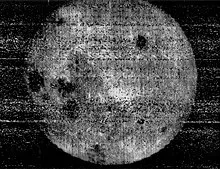
First view in history of the far side of the Moon, taken by Luna 3 (Öffnet in neuem Fenster), 7 October 1959
A model of Soviet Moon rover Lunokhod 1 (Öffnet in neuem Fenster)
Spacecraft from the Soviet Union's Luna program (Öffnet in neuem Fenster) were the first to accomplish a number of goals: following three unnamed, failed missions in 1958,[196] (Öffnet in neuem Fenster) the first human-made object to escape Earth's gravity and pass near the Moon was Luna 1 (Öffnet in neuem Fenster); the first human-made object to impact the lunar surface was Luna 2 (Öffnet in neuem Fenster), and the first photographs of the normally occluded far side of the Moon were made by Luna 3 (Öffnet in neuem Fenster), all in 1959.

Stamp with a drawing of the first soft landed probe Luna 9 (Öffnet in neuem Fenster), next to the first view of the lunar surface photographed by the probe
The first spacecraft to perform a successful lunar soft landing (Öffnet in neuem Fenster) was Luna 9 (Öffnet in neuem Fenster) and the first uncrewed vehicle to orbit the Moon was Luna 10 (Öffnet in neuem Fenster), both in 1966.[71] (Öffnet in neuem Fenster)Rock and soil samples (Öffnet in neuem Fenster) were brought back to Earth by three Luna sample return missions (Öffnet in neuem Fenster) (Luna 16 (Öffnet in neuem Fenster) in 1970, Luna 20 (Öffnet in neuem Fenster) in 1972, and Luna 24 (Öffnet in neuem Fenster) in 1976), which returned 0.3 kg total.[197] (Öffnet in neuem Fenster) Two pioneering robotic rovers (Öffnet in neuem Fenster) landed on the Moon in 1970 and 1973 as a part of Soviet Lunokhod programme (Öffnet in neuem Fenster).
Luna 24 was the last Soviet mission to the Moon.
United States missions
Main articles: Apollo program (Öffnet in neuem Fenster) and Moon landing (Öffnet in neuem Fenster)
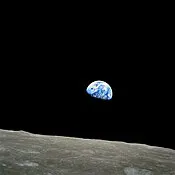
Earthrise (Öffnet in neuem Fenster) (Apollo 8 (Öffnet in neuem Fenster), 1968, taken by William Anders (Öffnet in neuem Fenster))

Moon rock (Öffnet in neuem Fenster) (Apollo 17 (Öffnet in neuem Fenster), 1972)
During the late 1950s at the height of the Cold War, the United States Army conducted a classified feasibility study (Öffnet in neuem Fenster) that proposed the construction of a staffed military outpost on the Moon called Project Horizon (Öffnet in neuem Fenster) with the potential to conduct a wide range of missions from scientific research to nuclear Earth bombardment. The study included the possibility of conducting a lunar-based nuclear test.[198] (Öffnet in neuem Fenster)[199] (Öffnet in neuem Fenster) The Air Force, which at the time was in competition with the Army for a leading role in the space program, developed its own similar plan called Lunex (Öffnet in neuem Fenster).[200] (Öffnet in neuem Fenster)[201] (Öffnet in neuem Fenster)[198] (Öffnet in neuem Fenster) However, both these proposals were ultimately passed over as the space program was largely transferred from the military to the civilian agency NASA.[201] (Öffnet in neuem Fenster)
Following President John F. Kennedy (Öffnet in neuem Fenster)'s 1961 commitment to a human moon landing before the end of the decade, the United States, under NASA leadership, launched a series of uncrewed probes to develop an understanding of the lunar surface in preparation for human missions: the Jet Propulsion Laboratory (Öffnet in neuem Fenster)'s Ranger program (Öffnet in neuem Fenster) produced the first close-up pictures; the Lunar Orbiter program (Öffnet in neuem Fenster) produced maps of the entire Moon; the Surveyor program (Öffnet in neuem Fenster)landed its first spacecraft (Öffnet in neuem Fenster) four months after Luna 9. The crewed Apollo program was developed in parallel; after a series of uncrewed and crewed tests of the Apollo spacecraft in Earth orbit, and spurred on by a potential Soviet lunar human landing (Öffnet in neuem Fenster), in 1968 Apollo 8 (Öffnet in neuem Fenster) made the first human mission to lunar orbit. The subsequent landing of the first humans on the Moon in 1969 is seen by many as the culmination of the Space Race.[202] (Öffnet in neuem Fenster)
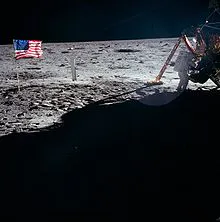
Neil Armstrong (Öffnet in neuem Fenster) working at the Lunar Module Eagle (Öffnet in neuem Fenster) during Apollo 11 (Öffnet in neuem Fenster) (1969)

"That's one small step ..." (Öffnet in neuem Fenster)
MENU
0:00
Problems playing this file? See media help (Öffnet in neuem Fenster).
Neil Armstrong (Öffnet in neuem Fenster) became the first person to walk on the Moon as the commander of the American mission Apollo 11 (Öffnet in neuem Fenster) by first setting foot on the Moon at 02:56 UTC on 21 July 1969.[203] (Öffnet in neuem Fenster) An estimated 500 million people worldwide watched the transmission by the Apollo TV camera (Öffnet in neuem Fenster), the largest television audience for a live broadcast at that time.[204] (Öffnet in neuem Fenster)[205] (Öffnet in neuem Fenster) The Apollo missions 11 to 17 (except Apollo 13 (Öffnet in neuem Fenster), which aborted its planned lunar landing) removed 380.05 kilograms (837.87 lb) of lunar rock and soil in 2,196 separate samples.[206] (Öffnet in neuem Fenster) The American Moon landing (Öffnet in neuem Fenster) and return was enabled by considerable technological advances in the early 1960s, in domains such as ablation (Öffnet in neuem Fenster) chemistry, software engineering (Öffnet in neuem Fenster), and atmospheric re-entry (Öffnet in neuem Fenster) technology, and by highly competent management of the enormous technical undertaking.[207] (Öffnet in neuem Fenster)[208] (Öffnet in neuem Fenster)
Scientific instrument packages were installed on the lunar surface during all the Apollo landings. Long-lived instrument stations (Öffnet in neuem Fenster), including heat flow probes, seismometers (Öffnet in neuem Fenster), and magnetometers (Öffnet in neuem Fenster), were installed at the Apollo 12 (Öffnet in neuem Fenster), 14 (Öffnet in neuem Fenster), 15 (Öffnet in neuem Fenster), 16 (Öffnet in neuem Fenster), and 17 (Öffnet in neuem Fenster) landing sites. Direct transmission of data to Earth concluded in late 1977 because of budgetary considerations,[209] (Öffnet in neuem Fenster)[210] (Öffnet in neuem Fenster)but as the stations' lunar laser ranging (Öffnet in neuem Fenster) corner-cube retroreflector arrays are passive instruments, they are still being used. Ranging to the stations is routinely performed from Earth-based stations with an accuracy of a few centimeters, and data from this experiment are being used to place constraints on the size of the lunar core.[211] (Öffnet in neuem Fenster)
1970s – present

An artificially (Öffnet in neuem Fenster) colored mosaic constructed from a series of 53 images taken through three spectral filters (Öffnet in neuem Fenster) by Galileo' s imaging system as the spacecraft flew over the northern regions of the Moon on 7 December 1992.
After the Moon race the focus of astronautic exploration shifted in the 1970s with probes like Pioneer 10 (Öffnet in neuem Fenster) and the Voyager program (Öffnet in neuem Fenster) towards the outer solar system (Öffnet in neuem Fenster). Years of near lunar quietude followed, only broken by a beginning internationalization of space and the Moon through for example the negotiation of the Moon treaty (Öffnet in neuem Fenster).
Since the 1990s, many more countries have become involved in direct exploration of the Moon. In 1990, Japan became the third country to place a spacecraft into lunar orbit with its Hiten (Öffnet in neuem Fenster) spacecraft. The spacecraft released a smaller probe, Hagoromo, in lunar orbit, but the transmitter failed, preventing further scientific use of the mission.[212] (Öffnet in neuem Fenster) In 1994, the U.S. sent the joint Defense Department/NASA spacecraft Clementine (Öffnet in neuem Fenster) to lunar orbit. This mission obtained the first near-global topographic map of the Moon, and the first global multispectral (Öffnet in neuem Fenster) images of the lunar surface.[213] (Öffnet in neuem Fenster) This was followed in 1998 by the Lunar Prospector (Öffnet in neuem Fenster) mission, whose instruments indicated the presence of excess hydrogen at the lunar poles, which is likely to have been caused by the presence of water ice in the upper few meters of the regolith within permanently shadowed craters.[214] (Öffnet in neuem Fenster)
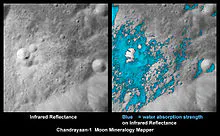
As viewed by Chandrayaan-1 (Öffnet in neuem Fenster)'s NASA Moon Mineralogy Mapper equipment, on the right, the first time discovered water-rich minerals (light blue), shown around a small crater from which it was ejected.
The European spacecraft SMART-1 (Öffnet in neuem Fenster), the second ion-propelled (Öffnet in neuem Fenster) spacecraft, was in lunar orbit from 15 November 2004 until its lunar impact on 3 September 2006, and made the first detailed survey of chemical elements on the lunar surface.[215] (Öffnet in neuem Fenster)
The ambitious Chinese Lunar Exploration Program (Öffnet in neuem Fenster) began with Chang'e 1 (Öffnet in neuem Fenster), which successfully orbited the Moon from 5 November 2007 until its controlled lunar impact on 1 March 2009.[216] (Öffnet in neuem Fenster) It obtained a full image map of the Moon. Chang'e 2 (Öffnet in neuem Fenster), beginning in October 2010, reached the Moon more quickly, mapped the Moon at a higher resolution over an eight-month period, then left lunar orbit for an extended stay at the Earth–Sun L2 Lagrangian point (Öffnet in neuem Fenster), before finally performing a flyby of asteroid 4179 Toutatis (Öffnet in neuem Fenster) on 13 December 2012, and then heading off into deep space. On 14 December 2013, Chang'e 3 (Öffnet in neuem Fenster) landed a lunar lander (Öffnet in neuem Fenster) onto the Moon's surface, which in turn deployed a lunar rover (Öffnet in neuem Fenster), named Yutu (Öffnet in neuem Fenster) (Chinese: 玉兔; literally "Jade Rabbit"). This was the first lunar soft landing (Öffnet in neuem Fenster) since Luna 24 (Öffnet in neuem Fenster) in 1976, and the first lunar rover mission since Lunokhod 2 (Öffnet in neuem Fenster) in 1973. Another rover mission (Chang'e 4 (Öffnet in neuem Fenster)) was launched in 2019, becoming the first ever spacecraft to land on the Moon's far side. China intends to following this up with a sample return mission (Öffnet in neuem Fenster) (Chang'e 5 (Öffnet in neuem Fenster)) in 2020.[217] (Öffnet in neuem Fenster)
Between 4 October 2007 and 10 June 2009, the Japan Aerospace Exploration Agency (Öffnet in neuem Fenster)'s Kaguya (Öffnet in neuem Fenster) (Selene) mission, a lunar orbiter fitted with a high-definition video (Öffnet in neuem Fenster) camera, and two small radio-transmitter satellites, obtained lunar geophysics data and took the first high-definition movies from beyond Earth orbit.[218] (Öffnet in neuem Fenster)[219] (Öffnet in neuem Fenster) India's first lunar mission, Chandrayaan-1 (Öffnet in neuem Fenster), orbited from 8 November 2008 until loss of contact on 27 August 2009, creating a high-resolution chemical, mineralogical and photo-geological map of the lunar surface, and confirming the presence of water molecules in lunar soil (Öffnet in neuem Fenster).[220] (Öffnet in neuem Fenster) The Indian Space Research Organisation (Öffnet in neuem Fenster) planned to launch Chandrayaan-2 (Öffnet in neuem Fenster) in 2013, which would have included a Russian robotic lunar rover.[221] (Öffnet in neuem Fenster)[222] (Öffnet in neuem Fenster) However, the failure of Russia's Fobos-Grunt (Öffnet in neuem Fenster) mission has delayed this project, and was launched on 22 July 2019. The lander Vikram attempted to land on the lunar south pole region (Öffnet in neuem Fenster) on 6 September, but lost the signal in 2.1 km (1.3 mi). What happened after that is unknown.

Copernicus (Öffnet in neuem Fenster)'s central peaks as observed by the LRO (Öffnet in neuem Fenster), 2012
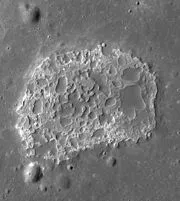
The Ina (Öffnet in neuem Fenster) formation, 2009
The U.S. co-launched the Lunar Reconnaissance Orbiter (LRO) and the LCROSS (Öffnet in neuem Fenster) impactor and follow-up observation orbiter on 18 June 2009; LCROSScompleted its mission by making a planned and widely observed impact in the crater Cabeus (Öffnet in neuem Fenster) on 9 October 2009,[223] (Öffnet in neuem Fenster) whereas LRO is currently in operation, obtaining precise lunar altimetry (Öffnet in neuem Fenster) and high-resolution imagery. In November 2011, the LRO passed over the large and bright crater Aristarchus (Öffnet in neuem Fenster). NASA released photos of the crater on 25 December 2011.[224] (Öffnet in neuem Fenster)
Two NASA GRAIL (Öffnet in neuem Fenster) spacecraft began orbiting the Moon around 1 January 2012,[225] (Öffnet in neuem Fenster) on a mission to learn more about the Moon's internal structure. NASA's LADEE (Öffnet in neuem Fenster) probe, designed to study the lunar exosphere (Öffnet in neuem Fenster), achieved orbit on 6 October 2013.
Future
See also: List of proposed missions to the Moon (Öffnet in neuem Fenster)
Upcoming lunar missions include Russia's Luna-Glob (Öffnet in neuem Fenster): an uncrewed lander with a set of seismometers, and an orbiter based on its failed Martian Fobos-Grunt (Öffnet in neuem Fenster) mission.[226] (Öffnet in neuem Fenster) Privately funded lunar exploration has been promoted by the Google Lunar X Prize (Öffnet in neuem Fenster), announced 13 September 2007, which offers US$20 million to anyone who can land a robotic rover on the Moon and meet other specified criteria.[227] (Öffnet in neuem Fenster) Shackleton Energy Company (Öffnet in neuem Fenster) is building a program to establish operations on the south pole of the Moon to harvest water and supply their Propellant Depots (Öffnet in neuem Fenster).[228] (Öffnet in neuem Fenster)
NASA began to plan to resume human missions (Öffnet in neuem Fenster) following the call by U.S. President George W. Bush (Öffnet in neuem Fenster) on 14 January 2004 for a human mission to the Moon by 2019 and the construction of a lunar base by 2024.[229] (Öffnet in neuem Fenster) The Constellation program (Öffnet in neuem Fenster) was funded and construction and testing begun on a crewed spacecraft (Öffnet in neuem Fenster) and launch vehicle (Öffnet in neuem Fenster),[230] (Öffnet in neuem Fenster) and design studies for a lunar base.[231] (Öffnet in neuem Fenster) However, that program has been canceled in favor of a human asteroid landing by 2025 and a human Mars orbit by 2035.[232] (Öffnet in neuem Fenster) India (Öffnet in neuem Fenster) has also expressed its hope to send people to the Moon by 2020.[233] (Öffnet in neuem Fenster)
On 28 February 2018, SpaceX (Öffnet in neuem Fenster), Vodafone (Öffnet in neuem Fenster), Nokia (Öffnet in neuem Fenster) and Audi (Öffnet in neuem Fenster) announced a collaboration to install a 4G (Öffnet in neuem Fenster) wireless communication network on the Moon, with the aim of streaming live footage on the surface to Earth.[234] (Öffnet in neuem Fenster)
Recent reports also indicate NASA's intent to send a woman astronaut to the Moon in their planned mid-2020s mission.[235] (Öffnet in neuem Fenster)
Planned commercial missions
In 2007, the X Prize Foundation together with Google (Öffnet in neuem Fenster) launched the Google Lunar X Prize (Öffnet in neuem Fenster) to encourage commercial endeavors to the Moon. A prize of $20 million was to be awarded to the first private venture to get to the Moon with a robotic lander by the end of March 2018, with additional prizes worth $10 million for further milestones.[236] (Öffnet in neuem Fenster)[237] (Öffnet in neuem Fenster) As of August 2016, 16 teams were reportedly participating in the competition.[238] (Öffnet in neuem Fenster) In January 2018 the foundation announced that the prize would go unclaimed as none of the finalist teams would be able to make a launch attempt by the deadline.[239] (Öffnet in neuem Fenster)
In August 2016, the US government granted permission to US-based start-up Moon Express to land on the Moon.[240] (Öffnet in neuem Fenster) This marked the first time that a private enterprise was given the right to do so. The decision is regarded as a precedent helping to define regulatory standards for deep-space commercial activity in the future, as thus far companies' operation had been restricted to being on or around Earth.[240] (Öffnet in neuem Fenster)
On 29 November 2018 NASA announced that nine commercial companies would compete to win a contract to send small payloads to the Moon in what is known as Commercial Lunar Payload Services (Öffnet in neuem Fenster). According to NASA administrator Jim Bridenstine (Öffnet in neuem Fenster), "We are building a domestic American capability to get back and forth to the surface of the moon.".[241] (Öffnet in neuem Fenster)
Human presence
See also: Human presence in space (Öffnet in neuem Fenster)
Human impact
See also: List of artificial objects on the Moon (Öffnet in neuem Fenster), Space art § Art in space (Öffnet in neuem Fenster), and Planetary protection § Category V (Öffnet in neuem Fenster)

Remains of human activity, Apollo 17's Lunar Surface Experiments Package (Öffnet in neuem Fenster)
Beside the traces of human activity on the Moon, there have been some intended permanent installations like the Moon Museum (Öffnet in neuem Fenster) art piece, Apollo 11 goodwill messages (Öffnet in neuem Fenster), Lunar plaque (Öffnet in neuem Fenster), the Fallen Astronaut (Öffnet in neuem Fenster) memorial, and other artifacts.
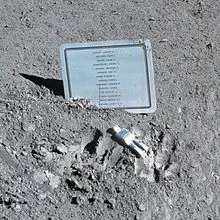
Fallen Astronaut (Öffnet in neuem Fenster)
Infrastructure
Main article: Moonbase (Öffnet in neuem Fenster)
See also: Space infrastructure (Öffnet in neuem Fenster), Tourism on the Moon (Öffnet in neuem Fenster), and Colonization of the Moon (Öffnet in neuem Fenster)
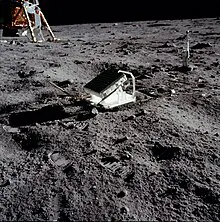
A photo of the still in use reflector of the Lunar Laser Ranging Experiment (Öffnet in neuem Fenster) of Apollo 11 (Öffnet in neuem Fenster).
Longterm missions continuing to be active are some orbiters such as the 2009 launched Lunar Reconnaissance Orbiter (Öffnet in neuem Fenster) surveiling the Moon for future missions, as well as some Landers such as the 2013 launched Chang'e 3 (Öffnet in neuem Fenster) with its Lunar Ultraviolet Telescope still operational.[242] (Öffnet in neuem Fenster)
There are several missions by different agencies and companies planned (Öffnet in neuem Fenster) to establish a longterm human presence on the Moon, with the Lunar Gateway (Öffnet in neuem Fenster) as the currently most advanced project as part of the Artemis program (Öffnet in neuem Fenster).
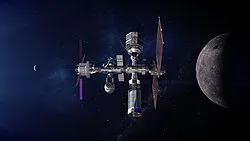
Concept art of the Lunar Gateway (Öffnet in neuem Fenster) of the Artemis program (Öffnet in neuem Fenster) in 2024 serving as a communication hub, science laboratory, short-term habitation and holding area for rovers in lunar orbit (Öffnet in neuem Fenster).[243] (Öffnet in neuem Fenster)
Astronomy from the Moon
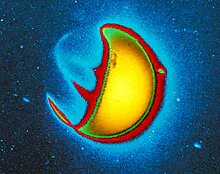
A false-color image of Earth (Öffnet in neuem Fenster) in ultraviolet light (Öffnet in neuem Fenster) taken from the surface of the Moon on the Apollo 16 (Öffnet in neuem Fenster) mission. The day-side reflects a large amount of UV light from the Sun, but the night-side shows faint bands of UV emission from the aurora (Öffnet in neuem Fenster) caused by charged particles.[244] (Öffnet in neuem Fenster)
For many years, the Moon has been recognized as an excellent site for telescopes.[245] (Öffnet in neuem Fenster) It is relatively nearby; astronomical seeing (Öffnet in neuem Fenster) is not a concern; certain craters near the poles are permanently dark and cold, and thus especially useful for infrared telescopes (Öffnet in neuem Fenster); and radio telescopes (Öffnet in neuem Fenster) on the far side would be shielded from the radio chatter of Earth.[246] (Öffnet in neuem Fenster) The lunar soil (Öffnet in neuem Fenster), although it poses a problem for any moving parts of telescopes (Öffnet in neuem Fenster), can be mixed with carbon nanotubes (Öffnet in neuem Fenster) and epoxies (Öffnet in neuem Fenster) and employed in the construction of mirrors up to 50 meters in diameter.[247] (Öffnet in neuem Fenster) A lunar zenith telescope (Öffnet in neuem Fenster) can be made cheaply with an ionic liquid (Öffnet in neuem Fenster).[248] (Öffnet in neuem Fenster)
In April 1972, the Apollo 16 (Öffnet in neuem Fenster) mission recorded various astronomical photos and spectra in ultraviolet with the Far Ultraviolet Camera/Spectrograph (Öffnet in neuem Fenster).[249] (Öffnet in neuem Fenster)
Living on the Moon
Humans have stayed for days on the Moon, such as during Apollo 17.[250] (Öffnet in neuem Fenster) One particular challenge for astronauts' daily life during their stay on the surface is the lunar dust (Öffnet in neuem Fenster) sticking to their suits and being carried into their quarters. Subsequently, the dust was tasted and smelled by the astronauts, calling it the "Apollo aroma".[251] (Öffnet in neuem Fenster) This contamination poses a danger since the fine lunar dust can cause health issues (Öffnet in neuem Fenster).[251] (Öffnet in neuem Fenster)
In 2019 at least one plant seed sprouted in an experiment, carried along with other small life from Earth on the Chang'e 4 lander (Öffnet in neuem Fenster) in its Lunar Micro Ecosystem.[252] (Öffnet in neuem Fenster)
Legal status
Main article: Space law (Öffnet in neuem Fenster)
Although Luna (Öffnet in neuem Fenster) landers scattered pennants of the Soviet Union (Öffnet in neuem Fenster) on the Moon, and U.S. flags (Öffnet in neuem Fenster) were symbolically planted at their landing sites by the Apollo astronauts (Öffnet in neuem Fenster), no nation claims ownership of any part of the Moon's surface.[253] (Öffnet in neuem Fenster) Russia, China, India, and the U.S. are party to the 1967 Outer Space Treaty (Öffnet in neuem Fenster),[254] (Öffnet in neuem Fenster) which defines the Moon and all outer space as the "province of all mankind (Öffnet in neuem Fenster)".[253] (Öffnet in neuem Fenster) This treaty also restricts the use of the Moon to peaceful purposes, explicitly banning military installations and weapons of mass destruction (Öffnet in neuem Fenster).[255] (Öffnet in neuem Fenster) The 1979 Moon Agreement (Öffnet in neuem Fenster) was created to restrict the exploitation of the Moon's resources (Öffnet in neuem Fenster) by any single nation, but as of January 2020, it has been signed and ratified by only 18 nations,[256] (Öffnet in neuem Fenster) none of which engages in self-launched human space exploration (Öffnet in neuem Fenster). Although several individuals have made claims to the Moon (Öffnet in neuem Fenster) in whole or in part, none of these are considered credible.[257] (Öffnet in neuem Fenster)[258] (Öffnet in neuem Fenster)[259] (Öffnet in neuem Fenster)
In 2020, U.S. President Donald Trump (Öffnet in neuem Fenster) signed an executive order called "Encouraging International Support for the Recovery and Use of Space Resources". The order emphasizes that "the United States does not view outer space as a 'global commons'" and calls the Moon Agreement "a failed attempt at constraining free enterprise."[260] (Öffnet in neuem Fenster)[261] (Öffnet in neuem Fenster)
The Declaration of the Rights of the Moon (Öffnet in neuem Fenster) was created by a group of independent researchers in 2021, drawing on precedents in the Rights of Nature (Öffnet in neuem Fenster) movement and the concept of legal personality for non-human entities in space[262] (Öffnet in neuem Fenster).
In culture

Luna, the Moon, from a 1550 edition of Guido Bonatti (Öffnet in neuem Fenster)'s Liber astronomiae
See also: Moon in fiction (Öffnet in neuem Fenster) and Tourism on the Moon (Öffnet in neuem Fenster)
Mythology
Further information: Lunar deity (Öffnet in neuem Fenster), Selene (Öffnet in neuem Fenster), Luna (goddess) (Öffnet in neuem Fenster), Man in the Moon (Öffnet in neuem Fenster), and Crescent (Öffnet in neuem Fenster)

Statue of Chandraprabha (Öffnet in neuem Fenster) (meaning "as charming as the moon"), the eighth Tirthankara (Öffnet in neuem Fenster) in Jainism (Öffnet in neuem Fenster), with the symbol of a crescent (Öffnet in neuem Fenster) moon below it
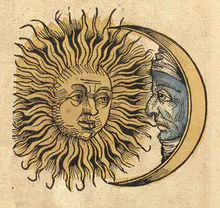
Sun and Moon with faces (1493 woodcut)
The contrast between the brighter highlands and the darker maria creates the patterns seen by different cultures as the Man in the Moon (Öffnet in neuem Fenster), the rabbit (Öffnet in neuem Fenster)and the buffalo, among others. In many prehistoric and ancient cultures, the Moon was personified as a deity (Öffnet in neuem Fenster) or other supernatural (Öffnet in neuem Fenster) phenomenon, and astrological views of the Moon (Öffnet in neuem Fenster) continue to be propagated today.
In Proto-Indo-European religion (Öffnet in neuem Fenster), the Moon was personified as the male god *Meh1not (Öffnet in neuem Fenster).[263] (Öffnet in neuem Fenster) The ancient Sumerians (Öffnet in neuem Fenster) believed that the Moon was the god Nanna (Öffnet in neuem Fenster),[264] (Öffnet in neuem Fenster)[265] (Öffnet in neuem Fenster) who was the father of Inanna (Öffnet in neuem Fenster), the goddess of the planet Venus (Öffnet in neuem Fenster),[264] (Öffnet in neuem Fenster)[265] (Öffnet in neuem Fenster) and Utu (Öffnet in neuem Fenster), the god of the sun.[264] (Öffnet in neuem Fenster)[265] (Öffnet in neuem Fenster) Nanna was later known as Sîn,[265] (Öffnet in neuem Fenster)[264] (Öffnet in neuem Fenster) and was particularly associated with magic and sorcery.[264] (Öffnet in neuem Fenster) In Greco-Roman mythology (Öffnet in neuem Fenster), the Sun and the Moon are represented as male and female, respectively (Helios/Sol (Öffnet in neuem Fenster) and Selene/Luna (Öffnet in neuem Fenster));[263] (Öffnet in neuem Fenster) this is a development unique to the eastern Mediterranean[263] (Öffnet in neuem Fenster) and traces of an earlier male moon god in the Greek tradition are preserved in the figure of Menelaus (Öffnet in neuem Fenster).[263] (Öffnet in neuem Fenster)
In Mesopotamian iconography, the crescent (Öffnet in neuem Fenster) was the primary symbol of Nanna-Sîn.[265] (Öffnet in neuem Fenster) In ancient Greek art (Öffnet in neuem Fenster), the Moon goddess Selene (Öffnet in neuem Fenster) was represented wearing a crescent on her headgear in an arrangement reminiscent of horns.[266] (Öffnet in neuem Fenster)[267] (Öffnet in neuem Fenster) The star and crescent (Öffnet in neuem Fenster) arrangement also goes back to the Bronze Age, representing either the Sun and Moon, or the Moon and planet Venus, in combination. It came to represent the goddess Artemis (Öffnet in neuem Fenster) or Hecate (Öffnet in neuem Fenster), and via the patronage of Hecate came to be used as a symbol of Byzantium (Öffnet in neuem Fenster).
An iconographic tradition of representing Sun and Moon with faces developed in the late medieval period.
The splitting of the moon (Öffnet in neuem Fenster) (Arabic (Öffnet in neuem Fenster): انشقاق القمر) is a miracle attributed to Muhammad (Öffnet in neuem Fenster).[268] (Öffnet in neuem Fenster) A song titled 'Moon Anthem' was released on the occasion of landing of India's Chandrayan-II on the Moon.[269] (Öffnet in neuem Fenster)
Calendar
Further information: Lunar calendar (Öffnet in neuem Fenster), Lunisolar calendar (Öffnet in neuem Fenster), Metonic cycle (Öffnet in neuem Fenster), Blue moon (Öffnet in neuem Fenster), and Movable feast (Öffnet in neuem Fenster)
The Moon's regular phases make it a very convenient timepiece, and the periods of its waxing and waning form the basis of many of the oldest calendars. Tally sticks (Öffnet in neuem Fenster), notched bones dating as far back as 20–30,000 years ago, are believed by some to mark the phases of the Moon.[270] (Öffnet in neuem Fenster)[271] (Öffnet in neuem Fenster)[272] (Öffnet in neuem Fenster) The ~30-day month is an approximation of the lunar cycle (Öffnet in neuem Fenster). The English noun month and its cognates in other Germanic languages stem from Proto-Germanic *mǣnṓth-, which is connected to the above-mentioned Proto-Germanic *mǣnōn, indicating the usage of a lunar calendar (Öffnet in neuem Fenster) among the Germanic peoples (Öffnet in neuem Fenster) (Germanic calendar (Öffnet in neuem Fenster)) prior to the adoption of a solar calendar (Öffnet in neuem Fenster).[273] (Öffnet in neuem Fenster) The PIE root (Öffnet in neuem Fenster) of moon, *méh1nōt, derives from the PIE verbal root *meh1-, "to measure", "indicat[ing] a functional conception of the Moon, i.e. marker of the month" (cf. (Öffnet in neuem Fenster) the English words measure and menstrual),[274] (Öffnet in neuem Fenster)[275] (Öffnet in neuem Fenster)[276] (Öffnet in neuem Fenster) and echoing the Moon's importance to many ancient cultures in measuring time (see Latin (Öffnet in neuem Fenster) mensis and Ancient Greek (Öffnet in neuem Fenster) μείς (meis) or μήν (mēn), meaning "month").[277] (Öffnet in neuem Fenster)[278] (Öffnet in neuem Fenster)[279] (Öffnet in neuem Fenster)[280] (Öffnet in neuem Fenster)Most historical calendars are lunisolar (Öffnet in neuem Fenster). The 7th-century Islamic calendar (Öffnet in neuem Fenster) is an exceptional example of a purely lunar calendar (Öffnet in neuem Fenster). Months are traditionally determined by the visual sighting of the hilal, or earliest crescent moon, over the horizon.[281] (Öffnet in neuem Fenster)

Moonrise, 1884, painting by Stanisław Masłowski (Öffnet in neuem Fenster) (National Museum, Kraków (Öffnet in neuem Fenster), Gallery of Sukiennice Museum (Öffnet in neuem Fenster))
Lunar effect
Main article: Lunar effect (Öffnet in neuem Fenster)
The lunar effect is a purported unproven correlation between specific stages of the roughly 29.5-day lunar cycle and behavior and physiological changes in living beings on Earth, including humans.
The Moon has long been particularly associated with insanity and irrationality; the words lunacy and lunatic (Öffnet in neuem Fenster) (popular shortening loony) are derived from the Latin name for the Moon, Luna. Philosophers Aristotle (Öffnet in neuem Fenster) and Pliny the Elder (Öffnet in neuem Fenster) argued that the full moon induced insanity in susceptible individuals, believing that the brain, which is mostly water, must be affected by the Moon and its power over the tides, but the Moon's gravity is too slight to affect any single person.[282] (Öffnet in neuem Fenster) Even today, people who believe in a lunar effect (Öffnet in neuem Fenster) claim that admissions to psychiatric hospitals, traffic accidents, homicides or suicides increase during a full moon, but dozens of studies invalidate these claims.[282] (Öffnet in neuem Fenster)[283] (Öffnet in neuem Fenster)[284] (Öffnet in neuem Fenster)[285] (Öffnet in neuem Fenster)[286] (Öffnet in neuem Fenster)
Notes
^ (Öffnet in neuem Fenster) Between 18.29° and 28.58° to Earth's equator (Öffnet in neuem Fenster).[1] (Öffnet in neuem Fenster)
^ (Öffnet in neuem Fenster) There are a number of near-Earth asteroids (Öffnet in neuem Fenster), including 3753 Cruithne (Öffnet in neuem Fenster), that are co-orbital (Öffnet in neuem Fenster) with Earth: their orbits bring them close to Earth for periods of time but then alter in the long term (Morais et al, 2002). These are quasi-satellites (Öffnet in neuem Fenster) – they are not moons as they do not orbit Earth. For more information, see Other moons of Earth (Öffnet in neuem Fenster).
^ (Öffnet in neuem Fenster) The maximum value is given based on scaling of the brightness from the value of −12.74 given for an equator to Moon-centre distance of 378 000 km in the NASA factsheet reference to the minimum Earth–Moon distance given there, after the latter is corrected for Earth's equatorial radius of 6 378 km, giving 350 600 km. The minimum value (for a distant new moon (Öffnet in neuem Fenster)) is based on a similar scaling using the maximum Earth–Moon distance of 407 000 km (given in the factsheet) and by calculating the brightness of the earthshine (Öffnet in neuem Fenster) onto such a new moon. The brightness of the earthshine is [ Earth albedo (Öffnet in neuem Fenster) × (Earth radius (Öffnet in neuem Fenster) / Radius of Moon's orbit (Öffnet in neuem Fenster))2 ] relative to the direct solar illumination that occurs for a full moon. (Earth albedo = 0.367; Earth radius = (polar radius × equatorial radius)½ = 6 367 km.)
^ (Öffnet in neuem Fenster) The range of angular size values given are based on simple scaling of the following values given in the fact sheet reference: at an Earth-equator to Moon-centre distance of 378 000 km, the angular size (Öffnet in neuem Fenster) is 1896 arcseconds (Öffnet in neuem Fenster). The same fact sheet gives extreme Earth–Moon distances of 407 000 km and 357 000 km. For the maximum angular size, the minimum distance has to be corrected for Earth's equatorial radius of 6 378 km, giving 350 600 km.
^ (Öffnet in neuem Fenster) Lucey et al. (2006) give 107 particles cm−3 by day and 105 particles cm−3by night. Along with equatorial surface temperatures of 390 K (Öffnet in neuem Fenster) by day and 100 K by night, the ideal gas law (Öffnet in neuem Fenster) yields the pressures given in the infobox (rounded to the nearest order of magnitude (Öffnet in neuem Fenster)): 10−7 Pa (Öffnet in neuem Fenster) by day and 10−10 Pa by night.
^ (Öffnet in neuem Fenster) This age is calculated from isotope dating of lunar zircons.
^ (Öffnet in neuem Fenster) More accurately, the Moon's mean sidereal period (fixed star to fixed star) is 27.321661 days (27 d 07 h 43 min 11.5 s), and its mean tropical orbital period (from equinox to equinox) is 27.321582 days (27 d 07 h 43 min 04.7 s) (Explanatory Supplement to the Astronomical Ephemeris, 1961, at p.107).
^ (Öffnet in neuem Fenster) More accurately, the Moon's mean synodic period (between mean solar conjunctions) is 29.530589 days (29 d 12 h 44 min 02.9 s) (Explanatory Supplement to the Astronomical Ephemeris, 1961, at p.107).
^ (Öffnet in neuem Fenster) There is no strong correlation between the sizes of planets and the sizes of their satellites. Larger planets tend to have more satellites, both large and small, than smaller planets.
^ (Öffnet in neuem Fenster) With 27% the diameter and 60% the density of Earth, the Moon has 1.23% of the mass of Earth. The moon Charon (Öffnet in neuem Fenster) is larger relative to its primary Pluto (Öffnet in neuem Fenster), but Pluto is now considered to be a dwarf planet (Öffnet in neuem Fenster).
^ (Öffnet in neuem Fenster) The Sun's apparent magnitude (Öffnet in neuem Fenster) is −26.7, while the full moon's apparent magnitude is −12.7.
^ (Öffnet in neuem Fenster) See graph in Sun#Life phases (Öffnet in neuem Fenster). At present, the diameter of the Sun is increasing at a rate of about five percent per billion years. This is very similar to the rate at which the apparent angular diameter of the Moon is decreasing as it recedes from Earth.
^ (Öffnet in neuem Fenster) On average, the Moon covers an area of 0.21078 square degrees on the night sky.
References
Citations
^ Jump up to: a (Öffnet in neuem Fenster) b (Öffnet in neuem Fenster) c (Öffnet in neuem Fenster) d (Öffnet in neuem Fenster) e (Öffnet in neuem Fenster) f (Öffnet in neuem Fenster) g (Öffnet in neuem Fenster) h (Öffnet in neuem Fenster) i (Öffnet in neuem Fenster) j (Öffnet in neuem Fenster) k (Öffnet in neuem Fenster) l (Öffnet in neuem Fenster) Wieczorek, Mark A.; et al. (2006). "The constitution and structure of the lunar interior" (Öffnet in neuem Fenster). Reviews in Mineralogy and Geochemistry (Öffnet in neuem Fenster). 60 (1): 221–364. Bibcode (Öffnet in neuem Fenster):2006RvMG...60..221W (Öffnet in neuem Fenster). doi (Öffnet in neuem Fenster):10.2138/rmg.2006.60.3 (Öffnet in neuem Fenster). S2CID (Öffnet in neuem Fenster) 130734866 (Öffnet in neuem Fenster). Archived (Öffnet in neuem Fenster) from the original on 19 August 2020. Retrieved 2 December 2019.
^ Jump up to: a (Öffnet in neuem Fenster) b (Öffnet in neuem Fenster) Lang, Kenneth R. (2011). The Cambridge Guide to the Solar System' (Öffnet in neuem Fenster) (2nd ed.). Cambridge University Press. ISBN (Öffnet in neuem Fenster) 9781139494175 (Öffnet in neuem Fenster). Archived from the original (Öffnet in neuem Fenster) on 1 January 2016.
^ (Öffnet in neuem Fenster) Morais, M.H.M.; Morbidelli, A. (2002). "The Population of Near-Earth Asteroids in Coorbital Motion with the Earth" (Öffnet in neuem Fenster). Icarus (Öffnet in neuem Fenster). 160 (1): 1–9. Bibcode (Öffnet in neuem Fenster):2002Icar..160....1M (Öffnet in neuem Fenster). doi (Öffnet in neuem Fenster):10.1006/icar.2002.6937 (Öffnet in neuem Fenster). hdl (Öffnet in neuem Fenster):10316/4391 (Öffnet in neuem Fenster). S2CID (Öffnet in neuem Fenster) 55214551 (Öffnet in neuem Fenster). Archived (Öffnet in neuem Fenster) from the original on 19 August 2020. Retrieved 2 December 2019.
^ Jump up to: a (Öffnet in neuem Fenster) b (Öffnet in neuem Fenster) c (Öffnet in neuem Fenster) d (Öffnet in neuem Fenster) e (Öffnet in neuem Fenster) f (Öffnet in neuem Fenster) g (Öffnet in neuem Fenster) h (Öffnet in neuem Fenster) i (Öffnet in neuem Fenster) j (Öffnet in neuem Fenster) Williams, Dr. David R. (2 February 2006). "Moon Fact Sheet" (Öffnet in neuem Fenster). NASA/National Space Science Data Center (Öffnet in neuem Fenster). Archived (Öffnet in neuem Fenster) from the original on 23 March 2010. Retrieved 31 December 2008.
^ (Öffnet in neuem Fenster) Smith, David E.; Zuber, Maria T.; Neumann, Gregory A.; Lemoine, Frank G. (1 January 1997). "Topography of the Moon from the Clementine lidar" (Öffnet in neuem Fenster). Journal of Geophysical Research (Öffnet in neuem Fenster). 102 (E1): 1601. Bibcode (Öffnet in neuem Fenster):1997JGR...102.1591S (Öffnet in neuem Fenster). doi (Öffnet in neuem Fenster):10.1029/96JE02940 (Öffnet in neuem Fenster). hdl (Öffnet in neuem Fenster):2060/19980018849 (Öffnet in neuem Fenster). S2CID (Öffnet in neuem Fenster) 17475023 (Öffnet in neuem Fenster). Archived (Öffnet in neuem Fenster) from the original on 19 August 2020. Retrieved 2 December 2019.
^ (Öffnet in neuem Fenster) Terry, Paul (2013). Top 10 of Everything. Octopus Publishing Group Ltd. p. 226. ISBN (Öffnet in neuem Fenster) 978-0-600-62887-3 (Öffnet in neuem Fenster).
^ (Öffnet in neuem Fenster) Williams, James G.; Newhall, XX; Dickey, Jean O. (1996). "Lunar moments, tides, orientation, and coordinate frames". Planetary and Space Science (Öffnet in neuem Fenster). 44 (10): 1077–1080. Bibcode (Öffnet in neuem Fenster):1996P&SS...44.1077W (Öffnet in neuem Fenster). doi (Öffnet in neuem Fenster):10.1016/0032-0633(95)00154-9 (Öffnet in neuem Fenster).
^ (Öffnet in neuem Fenster) Makemson, Maud W. (1971). "Determination of selenographic positions". The Moon. 2 (3): 293–308. Bibcode (Öffnet in neuem Fenster):1971Moon....2..293M (Öffnet in neuem Fenster). doi (Öffnet in neuem Fenster):10.1007/BF00561882 (Öffnet in neuem Fenster). S2CID (Öffnet in neuem Fenster) 119603394 (Öffnet in neuem Fenster).
^ Jump up to: a (Öffnet in neuem Fenster) b (Öffnet in neuem Fenster) Archinal, Brent A.; A'Hearn, Michael F.; Bowell, Edward G.; Conrad, Albert R.; Consolmagno, Guy J.; Courtin, Régis; et al. (2010). "Report of the IAU Working Group on Cartographic Coordinates and Rotational Elements: 2009" (Öffnet in neuem Fenster)(PDF). Celestial Mechanics and Dynamical Astronomy. 109(2): 101–135. Bibcode (Öffnet in neuem Fenster):2011CeMDA.109..101A (Öffnet in neuem Fenster). doi (Öffnet in neuem Fenster):10.1007/s10569-010-9320-4 (Öffnet in neuem Fenster). S2CID (Öffnet in neuem Fenster) 189842666 (Öffnet in neuem Fenster). Archived from the original (Öffnet in neuem Fenster) (PDF) on 4 March 2016. Retrieved 24 September 2018. also available "via usgs.gov" (Öffnet in neuem Fenster) (PDF). Archived (Öffnet in neuem Fenster) (PDF) from the original on 27 April 2019. Retrieved 26 September 2018.
^ (Öffnet in neuem Fenster) Matthews, Grant (2008). "Celestial body irradiance determination from an underfilled satellite radiometer: application to albedo and thermal emission measurements of the Moon using CERES". Applied Optics (Öffnet in neuem Fenster). 47 (27): 4981–4993. Bibcode (Öffnet in neuem Fenster):2008ApOpt..47.4981M (Öffnet in neuem Fenster). doi (Öffnet in neuem Fenster):10.1364/AO.47.004981 (Öffnet in neuem Fenster). PMID (Öffnet in neuem Fenster) 18806861 (Öffnet in neuem Fenster).
^ (Öffnet in neuem Fenster) A.R. Vasavada; D.A. Paige & S.E. Wood (1999). "Near-Surface Temperatures on Mercury and the Moon and the Stability of Polar Ice Deposits" (Öffnet in neuem Fenster). Icarus (Öffnet in neuem Fenster). 141 (2): 179–193. Bibcode (Öffnet in neuem Fenster):1999Icar..141..179V (Öffnet in neuem Fenster). doi (Öffnet in neuem Fenster):10.1006/icar.1999.6175 (Öffnet in neuem Fenster). S2CID (Öffnet in neuem Fenster) 37706412 (Öffnet in neuem Fenster). Archived (Öffnet in neuem Fenster) from the original on 19 August 2020. Retrieved 2 December 2019.
^ Jump up to: a (Öffnet in neuem Fenster) b (Öffnet in neuem Fenster) c (Öffnet in neuem Fenster) Lucey, Paul; Korotev, Randy L.; et al. (2006). "Understanding the lunar surface and space-Moon interactions". Reviews in Mineralogy and Geochemistry (Öffnet in neuem Fenster). 60(1): 83–219. Bibcode (Öffnet in neuem Fenster):2006RvMG...60...83L (Öffnet in neuem Fenster). doi (Öffnet in neuem Fenster):10.2138/rmg.2006.60.2 (Öffnet in neuem Fenster).
^ (Öffnet in neuem Fenster) Jonti Horner (18 July 2019). "How big is the Moon?" (Öffnet in neuem Fenster). Archived (Öffnet in neuem Fenster) from the original on 7 November 2020. Retrieved 15 November 2020.
^ (Öffnet in neuem Fenster) "By the Numbers | Earth's Moon" (Öffnet in neuem Fenster). NASA Solar System Exploration. NASA (Öffnet in neuem Fenster). Retrieved 15 December 2020.
^ (Öffnet in neuem Fenster) Stern, David (30 March 2014). "Libration of the Moon" (Öffnet in neuem Fenster). NASA. Archived (Öffnet in neuem Fenster) from the original on 22 May 2020. Retrieved 11 February 2020.
^ (Öffnet in neuem Fenster) "Naming Astronomical Objects: Spelling of Names" (Öffnet in neuem Fenster). International Astronomical Union (Öffnet in neuem Fenster). Archived from the original (Öffnet in neuem Fenster)on 16 December 2008. Retrieved 6 April 2020.
^ (Öffnet in neuem Fenster) "Gazetteer of Planetary Nomenclature: Planetary Nomenclature FAQ" (Öffnet in neuem Fenster). USGS Astrogeology Research Program (Öffnet in neuem Fenster). Archived (Öffnet in neuem Fenster) from the original on 27 May 2010. Retrieved 6 April 2020.
^ (Öffnet in neuem Fenster) Orel, Vladimir (2003). A Handbook of Germanic Etymology (Öffnet in neuem Fenster). Brill. Archived (Öffnet in neuem Fenster) from the original on 17 June 2020. Retrieved 5 March 2020.
^ (Öffnet in neuem Fenster) Fernando López-Menchero, Late Proto-Indo-European Etymological Lexicon (Öffnet in neuem Fenster) Archived (Öffnet in neuem Fenster) 22 May 2020 at the Wayback Machine (Öffnet in neuem Fenster)
^ (Öffnet in neuem Fenster) Barnhart, Robert K. (1995). The Barnhart Concise Dictionary of Etymology. Harper Collins (Öffnet in neuem Fenster). p. 487. ISBN (Öffnet in neuem Fenster) 978-0-06-270084-1 (Öffnet in neuem Fenster).
^ (Öffnet in neuem Fenster) E.g. James A. Hall III (2016) Moons of the Solar System, Springer International
^ (Öffnet in neuem Fenster) "Luna" (Öffnet in neuem Fenster). Oxford English Dictionary (Öffnet in neuem Fenster) (Online ed.). Oxford University Press. (Subscription or participating institution membership (Öffnet in neuem Fenster) required.)
^ (Öffnet in neuem Fenster) "Cynthia" (Öffnet in neuem Fenster). Oxford English Dictionary (Öffnet in neuem Fenster) (Online ed.). Oxford University Press. (Subscription or participating institution membership (Öffnet in neuem Fenster) required.)
^ (Öffnet in neuem Fenster) "selenian" (Öffnet in neuem Fenster). Merriam-Webster Dictionary (Öffnet in neuem Fenster).
^ (Öffnet in neuem Fenster) "selenian" (Öffnet in neuem Fenster). Oxford English Dictionary (Öffnet in neuem Fenster) (Online ed.). Oxford University Press. (Subscription or participating institution membership (Öffnet in neuem Fenster) required.)
^ (Öffnet in neuem Fenster) "selenic" (Öffnet in neuem Fenster). Oxford English Dictionary (Öffnet in neuem Fenster) (Online ed.). Oxford University Press. (Subscription or participating institution membership (Öffnet in neuem Fenster) required.)
^ (Öffnet in neuem Fenster) "selenic" (Öffnet in neuem Fenster). Merriam-Webster Dictionary (Öffnet in neuem Fenster).
^ (Öffnet in neuem Fenster) "Oxford English Dictionary: lunar, a. and n." (Öffnet in neuem Fenster) Oxford English Dictionary: Second Edition 1989. Oxford University Press (Öffnet in neuem Fenster). Archived (Öffnet in neuem Fenster) from the original on 19 August 2020. Retrieved 23 March 2010.
^ (Öffnet in neuem Fenster) σελήνη (Öffnet in neuem Fenster). Liddell, Henry George (Öffnet in neuem Fenster); Scott, Robert (Öffnet in neuem Fenster); A Greek–English Lexicon (Öffnet in neuem Fenster) at the Perseus Project (Öffnet in neuem Fenster).
^ (Öffnet in neuem Fenster) Pannen, Imke (2010). When the Bad Bleeds: Mantic Elements in English Renaissance Revenge Tragedy (Öffnet in neuem Fenster). V&R unipress GmbH. pp. 96–. ISBN (Öffnet in neuem Fenster) 978-3-89971-640-5 (Öffnet in neuem Fenster). Archived (Öffnet in neuem Fenster) from the original on 4 September 2016.
^ (Öffnet in neuem Fenster) "The Moon is older than scientists thought" (Öffnet in neuem Fenster). Universe Today. Archived (Öffnet in neuem Fenster) from the original on 3 August 2019. Retrieved 3 August 2019.
^ (Öffnet in neuem Fenster) Barboni, M.; Boehnke, P.; Keller, C.B.; Kohl, I.E.; Schoene, B.; Young, E.D.; McKeegan, K.D. (2017). "Early formation of the Moon 4.51 billion years ago" (Öffnet in neuem Fenster). Science Advances. 3 (1): e1602365. Bibcode (Öffnet in neuem Fenster):2017SciA....3E2365B (Öffnet in neuem Fenster). doi (Öffnet in neuem Fenster):10.1126/sciadv.1602365 (Öffnet in neuem Fenster). PMC (Öffnet in neuem Fenster) 5226643 (Öffnet in neuem Fenster). PMID (Öffnet in neuem Fenster) 28097222 (Öffnet in neuem Fenster).
^ (Öffnet in neuem Fenster) Binder, A.B. (1974). "On the origin of the Moon by rotational fission". The Moon (Öffnet in neuem Fenster). 11 (2): 53–76. Bibcode (Öffnet in neuem Fenster):1974Moon...11...53B (Öffnet in neuem Fenster). doi (Öffnet in neuem Fenster):10.1007/BF01877794 (Öffnet in neuem Fenster). S2CID (Öffnet in neuem Fenster) 122622374 (Öffnet in neuem Fenster).
^ Jump up to: a (Öffnet in neuem Fenster) b (Öffnet in neuem Fenster) c (Öffnet in neuem Fenster) Stroud, Rick (2009). The Book of the Moon (Öffnet in neuem Fenster). Walken and Company. pp. 24–27 (Öffnet in neuem Fenster). ISBN (Öffnet in neuem Fenster) 978-0-8027-1734-4 (Öffnet in neuem Fenster). Archived (Öffnet in neuem Fenster) from the original on 17 June 2020. Retrieved 11 November 2019.
^ (Öffnet in neuem Fenster) Mitler, H.E. (1975). "Formation of an iron-poor moon by partial capture, or: Yet another exotic theory of lunar origin". Icarus (Öffnet in neuem Fenster). 24 (2): 256–268. Bibcode (Öffnet in neuem Fenster):1975Icar...24..256M (Öffnet in neuem Fenster). doi (Öffnet in neuem Fenster):10.1016/0019-1035(75)90102-5 (Öffnet in neuem Fenster).
^ (Öffnet in neuem Fenster) Stevenson, D.J. (1987). "Origin of the moon–The collision hypothesis" (Öffnet in neuem Fenster). Annual Review of Earth and Planetary Sciences (Öffnet in neuem Fenster). 15 (1): 271–315. Bibcode (Öffnet in neuem Fenster):1987AREPS..15..271S (Öffnet in neuem Fenster). doi (Öffnet in neuem Fenster):10.1146/annurev.ea.15.050187.001415 (Öffnet in neuem Fenster). S2CID (Öffnet in neuem Fenster) 53516498 (Öffnet in neuem Fenster). Archived (Öffnet in neuem Fenster) from the original on 19 August 2020. Retrieved 2 December 2019.
^ (Öffnet in neuem Fenster) Taylor, G. Jeffrey (31 December 1998). "Origin of the Earth and Moon" (Öffnet in neuem Fenster). Planetary Science Research Discoveries. Hawai'i Institute of Geophysics and Planetology. Archived (Öffnet in neuem Fenster)from the original on 10 June 2010. Retrieved 7 April 2010.
^ (Öffnet in neuem Fenster) "Asteroids Bear Scars of Moon's Violent Formation" (Öffnet in neuem Fenster). 16 April 2015. Archived (Öffnet in neuem Fenster) from the original on 8 October 2016.
^ (Öffnet in neuem Fenster) Dana Mackenzie (21 July 2003). The Big Splat, or How Our Moon Came to Be (Öffnet in neuem Fenster). John Wiley & Sons (Öffnet in neuem Fenster). pp. 166 (Öffnet in neuem Fenster)–168. ISBN (Öffnet in neuem Fenster) 978-0-471-48073-0 (Öffnet in neuem Fenster). Archived (Öffnet in neuem Fenster) from the original on 17 June 2020. Retrieved 11 June 2019.
^ (Öffnet in neuem Fenster) Canup, R.; Asphaug, E. (2001). "Origin of the Moon in a giant impact near the end of Earth's formation". Nature (Öffnet in neuem Fenster). 412(6848): 708–712. Bibcode (Öffnet in neuem Fenster):2001Natur.412..708C (Öffnet in neuem Fenster). doi (Öffnet in neuem Fenster):10.1038/35089010 (Öffnet in neuem Fenster). PMID (Öffnet in neuem Fenster) 11507633 (Öffnet in neuem Fenster). S2CID (Öffnet in neuem Fenster) 4413525 (Öffnet in neuem Fenster).
^ (Öffnet in neuem Fenster) "Earth-Asteroid Collision Formed Moon Later Than Thought" (Öffnet in neuem Fenster). National Geographic (Öffnet in neuem Fenster). 28 October 2010. Archived (Öffnet in neuem Fenster) from the original on 18 April 2009. Retrieved 7 May 2012.
^ (Öffnet in neuem Fenster) Kleine, Thorsten (2008). "2008 Pellas-Ryder Award for Mathieu Touboul" (Öffnet in neuem Fenster) (PDF). Meteoritics and Planetary Science. 43 (S7): A11–A12. Bibcode (Öffnet in neuem Fenster):2008M&PS...43...11K (Öffnet in neuem Fenster). doi (Öffnet in neuem Fenster):10.1111/j.1945-5100.2008.tb00709.x (Öffnet in neuem Fenster). Archived from the original (Öffnet in neuem Fenster) (PDF) on 27 July 2018. Retrieved 8 April 2020.
^ (Öffnet in neuem Fenster) Touboul, M.; Kleine, T.; Bourdon, B.; Palme, H.; Wieler, R. (2007). "Late formation and prolonged differentiation of the Moon inferred from W isotopes in lunar metals". Nature (Öffnet in neuem Fenster). 450(7173): 1206–1209. Bibcode (Öffnet in neuem Fenster):2007Natur.450.1206T (Öffnet in neuem Fenster). doi (Öffnet in neuem Fenster):10.1038/nature06428 (Öffnet in neuem Fenster). PMID (Öffnet in neuem Fenster) 18097403 (Öffnet in neuem Fenster). S2CID (Öffnet in neuem Fenster) 4416259 (Öffnet in neuem Fenster).
^ (Öffnet in neuem Fenster) "Flying Oceans of Magma Help Demystify the Moon's Creation" (Öffnet in neuem Fenster). National Geographic (Öffnet in neuem Fenster). 8 April 2015. Archived (Öffnet in neuem Fenster)from the original on 9 April 2015.
^ (Öffnet in neuem Fenster) Pahlevan, Kaveh; Stevenson, David J. (2007). "Equilibration in the aftermath of the lunar-forming giant impact". Earth and Planetary Science Letters (Öffnet in neuem Fenster). 262 (3–4): 438–449. arXiv (Öffnet in neuem Fenster):1012.5323 (Öffnet in neuem Fenster). Bibcode (Öffnet in neuem Fenster):2007E&PSL.262..438P (Öffnet in neuem Fenster). doi (Öffnet in neuem Fenster):10.1016/j.epsl.2007.07.055 (Öffnet in neuem Fenster). S2CID (Öffnet in neuem Fenster) 53064179 (Öffnet in neuem Fenster).
^ (Öffnet in neuem Fenster) Nield, Ted (2009). "Moonwalk (summary of meeting at Meteoritical Society's 72nd Annual Meeting, Nancy, France)" (Öffnet in neuem Fenster). Geoscientist (Öffnet in neuem Fenster). Vol. 19. p. 8. Archived from the original (Öffnet in neuem Fenster) on 27 September 2012.
^ Jump up to: a (Öffnet in neuem Fenster) b (Öffnet in neuem Fenster) Warren, P.H. (1985). "The magma ocean concept and lunar evolution". Annual Review of Earth and Planetary Sciences (Öffnet in neuem Fenster). 13 (1): 201–240. Bibcode (Öffnet in neuem Fenster):1985AREPS..13..201W (Öffnet in neuem Fenster). doi (Öffnet in neuem Fenster):10.1146/annurev.ea.13.050185.001221 (Öffnet in neuem Fenster).
^ (Öffnet in neuem Fenster) Tonks, W. Brian; Melosh, H. Jay (1993). "Magma ocean formation due to giant impacts". Journal of Geophysical Research (Öffnet in neuem Fenster). 98 (E3): 5319–5333. Bibcode (Öffnet in neuem Fenster):1993JGR....98.5319T (Öffnet in neuem Fenster). doi (Öffnet in neuem Fenster):10.1029/92JE02726 (Öffnet in neuem Fenster).
^ (Öffnet in neuem Fenster) Daniel Clery (11 October 2013). "Impact Theory Gets Whacked". Science (Öffnet in neuem Fenster). 342 (6155): 183–185. Bibcode (Öffnet in neuem Fenster):2013Sci...342..183C (Öffnet in neuem Fenster). doi (Öffnet in neuem Fenster):10.1126/science.342.6155.183 (Öffnet in neuem Fenster). PMID (Öffnet in neuem Fenster) 24115419 (Öffnet in neuem Fenster).
^ (Öffnet in neuem Fenster) Wiechert, U.; et al. (October 2001). "Oxygen Isotopes and the Moon-Forming Giant Impact" (Öffnet in neuem Fenster). Science (Öffnet in neuem Fenster). 294 (12): 345–348. Bibcode (Öffnet in neuem Fenster):2001Sci...294..345W (Öffnet in neuem Fenster). doi (Öffnet in neuem Fenster):10.1126/science.1063037 (Öffnet in neuem Fenster). PMID (Öffnet in neuem Fenster) 11598294 (Öffnet in neuem Fenster). S2CID (Öffnet in neuem Fenster) 29835446 (Öffnet in neuem Fenster). Archived (Öffnet in neuem Fenster) from the original on 20 April 2009. Retrieved 5 July 2009.
^ (Öffnet in neuem Fenster) Pahlevan, Kaveh; Stevenson, David (October 2007). "Equilibration in the Aftermath of the Lunar-forming Giant Impact". Earth and Planetary Science Letters (Öffnet in neuem Fenster). 262 (3–4): 438–449. arXiv (Öffnet in neuem Fenster):1012.5323 (Öffnet in neuem Fenster). Bibcode (Öffnet in neuem Fenster):2007E&PSL.262..438P (Öffnet in neuem Fenster). doi (Öffnet in neuem Fenster):10.1016/j.epsl.2007.07.055 (Öffnet in neuem Fenster). S2CID (Öffnet in neuem Fenster) 53064179 (Öffnet in neuem Fenster).
^ (Öffnet in neuem Fenster) "Titanium Paternity Test Says Earth is the Moon's Only Parent (University of Chicago)" (Öffnet in neuem Fenster). Astrobio.net. 5 April 2012. Archived (Öffnet in neuem Fenster) from the original on 8 August 2012. Retrieved 3 October 2013.
^ (Öffnet in neuem Fenster) Garrick-Bethell; et al. (2014). "The tidal-rotational shape of the Moon and evidence for polar wander" (Öffnet in neuem Fenster) (PDF). Nature. 512 (7513): 181–184. Bibcode (Öffnet in neuem Fenster):2014Natur.512..181G (Öffnet in neuem Fenster). doi (Öffnet in neuem Fenster):10.1038/nature13639 (Öffnet in neuem Fenster). PMID (Öffnet in neuem Fenster) 25079322 (Öffnet in neuem Fenster). S2CID (Öffnet in neuem Fenster) 4452886 (Öffnet in neuem Fenster). Archived (Öffnet in neuem Fenster) (PDF) from the original on 4 August 2020. Retrieved 12 April 2020.
^ (Öffnet in neuem Fenster) Taylor, Stuart R. (1975). Lunar Science: a Post-Apollo View. Oxford: Pergamon Press (Öffnet in neuem Fenster). p. 64. ISBN (Öffnet in neuem Fenster) 978-0-08-018274-2 (Öffnet in neuem Fenster).
^ (Öffnet in neuem Fenster) Brown, D.; Anderson, J. (6 January 2011). "NASA Research Team Reveals Moon Has Earth-Like Core" (Öffnet in neuem Fenster). NASA. NASA. Archived (Öffnet in neuem Fenster) from the original on 11 January 2012.
^ (Öffnet in neuem Fenster) Weber, R.C.; Lin, P.-Y.; Garnero, E.J.; Williams, Q.; Lognonne, P. (21 January 2011). "Seismic Detection of the Lunar Core" (Öffnet in neuem Fenster) (PDF). Science. 331 (6015): 309–312. Bibcode (Öffnet in neuem Fenster):2011Sci...331..309W (Öffnet in neuem Fenster). doi (Öffnet in neuem Fenster):10.1126/science.1199375 (Öffnet in neuem Fenster). PMID (Öffnet in neuem Fenster) 21212323 (Öffnet in neuem Fenster). S2CID (Öffnet in neuem Fenster) 206530647 (Öffnet in neuem Fenster). Archived from the original (Öffnet in neuem Fenster) (PDF) on 15 October 2015. Retrieved 10 April 2017.
^ (Öffnet in neuem Fenster) Nemchin, A.; Timms, N.; Pidgeon, R.; Geisler, T.; Reddy, S.; Meyer, C. (2009). "Timing of crystallization of the lunar magma ocean constrained by the oldest zircon". Nature Geoscience (Öffnet in neuem Fenster). 2 (2): 133–136. Bibcode (Öffnet in neuem Fenster):2009NatGe...2..133N (Öffnet in neuem Fenster). doi (Öffnet in neuem Fenster):10.1038/ngeo417 (Öffnet in neuem Fenster). hdl (Öffnet in neuem Fenster):20.500.11937/44375 (Öffnet in neuem Fenster).
^ Jump up to: a (Öffnet in neuem Fenster) b (Öffnet in neuem Fenster) Shearer, Charles K.; et al. (2006). "Thermal and magmatic evolution of the Moon" (Öffnet in neuem Fenster). Reviews in Mineralogy and Geochemistry (Öffnet in neuem Fenster). 60 (1): 365–518. Bibcode (Öffnet in neuem Fenster):2006RvMG...60..365S (Öffnet in neuem Fenster). doi (Öffnet in neuem Fenster):10.2138/rmg.2006.60.4 (Öffnet in neuem Fenster). S2CID (Öffnet in neuem Fenster) 129184748 (Öffnet in neuem Fenster). Archived (Öffnet in neuem Fenster) from the original on 19 August 2020. Retrieved 2 December 2019.
^ (Öffnet in neuem Fenster) Schubert, J. (2004). "Interior composition, structure, and dynamics of the Galilean satellites.". In F. Bagenal; et al. (eds.). Jupiter: The Planet, Satellites, and Magnetosphere. Cambridge University Press (Öffnet in neuem Fenster). pp. 281–306. ISBN (Öffnet in neuem Fenster) 978-0-521-81808-7 (Öffnet in neuem Fenster).
^ (Öffnet in neuem Fenster) Williams, J.G.; Turyshev, S.G.; Boggs, D.H.; Ratcliff, J.T. (2006). "Lunar laser ranging science: Gravitational physics and lunar interior and geodesy". Advances in Space Research (Öffnet in neuem Fenster). 37 (1): 67–71. arXiv (Öffnet in neuem Fenster):gr-qc/0412049 (Öffnet in neuem Fenster). Bibcode (Öffnet in neuem Fenster):2006AdSpR..37...67W (Öffnet in neuem Fenster). doi (Öffnet in neuem Fenster):10.1016/j.asr.2005.05.013 (Öffnet in neuem Fenster). S2CID (Öffnet in neuem Fenster) 14801321 (Öffnet in neuem Fenster).
^ (Öffnet in neuem Fenster) Spudis, Paul D.; Cook, A.; Robinson, M.; Bussey, B.; Fessler, B. (January 1998). "Topography of the South Polar Region from Clementine Stereo Imaging". Workshop on New Views of the Moon: Integrated Remotely Sensed, Geophysical, and Sample Datasets: 69. Bibcode (Öffnet in neuem Fenster):1998nvmi.conf...69S (Öffnet in neuem Fenster).
^ Jump up to: a (Öffnet in neuem Fenster) b (Öffnet in neuem Fenster) c (Öffnet in neuem Fenster) Spudis, Paul D.; Reisse, Robert A.; Gillis, Jeffrey J. (1994). "Ancient Multiring Basins on the Moon Revealed by Clementine Laser Altimetry". Science (Öffnet in neuem Fenster). 266 (5192): 1848–1851. Bibcode (Öffnet in neuem Fenster):1994Sci...266.1848S (Öffnet in neuem Fenster). doi (Öffnet in neuem Fenster):10.1126/science.266.5192.1848 (Öffnet in neuem Fenster). PMID (Öffnet in neuem Fenster) 17737079 (Öffnet in neuem Fenster). S2CID (Öffnet in neuem Fenster) 41861312 (Öffnet in neuem Fenster).
^ (Öffnet in neuem Fenster) Pieters, C.M.; Tompkins, S.; Head, J.W.; Hess, P.C. (1997). "Mineralogy of the Mafic Anomaly in the South Pole‐Aitken Basin: Implications for excavation of the lunar mantle". Geophysical Research Letters (Öffnet in neuem Fenster). 24 (15): 1903–1906. Bibcode (Öffnet in neuem Fenster):1997GeoRL..24.1903P (Öffnet in neuem Fenster). doi (Öffnet in neuem Fenster):10.1029/97GL01718 (Öffnet in neuem Fenster). hdl (Öffnet in neuem Fenster):2060/19980018038 (Öffnet in neuem Fenster).
^ (Öffnet in neuem Fenster) Taylor, G.J. (17 July 1998). "The Biggest Hole in the Solar System" (Öffnet in neuem Fenster). Planetary Science Research Discoveries: 20. Bibcode (Öffnet in neuem Fenster):1998psrd.reptE..20T (Öffnet in neuem Fenster). Archived (Öffnet in neuem Fenster) from the original on 20 August 2007. Retrieved 12 April 2007.
^ (Öffnet in neuem Fenster) Schultz, P.H. (March 1997). "Forming the south-pole Aitken basin – The extreme games". Conference Paper, 28th Annual Lunar and Planetary Science Conference. 28: 1259. Bibcode (Öffnet in neuem Fenster):1997LPI....28.1259S (Öffnet in neuem Fenster).
^ (Öffnet in neuem Fenster) "NASA's LRO Reveals 'Incredible Shrinking Moon'" (Öffnet in neuem Fenster). NASA. 19 August 2010. Archived (Öffnet in neuem Fenster) from the original on 21 August 2010.
^ (Öffnet in neuem Fenster) Watters, Thomas R.; Weber, Renee C.; Collins, Geoffrey C.; Howley, Ian J.; Schmerr, Nicholas C.; Johnson, Catherine L. (June 2019). "Shallow seismic activity and young thrust faults on the Moon". Nature Geoscience (published 13 May 2019). 12 (6): 411–417. Bibcode (Öffnet in neuem Fenster):2019NatGe..12..411W (Öffnet in neuem Fenster). doi (Öffnet in neuem Fenster):10.1038/s41561-019-0362-2 (Öffnet in neuem Fenster). ISSN (Öffnet in neuem Fenster) 1752-0894 (Öffnet in neuem Fenster). S2CID (Öffnet in neuem Fenster) 182137223 (Öffnet in neuem Fenster).
^ (Öffnet in neuem Fenster) Wlasuk, Peter (2000). Observing the Moon (Öffnet in neuem Fenster). Springer (Öffnet in neuem Fenster). p. 19. ISBN (Öffnet in neuem Fenster) 978-1-85233-193-1 (Öffnet in neuem Fenster).
^ (Öffnet in neuem Fenster) Norman, M. (21 April 2004). "The Oldest Moon Rocks" (Öffnet in neuem Fenster). Planetary Science Research Discoveries. Hawai'i Institute of Geophysics and Planetology. Archived (Öffnet in neuem Fenster) from the original on 18 April 2007. Retrieved 12 April 2007.
^ (Öffnet in neuem Fenster) Head, L.W.J.W. (2003). "Lunar Gruithuisen and Mairan domes: Rheology and mode of emplacement" (Öffnet in neuem Fenster). Journal of Geophysical Research (Öffnet in neuem Fenster). 108 (E2): 5012. Bibcode (Öffnet in neuem Fenster):2003JGRE..108.5012W (Öffnet in neuem Fenster). CiteSeerX (Öffnet in neuem Fenster) 10.1.1.654.9619 (Öffnet in neuem Fenster). doi (Öffnet in neuem Fenster):10.1029/2002JE001909 (Öffnet in neuem Fenster). Archived (Öffnet in neuem Fenster) from the original on 12 March 2007. Retrieved 12 April 2007.
^ Jump up to: a (Öffnet in neuem Fenster) b (Öffnet in neuem Fenster) c (Öffnet in neuem Fenster) d (Öffnet in neuem Fenster) e (Öffnet in neuem Fenster) f (Öffnet in neuem Fenster) g (Öffnet in neuem Fenster) h (Öffnet in neuem Fenster) Spudis, P.D. (2004). "Moon" (Öffnet in neuem Fenster). World Book Online Reference Center, NASA. Archived from the original (Öffnet in neuem Fenster)on 3 July 2013. Retrieved 12 April 2007.
^ (Öffnet in neuem Fenster) Gillis, J.J.; Spudis, P.D. (1996). "The Composition and Geologic Setting of Lunar Far Side Maria". Lunar and Planetary Science (Öffnet in neuem Fenster). 27: 413. Bibcode (Öffnet in neuem Fenster):1996LPI....27..413G (Öffnet in neuem Fenster).
^ (Öffnet in neuem Fenster) Lawrence, D.J., et al. (11 August 1998). "Global Elemental Maps of the Moon: The Lunar Prospector Gamma-Ray Spectrometer" (Öffnet in neuem Fenster). Science (Öffnet in neuem Fenster). 281 (5382): 1484–1489. Bibcode (Öffnet in neuem Fenster):1998Sci...281.1484L (Öffnet in neuem Fenster). doi (Öffnet in neuem Fenster):10.1126/science.281.5382.1484 (Öffnet in neuem Fenster). PMID (Öffnet in neuem Fenster) 9727970 (Öffnet in neuem Fenster). Archived (Öffnet in neuem Fenster) from the original on 16 May 2009. Retrieved 29 August 2009.
^ (Öffnet in neuem Fenster) Taylor, G.J. (31 August 2000). "A New Moon for the Twenty-First Century" (Öffnet in neuem Fenster). Planetary Science Research Discoveries: 41. Bibcode (Öffnet in neuem Fenster):2000psrd.reptE..41T (Öffnet in neuem Fenster). Archived (Öffnet in neuem Fenster) from the original on 1 March 2012. Retrieved 12 April 2007.
^ Jump up to: a (Öffnet in neuem Fenster) b (Öffnet in neuem Fenster) Papike, J.; Ryder, G.; Shearer, C. (1998). "Lunar Samples". Reviews in Mineralogy and Geochemistry (Öffnet in neuem Fenster). 36: 5.1–5.234.
^ Jump up to: a (Öffnet in neuem Fenster) b (Öffnet in neuem Fenster) Hiesinger, H.; Head, J.W.; Wolf, U.; Jaumanm, R.; Neukum, G. (2003). "Ages and stratigraphy of mare basalts in Oceanus Procellarum, Mare Numbium, Mare Cognitum, and Mare Insularum" (Öffnet in neuem Fenster). Journal of Geophysical Research (Öffnet in neuem Fenster). 108(E7): 1029. Bibcode (Öffnet in neuem Fenster):2003JGRE..108.5065H (Öffnet in neuem Fenster). doi (Öffnet in neuem Fenster):10.1029/2002JE001985 (Öffnet in neuem Fenster). S2CID (Öffnet in neuem Fenster) 9570915 (Öffnet in neuem Fenster). Archived (Öffnet in neuem Fenster)from the original on 19 August 2020. Retrieved 2 December2019.
^ Jump up to: a (Öffnet in neuem Fenster) b (Öffnet in neuem Fenster) Phil Berardelli (9 November 2006). "Long Live the Moon!" (Öffnet in neuem Fenster). Science (Öffnet in neuem Fenster). Archived from the original (Öffnet in neuem Fenster) on 18 October 2014. Retrieved 14 October 2014.
^ (Öffnet in neuem Fenster) Jason Major (14 October 2014). "Volcanoes Erupted 'Recently' on the Moon" (Öffnet in neuem Fenster). Discovery News (Öffnet in neuem Fenster). Archived (Öffnet in neuem Fenster) from the original on 16 October 2014.
^ (Öffnet in neuem Fenster) "NASA Mission Finds Widespread Evidence of Young Lunar Volcanism" (Öffnet in neuem Fenster). NASA. 12 October 2014. Archived (Öffnet in neuem Fenster) from the original on 3 January 2015.
^ (Öffnet in neuem Fenster) Eric Hand (12 October 2014). "Recent volcanic eruptions on the moon" (Öffnet in neuem Fenster). Science (Öffnet in neuem Fenster). Archived (Öffnet in neuem Fenster) from the original on 14 October 2014.
^ (Öffnet in neuem Fenster) Braden, S.E.; Stopar, J.D.; Robinson, M.S.; Lawrence, S.J.; van der Bogert, C.H.; Hiesinger, H. (2014). "Evidence for basaltic volcanism on the Moon within the past 100 million years". Nature Geoscience (Öffnet in neuem Fenster). 7 (11): 787–791. Bibcode (Öffnet in neuem Fenster):2014NatGe...7..787B (Öffnet in neuem Fenster). doi (Öffnet in neuem Fenster):10.1038/ngeo2252 (Öffnet in neuem Fenster).
^ (Öffnet in neuem Fenster) Srivastava, N.; Gupta, R.P. (2013). "Young viscous flows in the Lowell crater of Orientale basin, Moon: Impact melts or volcanic eruptions?". Planetary and Space Science (Öffnet in neuem Fenster). 87: 37–45. Bibcode (Öffnet in neuem Fenster):2013P&SS...87...37S (Öffnet in neuem Fenster). doi (Öffnet in neuem Fenster):10.1016/j.pss.2013.09.001 (Öffnet in neuem Fenster).
^ (Öffnet in neuem Fenster) Gupta, R.P.; Srivastava, N.; Tiwari, R.K. (2014). "Evidences of relatively new volcanic flows on the Moon". Current Science (Öffnet in neuem Fenster). 107 (3): 454–460.
^ (Öffnet in neuem Fenster) Whitten, J.; et al. (2011). "Lunar mare deposits associated with the Orientale impact basin: New insights into mineralogy, history, mode of emplacement, and relation to Orientale Basin evolution from Moon Mineralogy Mapper (M3) data from Chandrayaan-1" (Öffnet in neuem Fenster). Journal of Geophysical Research (Öffnet in neuem Fenster). 116: E00G09. Bibcode (Öffnet in neuem Fenster):2011JGRE..116.0G09W (Öffnet in neuem Fenster). doi (Öffnet in neuem Fenster):10.1029/2010JE003736 (Öffnet in neuem Fenster). S2CID (Öffnet in neuem Fenster) 7234547 (Öffnet in neuem Fenster). Archived (Öffnet in neuem Fenster)from the original on 19 August 2020. Retrieved 2 December2019.
^ (Öffnet in neuem Fenster) Cho, Y.; et al. (2012). "Young mare volcanism in the Orientale region contemporary with the Procellarum KREEP Terrane (PKT) volcanism peak period 2 b.y. ago". Geophysical Research Letters (Öffnet in neuem Fenster). 39 (11): L11203. Bibcode (Öffnet in neuem Fenster):2012GeoRL..3911203C (Öffnet in neuem Fenster). doi (Öffnet in neuem Fenster):10.1029/2012GL051838 (Öffnet in neuem Fenster).
^ (Öffnet in neuem Fenster) Munsell, K. (4 December 2006). "Majestic Mountains" (Öffnet in neuem Fenster). Solar System Exploration. NASA. Archived from the original (Öffnet in neuem Fenster) on 17 September 2008. Retrieved 12 April 2007.
^ (Öffnet in neuem Fenster) Richard Lovett (2011). "Early Earth may have had two moons : Nature News" (Öffnet in neuem Fenster). Nature. doi (Öffnet in neuem Fenster):10.1038/news.2011.456 (Öffnet in neuem Fenster). Archived (Öffnet in neuem Fenster) from the original on 3 November 2012. Retrieved 1 November 2012.
^ (Öffnet in neuem Fenster) "Was our two-faced moon in a small collision?" (Öffnet in neuem Fenster). Theconversation.edu.au. Archived from the original (Öffnet in neuem Fenster) on 30 January 2013. Retrieved 1 November 2012.
^ (Öffnet in neuem Fenster) Melosh, H. J. (1989). Impact cratering: A geologic process. Oxford University Press (Öffnet in neuem Fenster). ISBN (Öffnet in neuem Fenster) 978-0-19-504284-9 (Öffnet in neuem Fenster).
^ (Öffnet in neuem Fenster) "Moon Facts" (Öffnet in neuem Fenster). SMART-1. European Space Agency (Öffnet in neuem Fenster). 2010. Archived from the original (Öffnet in neuem Fenster) on 17 March 2012. Retrieved 12 May 2010.
^ Jump up to: a (Öffnet in neuem Fenster) b (Öffnet in neuem Fenster) Wilhelms, Don (1987). "Relative Ages" (Öffnet in neuem Fenster) (PDF). Geologic History of the Moon. U.S. Geological Survey (Öffnet in neuem Fenster). Archived from the original (Öffnet in neuem Fenster) (PDF) on 11 June 2010. Retrieved 4 April 2010.
^ (Öffnet in neuem Fenster) Hartmann, William K.; Quantin, Cathy; Mangold, Nicolas (2007). "Possible long-term decline in impact rates: 2. Lunar impact-melt data regarding impact history". Icarus (Öffnet in neuem Fenster). 186 (1): 11–23. Bibcode (Öffnet in neuem Fenster):2007Icar..186...11H (Öffnet in neuem Fenster). doi (Öffnet in neuem Fenster):10.1016/j.icarus.2006.09.009 (Öffnet in neuem Fenster).
^ (Öffnet in neuem Fenster) "The Smell of Moondust" (Öffnet in neuem Fenster). NASA. 30 January 2006. Archived from the original (Öffnet in neuem Fenster) on 8 March 2010. Retrieved 15 March 2010.
^ (Öffnet in neuem Fenster) Heiken, G. (1991). Vaniman, D.; French, B. (eds.). Lunar Sourcebook, a user's guide to the Moon (Öffnet in neuem Fenster). New York: Cambridge University Press (Öffnet in neuem Fenster). p. 736 (Öffnet in neuem Fenster). ISBN (Öffnet in neuem Fenster) 978-0-521-33444-0 (Öffnet in neuem Fenster). Archived (Öffnet in neuem Fenster) from the original on 17 June 2020. Retrieved 17 December 2019.
^ (Öffnet in neuem Fenster) Rasmussen, K.L.; Warren, P.H. (1985). "Megaregolith thickness, heat flow, and the bulk composition of the Moon". Nature (Öffnet in neuem Fenster). 313 (5998): 121–124. Bibcode (Öffnet in neuem Fenster):1985Natur.313..121R (Öffnet in neuem Fenster). doi (Öffnet in neuem Fenster):10.1038/313121a0 (Öffnet in neuem Fenster). S2CID (Öffnet in neuem Fenster) 4245137 (Öffnet in neuem Fenster).
^ (Öffnet in neuem Fenster) Boyle, Rebecca. "The moon has hundreds more craters than we thought" (Öffnet in neuem Fenster). Archived (Öffnet in neuem Fenster) from the original on 13 October 2016.
^ (Öffnet in neuem Fenster) Speyerer, Emerson J.; Povilaitis, Reinhold Z.; Robinson, Mark S.; Thomas, Peter C.; Wagner, Robert V. (13 October 2016). "Quantifying crater production and regolith overturn on the Moon with temporal imaging". Nature (Öffnet in neuem Fenster). 538 (7624): 215–218. Bibcode (Öffnet in neuem Fenster):2016Natur.538..215S (Öffnet in neuem Fenster). doi (Öffnet in neuem Fenster):10.1038/nature19829 (Öffnet in neuem Fenster). PMID (Öffnet in neuem Fenster) 27734864 (Öffnet in neuem Fenster). S2CID (Öffnet in neuem Fenster) 4443574 (Öffnet in neuem Fenster).
^ (Öffnet in neuem Fenster) Margot, J.L.; Campbell, D.B.; Jurgens, R.F.; Slade, M.A. (4 June 1999). "Topography of the Lunar Poles from Radar Interferometry: A Survey of Cold Trap Locations" (Öffnet in neuem Fenster) (PDF). Science (Öffnet in neuem Fenster). 284 (5420): 1658–1660. Bibcode (Öffnet in neuem Fenster):1999Sci...284.1658M (Öffnet in neuem Fenster). CiteSeerX (Öffnet in neuem Fenster) 10.1.1.485.312 (Öffnet in neuem Fenster). doi (Öffnet in neuem Fenster):10.1126/science.284.5420.1658 (Öffnet in neuem Fenster). PMID (Öffnet in neuem Fenster) 10356393 (Öffnet in neuem Fenster). Archived (Öffnet in neuem Fenster) (PDF) from the original on 11 August 2017. Retrieved 25 October 2017.
^ (Öffnet in neuem Fenster) Ward, William R. (1 August 1975). "Past Orientation of the Lunar Spin Axis". Science (Öffnet in neuem Fenster). 189 (4200): 377–379. Bibcode (Öffnet in neuem Fenster):1975Sci...189..377W (Öffnet in neuem Fenster). doi (Öffnet in neuem Fenster):10.1126/science.189.4200.377 (Öffnet in neuem Fenster). PMID (Öffnet in neuem Fenster) 17840827 (Öffnet in neuem Fenster). S2CID (Öffnet in neuem Fenster) 21185695 (Öffnet in neuem Fenster).
^ Jump up to: a (Öffnet in neuem Fenster) b (Öffnet in neuem Fenster) Martel, L.M.V. (4 June 2003). "The Moon's Dark, Icy Poles" (Öffnet in neuem Fenster). Planetary Science Research Discoveries: 73. Bibcode (Öffnet in neuem Fenster):2003psrd.reptE..73M (Öffnet in neuem Fenster). Archived from the original (Öffnet in neuem Fenster)on 1 March 2012. Retrieved 12 April 2007.
^ (Öffnet in neuem Fenster) Seedhouse, Erik (2009). Lunar Outpost: The Challenges of Establishing a Human Settlement on the Moon (Öffnet in neuem Fenster). Springer-Praxis Books in Space Exploration. Germany: Springer Praxis (Öffnet in neuem Fenster). p. 136. ISBN (Öffnet in neuem Fenster) 978-0-387-09746-6 (Öffnet in neuem Fenster). Archived (Öffnet in neuem Fenster) from the original on 26 November 2020. Retrieved 22 August 2020.
^ (Öffnet in neuem Fenster) Coulter, Dauna (18 March 2010). "The Multiplying Mystery of Moonwater" (Öffnet in neuem Fenster). NASA. Archived from the original (Öffnet in neuem Fenster) on 13 December 2012. Retrieved 28 March 2010.
^ (Öffnet in neuem Fenster) Spudis, P. (6 November 2006). "Ice on the Moon" (Öffnet in neuem Fenster). The Space Review (Öffnet in neuem Fenster). Archived from the original (Öffnet in neuem Fenster) on 22 February 2007. Retrieved 12 April 2007.
^ (Öffnet in neuem Fenster) Feldman, W.C.; S. Maurice; A.B. Binder; B.L. Barraclough; R.C. Elphic; D.J. Lawrence (1998). "Fluxes of Fast and Epithermal Neutrons from Lunar Prospector: Evidence for Water Ice at the Lunar Poles" (Öffnet in neuem Fenster) (PDF). Science (Öffnet in neuem Fenster). 281 (5382): 1496–1500. Bibcode (Öffnet in neuem Fenster):1998Sci...281.1496F (Öffnet in neuem Fenster). doi (Öffnet in neuem Fenster):10.1126/science.281.5382.1496 (Öffnet in neuem Fenster). PMID (Öffnet in neuem Fenster) 9727973 (Öffnet in neuem Fenster). S2CID (Öffnet in neuem Fenster) 9005608 (Öffnet in neuem Fenster). Archived (Öffnet in neuem Fenster) (PDF) from the original on 23 February 2019. Retrieved 12 April 2020.
^ (Öffnet in neuem Fenster) Saal, Alberto E.; Hauri, Erik H.; Cascio, Mauro L.; van Orman, James A.; Rutherford, Malcolm C.; Cooper, Reid F. (2008). "Volatile content of lunar volcanic glasses and the presence of water in the Moon's interior". Nature (Öffnet in neuem Fenster). 454 (7201): 192–195. Bibcode (Öffnet in neuem Fenster):2008Natur.454..192S (Öffnet in neuem Fenster). doi (Öffnet in neuem Fenster):10.1038/nature07047 (Öffnet in neuem Fenster). PMID (Öffnet in neuem Fenster) 18615079 (Öffnet in neuem Fenster). S2CID (Öffnet in neuem Fenster) 4394004 (Öffnet in neuem Fenster).
^ (Öffnet in neuem Fenster) Pieters, C.M.; Goswami, J.N.; Clark, R.N.; Annadurai, M.; Boardman, J.; Buratti, B.; Combe, J.-P.; Dyar, M.D.; Green, R.; Head, J.W.; Hibbitts, C.; Hicks, M.; Isaacson, P.; Klima, R.; Kramer, G.; Kumar, S.; Livo, E.; Lundeen, S.; Malaret, E.; McCord, T.; Mustard, J.; Nettles, J.; Petro, N.; Runyon, C.; Staid, M.; Sunshine, J.; Taylor, L.A.; Tompkins, S.; Varanasi, P. (2009). "Character and Spatial Distribution of OH/H2O on the Surface of the Moon Seen by M3 on Chandrayaan-1" (Öffnet in neuem Fenster). Science (Öffnet in neuem Fenster). 326 (5952): 568–572. Bibcode (Öffnet in neuem Fenster):2009Sci...326..568P (Öffnet in neuem Fenster). doi (Öffnet in neuem Fenster):10.1126/science.1178658 (Öffnet in neuem Fenster). PMID (Öffnet in neuem Fenster) 19779151 (Öffnet in neuem Fenster). S2CID (Öffnet in neuem Fenster) 447133 (Öffnet in neuem Fenster). Archived (Öffnet in neuem Fenster) from the original on 19 August 2020. Retrieved 2 December 2019.
^ (Öffnet in neuem Fenster) Li, Shuai; Lucey, Paul G.; Milliken, Ralph E.; Hayne, Paul O.; Fisher, Elizabeth; Williams, Jean-Pierre; Hurley, Dana M.; Elphic, Richard C. (August 2018). "Direct evidence of surface exposed water ice in the lunar polar regions" (Öffnet in neuem Fenster). Proceedings of the National Academy of Sciences. 115 (36): 8907–8912. Bibcode (Öffnet in neuem Fenster):2018PNAS..115.8907L (Öffnet in neuem Fenster). doi (Öffnet in neuem Fenster):10.1073/pnas.1802345115 (Öffnet in neuem Fenster). PMC (Öffnet in neuem Fenster) 6130389 (Öffnet in neuem Fenster). PMID (Öffnet in neuem Fenster) 30126996 (Öffnet in neuem Fenster).
^ (Öffnet in neuem Fenster) Lakdawalla, Emily (13 November 2009). "LCROSS Lunar Impactor Mission: "Yes, We Found Water!"" (Öffnet in neuem Fenster). The Planetary Society (Öffnet in neuem Fenster). Archived from the original (Öffnet in neuem Fenster) on 22 January 2010. Retrieved 13 April 2010.
^ (Öffnet in neuem Fenster) Colaprete, A.; Ennico, K.; Wooden, D.; Shirley, M.; Heldmann, J.; Marshall, W.; Sollitt, L.; Asphaug, E.; Korycansky, D.; Schultz, P.; Hermalyn, B.; Galal, K.; Bart, G.D.; Goldstein, D.; Summy, D. (1–5 March 2010). "Water and More: An Overview of LCROSS Impact Results". 41st Lunar and Planetary Science Conference. 41 (1533): 2335. Bibcode (Öffnet in neuem Fenster):2010LPI....41.2335C (Öffnet in neuem Fenster).
^ (Öffnet in neuem Fenster) Colaprete, Anthony; Schultz, Peter; Heldmann, Jennifer; Wooden, Diane; Shirley, Mark; Ennico, Kimberly; Hermalyn, Brendan; Marshall, William; Ricco, Antonio; Elphic, Richard C.; Goldstein, David; Summy, Dustin; Bart, Gwendolyn D.; Asphaug, Erik; Korycansky, Don; Landis, David; Sollitt, Luke (22 October 2010). "Detection of Water in the LCROSS Ejecta Plume" (Öffnet in neuem Fenster). Science (Öffnet in neuem Fenster). 330 (6003): 463–468. Bibcode (Öffnet in neuem Fenster):2010Sci...330..463C (Öffnet in neuem Fenster). doi (Öffnet in neuem Fenster):10.1126/science.1186986 (Öffnet in neuem Fenster). PMID (Öffnet in neuem Fenster) 20966242 (Öffnet in neuem Fenster). S2CID (Öffnet in neuem Fenster) 206525375 (Öffnet in neuem Fenster). Archived (Öffnet in neuem Fenster) from the original on 19 August 2020. Retrieved 2 December 2019.
^ (Öffnet in neuem Fenster) Hauri, Erik; Thomas Weinreich; Albert E. Saal; Malcolm C. Rutherford; James A. Van Orman (26 May 2011). "High Pre-Eruptive Water Contents Preserved in Lunar Melt Inclusions" (Öffnet in neuem Fenster). Science Express (Öffnet in neuem Fenster). 10 (1126): 213–215. Bibcode (Öffnet in neuem Fenster):2011Sci...333..213H (Öffnet in neuem Fenster). doi (Öffnet in neuem Fenster):10.1126/science.1204626 (Öffnet in neuem Fenster). PMID (Öffnet in neuem Fenster) 21617039 (Öffnet in neuem Fenster). S2CID (Öffnet in neuem Fenster) 44437587 (Öffnet in neuem Fenster). Archived (Öffnet in neuem Fenster) from the original on 19 August 2020. Retrieved 2 December 2019.
^ Jump up to: a (Öffnet in neuem Fenster) b (Öffnet in neuem Fenster) Rincon, Paul (21 August 2018). "Water ice 'detected on Moon's surface'" (Öffnet in neuem Fenster). BBC News. Archived (Öffnet in neuem Fenster) from the original on 21 August 2018. Retrieved 21 August 2018.
^ (Öffnet in neuem Fenster) David, Leonard. "Beyond the Shadow of a Doubt, Water Ice Exists on the Moon" (Öffnet in neuem Fenster). Scientific American. Archived (Öffnet in neuem Fenster) from the original on 21 August 2018. Retrieved 21 August 2018.
^ Jump up to: a (Öffnet in neuem Fenster) b (Öffnet in neuem Fenster) "Water Ice Confirmed on the Surface of the Moon for the 1st Time!" (Öffnet in neuem Fenster). Space.com. Archived (Öffnet in neuem Fenster) from the original on 21 August 2018. Retrieved 21 August 2018.
^ (Öffnet in neuem Fenster) Honniball, C.I.; et al. (26 October 2020). "Molecular water detected on the sunlit Moon by SOFIA" (Öffnet in neuem Fenster). Nature Astronomy (Öffnet in neuem Fenster). 5 (2): 121–127. Bibcode (Öffnet in neuem Fenster):2020NatAs.tmp..222H (Öffnet in neuem Fenster). doi (Öffnet in neuem Fenster):10.1038/s41550-020-01222-x (Öffnet in neuem Fenster). Archived (Öffnet in neuem Fenster) from the original on 27 October 2020. Retrieved 26 October 2020.
^ (Öffnet in neuem Fenster) Hayne, P.O.; et al. (26 October 2020). "Micro cold traps on the Moon" (Öffnet in neuem Fenster). Nature Astronomy (Öffnet in neuem Fenster). 5 (2): 169–175. arXiv (Öffnet in neuem Fenster):2005.05369 (Öffnet in neuem Fenster). Bibcode (Öffnet in neuem Fenster):2020NatAs.tmp..221H (Öffnet in neuem Fenster). doi (Öffnet in neuem Fenster):10.1038/s41550-020-1198-9 (Öffnet in neuem Fenster). S2CID (Öffnet in neuem Fenster) 218595642 (Öffnet in neuem Fenster). Archived (Öffnet in neuem Fenster) from the original on 27 October 2020. Retrieved 26 October 2020.
^ (Öffnet in neuem Fenster) Guarino, Ben; Achenbach, Joel (26 October 2020). "Pair of studies confirm there is water on the moon - New research confirms what scientists had theorized for years — the moon is wet" (Öffnet in neuem Fenster). The Washington Post (Öffnet in neuem Fenster). Archived (Öffnet in neuem Fenster) from the original on 26 October 2020. Retrieved 26 October 2020.
^ (Öffnet in neuem Fenster) Chang, Kenneth (26 October 2020). "There's Water and Ice on the Moon, and in More Places Than NASA Once Thought - Future astronauts seeking water on the moon may not need to go into the most treacherous craters in its polar regions to find it" (Öffnet in neuem Fenster). The New York Times (Öffnet in neuem Fenster). Archived (Öffnet in neuem Fenster) from the original on 26 October 2020. Retrieved 26 October 2020.
^ (Öffnet in neuem Fenster) Muller, P.; Sjogren, W. (1968). "Mascons: lunar mass concentrations". Science (Öffnet in neuem Fenster). 161 (3842): 680–684. Bibcode (Öffnet in neuem Fenster):1968Sci...161..680M (Öffnet in neuem Fenster). doi (Öffnet in neuem Fenster):10.1126/science.161.3842.680 (Öffnet in neuem Fenster). PMID (Öffnet in neuem Fenster) 17801458 (Öffnet in neuem Fenster). S2CID (Öffnet in neuem Fenster) 40110502 (Öffnet in neuem Fenster).
^ (Öffnet in neuem Fenster) Richard A. Kerr (12 April 2013). "The Mystery of Our Moon's Gravitational Bumps Solved?". Science (Öffnet in neuem Fenster). 340 (6129): 138–139. doi (Öffnet in neuem Fenster):10.1126/science.340.6129.138-a (Öffnet in neuem Fenster). PMID (Öffnet in neuem Fenster) 23580504 (Öffnet in neuem Fenster).
^ (Öffnet in neuem Fenster) Konopliv, A.; Asmar, S.; Carranza, E.; Sjogren, W.; Yuan, D. (2001). "Recent gravity models as a result of the Lunar Prospector mission" (Öffnet in neuem Fenster) (PDF). Icarus (Öffnet in neuem Fenster). 50 (1): 1–18. Bibcode (Öffnet in neuem Fenster):2001Icar..150....1K (Öffnet in neuem Fenster). CiteSeerX (Öffnet in neuem Fenster) 10.1.1.18.1930 (Öffnet in neuem Fenster). doi (Öffnet in neuem Fenster):10.1006/icar.2000.6573 (Öffnet in neuem Fenster). Archived from the original (Öffnet in neuem Fenster)(PDF) on 13 November 2004.
^ Jump up to: a (Öffnet in neuem Fenster) b (Öffnet in neuem Fenster) c (Öffnet in neuem Fenster) Mighani, S.; Wang, H.; Shuster, D.L.; Borlina, C.S.; Nichols, C.I.O.; Weiss, B.P. (2020). "The end of the lunar dynamo" (Öffnet in neuem Fenster). Science Advances. 6 (1): eaax0883. Bibcode (Öffnet in neuem Fenster):2020SciA....6..883M (Öffnet in neuem Fenster). doi (Öffnet in neuem Fenster):10.1126/sciadv.aax0883 (Öffnet in neuem Fenster). PMC (Öffnet in neuem Fenster) 6938704 (Öffnet in neuem Fenster). PMID (Öffnet in neuem Fenster) 31911941 (Öffnet in neuem Fenster).
^ (Öffnet in neuem Fenster) Garrick-Bethell, Ian; Weiss, iBenjamin P.; Shuster, David L.; Buz, Jennifer (2009). "Early Lunar Magnetism" (Öffnet in neuem Fenster). Science (Öffnet in neuem Fenster). 323 (5912): 356–359. Bibcode (Öffnet in neuem Fenster):2009Sci...323..356G (Öffnet in neuem Fenster). doi (Öffnet in neuem Fenster):10.1126/science.1166804 (Öffnet in neuem Fenster). PMID (Öffnet in neuem Fenster) 19150839 (Öffnet in neuem Fenster). S2CID (Öffnet in neuem Fenster) 23227936 (Öffnet in neuem Fenster). Archived (Öffnet in neuem Fenster) from the original on 19 August 2020. Retrieved 2 December 2019.
^ (Öffnet in neuem Fenster) "Magnetometer / Electron Reflectometer Results" (Öffnet in neuem Fenster). Lunar Prospector (Öffnet in neuem Fenster) (NASA). 2001. Archived from the original (Öffnet in neuem Fenster) on 27 May 2010. Retrieved 17 March 2010.
^ (Öffnet in neuem Fenster) Hood, L.L.; Huang, Z. (1991). "Formation of magnetic anomalies antipodal to lunar impact basins: Two-dimensional model calculations". Journal of Geophysical Research (Öffnet in neuem Fenster). 96(B6): 9837–9846. Bibcode (Öffnet in neuem Fenster):1991JGR....96.9837H (Öffnet in neuem Fenster). doi (Öffnet in neuem Fenster):10.1029/91JB00308 (Öffnet in neuem Fenster).
^ (Öffnet in neuem Fenster) "Moon Storms" (Öffnet in neuem Fenster). NASA. 27 September 2013. Archived (Öffnet in neuem Fenster)from the original on 12 September 2013. Retrieved 3 October2013.
^ (Öffnet in neuem Fenster) Culler, Jessica (16 June 2015). "LADEE - Lunar Atmosphere Dust and Environment Explorer" (Öffnet in neuem Fenster). Archived (Öffnet in neuem Fenster)from the original on 8 April 2015.
^ (Öffnet in neuem Fenster) Globus, Ruth (1977). "Chapter 5, Appendix J: Impact Upon Lunar Atmosphere" (Öffnet in neuem Fenster). In Richard D. Johnson & Charles Holbrow (ed.). Space Settlements: A Design Study. NASA. Archived from the original (Öffnet in neuem Fenster) on 31 May 2010. Retrieved 17 March 2010.
^ (Öffnet in neuem Fenster) Crotts, Arlin P.S. (2008). "Lunar Outgassing, Transient Phenomena and The Return to The Moon, I: Existing Data" (Öffnet in neuem Fenster) (PDF). The Astrophysical Journal (Öffnet in neuem Fenster). 687 (1): 692–705. arXiv (Öffnet in neuem Fenster):0706.3949 (Öffnet in neuem Fenster). Bibcode (Öffnet in neuem Fenster):2008ApJ...687..692C (Öffnet in neuem Fenster). doi (Öffnet in neuem Fenster):10.1086/591634 (Öffnet in neuem Fenster). S2CID (Öffnet in neuem Fenster) 16821394 (Öffnet in neuem Fenster). Archived from the original (Öffnet in neuem Fenster) (PDF) on 20 February 2009. Retrieved 29 September 2009.
^ (Öffnet in neuem Fenster) Steigerwald, William (17 August 2015). "NASA's LADEE Spacecraft Finds Neon in Lunar Atmosphere" (Öffnet in neuem Fenster). NASA. Archived (Öffnet in neuem Fenster) from the original on 19 August 2015. Retrieved 18 August 2015.
^ Jump up to: a (Öffnet in neuem Fenster) b (Öffnet in neuem Fenster) c (Öffnet in neuem Fenster) Stern, S.A. (1999). "The Lunar atmosphere: History, status, current problems, and context". Reviews of Geophysics (Öffnet in neuem Fenster). 37 (4): 453–491. Bibcode (Öffnet in neuem Fenster):1999RvGeo..37..453S (Öffnet in neuem Fenster). CiteSeerX (Öffnet in neuem Fenster) 10.1.1.21.9994 (Öffnet in neuem Fenster). doi (Öffnet in neuem Fenster):10.1029/1999RG900005 (Öffnet in neuem Fenster).
^ (Öffnet in neuem Fenster) Lawson, S.; Feldman, W.; Lawrence, D.; Moore, K.; Elphic, R.; Belian, R. (2005). "Recent outgassing from the lunar surface: the Lunar Prospector alpha particle spectrometer" (Öffnet in neuem Fenster). Journal of Geophysical Research (Öffnet in neuem Fenster). 110 (E9): 1029. Bibcode (Öffnet in neuem Fenster):2005JGRE..11009009L (Öffnet in neuem Fenster). doi (Öffnet in neuem Fenster):10.1029/2005JE002433 (Öffnet in neuem Fenster).
^ (Öffnet in neuem Fenster) R. Sridharan; S.M. Ahmed; Tirtha Pratim Dasa; P. Sreelathaa; P. Pradeepkumara; Neha Naika; Gogulapati Supriya (2010). "'Direct' evidence for water (H2O) in the sunlit lunar ambience from CHACE on MIP of Chandrayaan I". Planetary and Space Science (Öffnet in neuem Fenster). 58 (6): 947–950. Bibcode (Öffnet in neuem Fenster):2010P&SS...58..947S (Öffnet in neuem Fenster). doi (Öffnet in neuem Fenster):10.1016/j.pss.2010.02.013 (Öffnet in neuem Fenster).
^ (Öffnet in neuem Fenster) Drake, Nadia; 17, National Geographic PUBLISHED June (17 June 2015). "Lopsided Cloud of Dust Discovered Around the Moon" (Öffnet in neuem Fenster). National Geographic News. Archived (Öffnet in neuem Fenster) from the original on 19 June 2015. Retrieved 20 June 2015.
^ (Öffnet in neuem Fenster) Horányi, M.; Szalay, J.R.; Kempf, S.; Schmidt, J.; Grün, E.; Srama, R.; Sternovsky, Z. (18 June 2015). "A permanent, asymmetric dust cloud around the Moon". Nature (Öffnet in neuem Fenster). 522 (7556): 324–326. Bibcode (Öffnet in neuem Fenster):2015Natur.522..324H (Öffnet in neuem Fenster). doi (Öffnet in neuem Fenster):10.1038/nature14479 (Öffnet in neuem Fenster). PMID (Öffnet in neuem Fenster) 26085272 (Öffnet in neuem Fenster). S2CID (Öffnet in neuem Fenster) 4453018 (Öffnet in neuem Fenster).
^ (Öffnet in neuem Fenster) "NASA: The Moon Once Had an Atmosphere That Faded Away" (Öffnet in neuem Fenster). Time. Archived (Öffnet in neuem Fenster) from the original on 14 October 2017. Retrieved 14 October 2017.
^ (Öffnet in neuem Fenster) Hamilton, Calvin J.; Hamilton, Rosanna L., The Moon, Views of the Solar System (Öffnet in neuem Fenster) Archived (Öffnet in neuem Fenster) 4 February 2016 at the Wayback Machine (Öffnet in neuem Fenster), 1995–2011.
^ Jump up to: a (Öffnet in neuem Fenster) b (Öffnet in neuem Fenster) Amos, Jonathan (16 December 2009). "'Coldest place' found on the Moon" (Öffnet in neuem Fenster). BBC News. Archived (Öffnet in neuem Fenster) from the original on 11 August 2017. Retrieved 20 March 2010.
^ (Öffnet in neuem Fenster) "Diviner News" (Öffnet in neuem Fenster). UCLA (Öffnet in neuem Fenster). 17 September 2009. Archived from the original (Öffnet in neuem Fenster) on 7 March 2010. Retrieved 17 March2010.
^ (Öffnet in neuem Fenster) Rocheleau, Jake (21 May 2012). "Temperature on the Moon – Surface Temperature of the Moon – PlanetFacts.org" (Öffnet in neuem Fenster). Archived (Öffnet in neuem Fenster) from the original on 27 May 2015.
^ (Öffnet in neuem Fenster) Matt Williams (10 July 2017). "How Long is a Day on the Moon?" (Öffnet in neuem Fenster). Retrieved 5 December 2020.
^ (Öffnet in neuem Fenster) Haigh, I. D.; Eliot, M.; Pattiaratchi, C. (2011). "Global influences of the 18.61 year nodal cycle and 8.85 year cycle of lunar perigee on high tidal levels" (Öffnet in neuem Fenster) (PDF). J. Geophys. Res. 116 (C6): C06025. Bibcode (Öffnet in neuem Fenster):2011JGRC..116.6025H (Öffnet in neuem Fenster). doi (Öffnet in neuem Fenster):10.1029/2010JC006645 (Öffnet in neuem Fenster). Archived (Öffnet in neuem Fenster) (PDF) from the original on 12 December 2019. Retrieved 24 September2019.
^ (Öffnet in neuem Fenster) V V Belet︠s︡kiĭ (2001). Essays on the Motion of Celestial Bodies (Öffnet in neuem Fenster). Birkhäuser (Öffnet in neuem Fenster). p. 183. ISBN (Öffnet in neuem Fenster) 978-3-7643-5866-2 (Öffnet in neuem Fenster). Archived (Öffnet in neuem Fenster) from the original on 23 March 2018. Retrieved 22 August 2020.
^ (Öffnet in neuem Fenster) "Space Topics: Pluto and Charon" (Öffnet in neuem Fenster). The Planetary Society (Öffnet in neuem Fenster). Archived from the original (Öffnet in neuem Fenster) on 18 February 2012. Retrieved 6 April 2010.
^ (Öffnet in neuem Fenster) Phil Plait (Öffnet in neuem Fenster). "Dark Side of the Moon" (Öffnet in neuem Fenster). Bad Astronomy (Öffnet in neuem Fenster): Misconceptions. Archived (Öffnet in neuem Fenster) from the original on 12 April 2010. Retrieved 15 February 2010.
^ (Öffnet in neuem Fenster) Alexander, M.E. (1973). "The Weak Friction Approximation and Tidal Evolution in Close Binary Systems". Astrophysics and Space Science (Öffnet in neuem Fenster). 23 (2): 459–508. Bibcode (Öffnet in neuem Fenster):1973Ap&SS..23..459A (Öffnet in neuem Fenster). doi (Öffnet in neuem Fenster):10.1007/BF00645172 (Öffnet in neuem Fenster). S2CID (Öffnet in neuem Fenster) 122918899 (Öffnet in neuem Fenster).
^ (Öffnet in neuem Fenster) "Moon used to spin 'on different axis'" (Öffnet in neuem Fenster). BBC News. BBC. 23 March 2016. Archived (Öffnet in neuem Fenster) from the original on 23 March 2016. Retrieved 23 March 2016.
^ (Öffnet in neuem Fenster) Luciuk, Mike. "How Bright is the Moon?" (Öffnet in neuem Fenster). Amateur Astronomers. Archived (Öffnet in neuem Fenster) from the original on 12 March 2010. Retrieved 16 March 2010.
^ (Öffnet in neuem Fenster) Hershenson, Maurice (1989). The Moon illusion. Routledge (Öffnet in neuem Fenster). p. 5. ISBN (Öffnet in neuem Fenster) 978-0-8058-0121-7 (Öffnet in neuem Fenster).
^ (Öffnet in neuem Fenster) Spekkens, K. (18 October 2002). "Is the Moon seen as a crescent (and not a "boat") all over the world?" (Öffnet in neuem Fenster). Curious About Astronomy. Archived (Öffnet in neuem Fenster) from the original on 16 October 2015. Retrieved 28 September 2015.
^ (Öffnet in neuem Fenster) "Moonlight helps plankton escape predators during Arctic winters" (Öffnet in neuem Fenster). New Scientist (Öffnet in neuem Fenster). 16 January 2016. Archived (Öffnet in neuem Fenster) from the original on 30 January 2016.
^ (Öffnet in neuem Fenster) ""Super Moon" exceptional. Brightest moon in the sky of Normandy, Monday, November 14 - The Siver Times" (Öffnet in neuem Fenster). 12 November 2016. Archived (Öffnet in neuem Fenster) from the original on 14 November 2016.
^ (Öffnet in neuem Fenster) "Moongazers Delight – Biggest Supermoon in Decades Looms Large Sunday Night" (Öffnet in neuem Fenster). 10 November 2016. Archived from the original (Öffnet in neuem Fenster) on 14 November 2016. Retrieved 5 March2017.
^ (Öffnet in neuem Fenster) "Supermoon November 2016" (Öffnet in neuem Fenster). Space.com. 13 November 2016. Archived (Öffnet in neuem Fenster) from the original on 14 November 2016. Retrieved 14 November 2016.
^ (Öffnet in neuem Fenster) Tony Phillips (16 March 2011). "Super Full Moon" (Öffnet in neuem Fenster). NASA. Archived from the original (Öffnet in neuem Fenster) on 7 May 2012. Retrieved 19 March 2011.
^ (Öffnet in neuem Fenster) Richard K. De Atley (18 March 2011). "Full moon tonight is as close as it gets" (Öffnet in neuem Fenster). The Press-Enterprise (Öffnet in neuem Fenster). Archived from the original (Öffnet in neuem Fenster) on 22 March 2011. Retrieved 19 March 2011.
^ (Öffnet in neuem Fenster) "'Super moon' to reach closest point for almost 20 years" (Öffnet in neuem Fenster). The Guardian. 19 March 2011. Archived (Öffnet in neuem Fenster) from the original on 25 December 2013. Retrieved 19 March 2011.
^ (Öffnet in neuem Fenster) Georgia State University, Dept. of Physics (Astronomy). "Perceived Brightness" (Öffnet in neuem Fenster). Brightnes and Night/Day Sensitivity. Georgia State University (Öffnet in neuem Fenster). Archived (Öffnet in neuem Fenster) from the original on 21 February 2014. Retrieved 25 January 2014.
^ (Öffnet in neuem Fenster) Lutron. "Measured light vs. perceived light" (Öffnet in neuem Fenster) (PDF). From IES Lighting Handbook 2000, 27-4. Lutron (Öffnet in neuem Fenster). Archived (Öffnet in neuem Fenster) (PDF)from the original on 5 February 2013. Retrieved 25 January2014.
^ (Öffnet in neuem Fenster) Walker, John (May 1997). "Inconstant Moon" (Öffnet in neuem Fenster). Earth and Moon Viewer. Fourth paragraph of "How Bright the Moonlight": Fourmilab (Öffnet in neuem Fenster). Archived (Öffnet in neuem Fenster) from the original on 14 December 2013. Retrieved 23 January 2014. 14% [...] due to the logarithmic response of the human eye.
^ (Öffnet in neuem Fenster) Taylor, G.J. (8 November 2006). "Recent Gas Escape from the Moon" (Öffnet in neuem Fenster). Planetary Science Research Discoveries: 110. Bibcode (Öffnet in neuem Fenster):2006psrd.reptE.110T (Öffnet in neuem Fenster). Archived from the original (Öffnet in neuem Fenster)on 4 March 2007. Retrieved 4 April 2007.
^ (Öffnet in neuem Fenster) Schultz, P.H.; Staid, M.I.; Pieters, C.M. (2006). "Lunar activity from recent gas release". Nature (Öffnet in neuem Fenster). 444 (7116): 184–186. Bibcode (Öffnet in neuem Fenster):2006Natur.444..184S (Öffnet in neuem Fenster). doi (Öffnet in neuem Fenster):10.1038/nature05303 (Öffnet in neuem Fenster). PMID (Öffnet in neuem Fenster) 17093445 (Öffnet in neuem Fenster). S2CID (Öffnet in neuem Fenster) 7679109 (Öffnet in neuem Fenster).
^ (Öffnet in neuem Fenster) "22 Degree Halo: a ring of light 22 degrees from the sun or moon" (Öffnet in neuem Fenster). Department of Atmospheric Sciences, University of Illinois at Urbana–Champaign (Öffnet in neuem Fenster). Archived (Öffnet in neuem Fenster) from the original on 5 April 2010. Retrieved 13 April 2010.
^ Jump up to: a (Öffnet in neuem Fenster) b (Öffnet in neuem Fenster) c (Öffnet in neuem Fenster) d (Öffnet in neuem Fenster) e (Öffnet in neuem Fenster) Lambeck, K. (1977). "Tidal Dissipation in the Oceans: Astronomical, Geophysical and Oceanographic Consequences". Philosophical Transactions of the Royal Society A (Öffnet in neuem Fenster). 287 (1347): 545–594. Bibcode (Öffnet in neuem Fenster):1977RSPTA.287..545L (Öffnet in neuem Fenster). doi (Öffnet in neuem Fenster):10.1098/rsta.1977.0159 (Öffnet in neuem Fenster). S2CID (Öffnet in neuem Fenster) 122853694 (Öffnet in neuem Fenster).
^ (Öffnet in neuem Fenster) Le Provost, C.; Bennett, A.F.; Cartwright, D.E. (1995). "Ocean Tides for and from TOPEX/POSEIDON". Science (Öffnet in neuem Fenster). 267 (5198): 639–642. Bibcode (Öffnet in neuem Fenster):1995Sci...267..639L (Öffnet in neuem Fenster). doi (Öffnet in neuem Fenster):10.1126/science.267.5198.639 (Öffnet in neuem Fenster). PMID (Öffnet in neuem Fenster) 17745840 (Öffnet in neuem Fenster). S2CID (Öffnet in neuem Fenster) 13584636 (Öffnet in neuem Fenster).
^ Jump up to: a (Öffnet in neuem Fenster) b (Öffnet in neuem Fenster) c (Öffnet in neuem Fenster) d (Öffnet in neuem Fenster) Touma, Jihad; Wisdom, Jack (1994). "Evolution of the Earth-Moon system". The Astronomical Journal (Öffnet in neuem Fenster). 108 (5): 1943–1961. Bibcode (Öffnet in neuem Fenster):1994AJ....108.1943T (Öffnet in neuem Fenster). doi (Öffnet in neuem Fenster):10.1086/117209 (Öffnet in neuem Fenster).
^ (Öffnet in neuem Fenster) Chapront, J.; Chapront-Touzé, M.; Francou, G. (2002). "A new determination of lunar orbital parameters, precession constant and tidal acceleration from LLR measurements" (Öffnet in neuem Fenster)(PDF). Astronomy and Astrophysics (Öffnet in neuem Fenster). 387 (2): 700–709. Bibcode (Öffnet in neuem Fenster):2002A&A...387..700C (Öffnet in neuem Fenster). doi (Öffnet in neuem Fenster):10.1051/0004-6361:20020420 (Öffnet in neuem Fenster). S2CID (Öffnet in neuem Fenster) 55131241 (Öffnet in neuem Fenster). Archived (Öffnet in neuem Fenster) (PDF)from the original on 12 April 2020. Retrieved 12 April 2020.
^ (Öffnet in neuem Fenster) "Why the Moon is getting further away from Earth" (Öffnet in neuem Fenster). BBC News. 1 February 2011. Archived (Öffnet in neuem Fenster) from the original on 25 September 2015. Retrieved 18 September 2015.
^ (Öffnet in neuem Fenster) Ray, R. (15 May 2001). "Ocean Tides and the Earth's Rotation" (Öffnet in neuem Fenster). IERS Special Bureau for Tides. Archived from the original (Öffnet in neuem Fenster) on 27 March 2010. Retrieved 17 March 2010.
^ (Öffnet in neuem Fenster) Murray, C.D.; Dermott, Stanley F. (1999). Solar System Dynamics. Cambridge University Press (Öffnet in neuem Fenster). p. 184. ISBN (Öffnet in neuem Fenster) 978-0-521-57295-8 (Öffnet in neuem Fenster).
^ (Öffnet in neuem Fenster) Dickinson, Terence (Öffnet in neuem Fenster) (1993). From the Big Bang to Planet X. Camden East, Ontario: Camden House (Öffnet in neuem Fenster). pp. 79–81. ISBN (Öffnet in neuem Fenster) 978-0-921820-71-0 (Öffnet in neuem Fenster).
^ (Öffnet in neuem Fenster) Latham, Gary; Ewing, Maurice; Dorman, James; Lammlein, David; Press, Frank; Toksőz, Naft; Sutton, George; Duennebier, Fred; Nakamura, Yosio (1972). "Moonquakes and lunar tectonism". Earth, Moon, and Planets (Öffnet in neuem Fenster). 4 (3–4): 373–382. Bibcode (Öffnet in neuem Fenster):1972Moon....4..373L (Öffnet in neuem Fenster). doi (Öffnet in neuem Fenster):10.1007/BF00562004 (Öffnet in neuem Fenster). S2CID (Öffnet in neuem Fenster) 120692155 (Öffnet in neuem Fenster).
^ (Öffnet in neuem Fenster) Iain Todd (31 March 2018). "Is the Moon maintaining Earth's magnetism?" (Öffnet in neuem Fenster). BBC Sky at Night (Öffnet in neuem Fenster) Magazine. Archived (Öffnet in neuem Fenster) from the original on 22 September 2020. Retrieved 16 November 2020.
^ (Öffnet in neuem Fenster) Phillips, Tony (12 March 2007). "Stereo Eclipse" (Öffnet in neuem Fenster). Science@NASA. Archived from the original (Öffnet in neuem Fenster) on 10 June 2008. Retrieved 17 March 2010.
^ (Öffnet in neuem Fenster) Espenak, F. (2000). "Solar Eclipses for Beginners" (Öffnet in neuem Fenster). MrEclip. Archived from the original (Öffnet in neuem Fenster) on 24 May 2015. Retrieved 17 March 2010.
^ (Öffnet in neuem Fenster) Walker, John (10 July 2004). "Moon near Perigee, Earth near Aphelion" (Öffnet in neuem Fenster). Fourmilab (Öffnet in neuem Fenster). Archived (Öffnet in neuem Fenster) from the original on 8 December 2013. Retrieved 25 December 2013.
^ (Öffnet in neuem Fenster) Thieman, J.; Keating, S. (2 May 2006). "Eclipse 99, Frequently Asked Questions" (Öffnet in neuem Fenster). NASA. Archived from the original (Öffnet in neuem Fenster) on 11 February 2007. Retrieved 12 April 2007.
^ (Öffnet in neuem Fenster) Espenak, F. "Saros Cycle" (Öffnet in neuem Fenster). NASA. Archived from the original (Öffnet in neuem Fenster) on 24 May 2012. Retrieved 17 March 2010.
^ (Öffnet in neuem Fenster) Guthrie, D.V. (1947). "The Square Degree as a Unit of Celestial Area". Popular Astronomy (Öffnet in neuem Fenster). Vol. 55. pp. 200–203. Bibcode (Öffnet in neuem Fenster):1947PA.....55..200G (Öffnet in neuem Fenster).
^ (Öffnet in neuem Fenster) "Total Lunar Occultations" (Öffnet in neuem Fenster). Royal Astronomical Society of New Zealand (Öffnet in neuem Fenster). Archived from the original (Öffnet in neuem Fenster) on 23 February 2010. Retrieved 17 March 2010.
^ (Öffnet in neuem Fenster) "Lunar maps" (Öffnet in neuem Fenster). Archived (Öffnet in neuem Fenster) from the original on 1 June 2019. Retrieved 18 September 2019.
^ (Öffnet in neuem Fenster) "Carved and Drawn Prehistoric Maps of the Cosmos" (Öffnet in neuem Fenster). Space Today. 2006. Archived from the original (Öffnet in neuem Fenster) on 5 March 2012. Retrieved 12 April 2007.
^ (Öffnet in neuem Fenster) Aaboe, A.; Britton, J.P.; Henderson, J.A.; Neugebauer, Otto (Öffnet in neuem Fenster); Sachs, A.J. (1991). "Saros Cycle Dates and Related Babylonian Astronomical Texts". Transactions of the American Philosophical Society (Öffnet in neuem Fenster). 81 (6): 1–75. doi (Öffnet in neuem Fenster):10.2307/1006543 (Öffnet in neuem Fenster). JSTOR (Öffnet in neuem Fenster) 1006543 (Öffnet in neuem Fenster). One comprises what we have called "Saros Cycle Texts", which give the months of eclipse possibilities arranged in consistent cycles of 223 months (or 18 years).
^ (Öffnet in neuem Fenster) Sarma, K.V. (Öffnet in neuem Fenster) (2008). "Astronomy in India". In Helaine Selin (Öffnet in neuem Fenster)(ed.). Encyclopaedia of the History of Science, Technology, and Medicine in Non-Western Cultures. Encyclopaedia of the History of Science (2 ed.). Springer (Öffnet in neuem Fenster). pp. 317–321. Bibcode (Öffnet in neuem Fenster):2008ehst.book.....S (Öffnet in neuem Fenster). ISBN (Öffnet in neuem Fenster) 978-1-4020-4559-2 (Öffnet in neuem Fenster).
^ Jump up to: a (Öffnet in neuem Fenster) b (Öffnet in neuem Fenster) c (Öffnet in neuem Fenster) d (Öffnet in neuem Fenster) Needham, Joseph (1986). Science and Civilization in China, Volume III: Mathematics and the Sciences of the Heavens and Earth (Öffnet in neuem Fenster). Taipei: Caves Books. ISBN (Öffnet in neuem Fenster) 978-0-521-05801-8 (Öffnet in neuem Fenster). Archived (Öffnet in neuem Fenster) from the original on 22 June 2019. Retrieved 22 August 2020.
^ (Öffnet in neuem Fenster) O'Connor, J.J.; Robertson, E.F. (February 1999). "Anaxagoras of Clazomenae" (Öffnet in neuem Fenster). University of St Andrews (Öffnet in neuem Fenster). Archived (Öffnet in neuem Fenster) from the original on 12 January 2012. Retrieved 12 April 2007.
^ (Öffnet in neuem Fenster) Robertson, E.F. (November 2000). "Aryabhata the Elder" (Öffnet in neuem Fenster). Scotland: School of Mathematics and Statistics, University of St Andrews (Öffnet in neuem Fenster). Archived (Öffnet in neuem Fenster) from the original on 11 July 2015. Retrieved 15 April 2010.
^ (Öffnet in neuem Fenster) A.I. Sabra (2008). "Ibn Al-Haytham, Abū ʿAlī Al-Ḥasan Ibn Al-Ḥasan". Dictionary of Scientific Biography. Detroit: Charles Scribner's Sons (Öffnet in neuem Fenster). pp. 189–210, at 195.
^ (Öffnet in neuem Fenster) Lewis, C.S. (Öffnet in neuem Fenster) (1964). The Discarded Image (Öffnet in neuem Fenster). Cambridge: Cambridge University Press (Öffnet in neuem Fenster). p. 108 (Öffnet in neuem Fenster). ISBN (Öffnet in neuem Fenster) 978-0-521-47735-2 (Öffnet in neuem Fenster). Archived (Öffnet in neuem Fenster) from the original on 17 June 2020. Retrieved 11 November 2019.
^ (Öffnet in neuem Fenster) van der Waerden, Bartel Leendert (Öffnet in neuem Fenster) (1987). "The Heliocentric System in Greek, Persian and Hindu Astronomy". Annals of the New York Academy of Sciences (Öffnet in neuem Fenster). 500 (1): 1–569. Bibcode (Öffnet in neuem Fenster):1987NYASA.500....1A (Öffnet in neuem Fenster). doi (Öffnet in neuem Fenster):10.1111/j.1749-6632.1987.tb37193.x (Öffnet in neuem Fenster). PMID (Öffnet in neuem Fenster) 3296915 (Öffnet in neuem Fenster). S2CID (Öffnet in neuem Fenster) 84491987 (Öffnet in neuem Fenster).
^ (Öffnet in neuem Fenster) Evans, James (1998). The History and Practice of Ancient Astronomy. Oxford & New York: Oxford University Press (Öffnet in neuem Fenster). pp. 71, 386. ISBN (Öffnet in neuem Fenster) 978-0-19-509539-5 (Öffnet in neuem Fenster).
^ (Öffnet in neuem Fenster) "Discovering How Greeks Computed in 100 B.C." (Öffnet in neuem Fenster) The New York Times. 31 July 2008. Archived (Öffnet in neuem Fenster) from the original on 4 December 2013. Retrieved 9 March 2014.
^ (Öffnet in neuem Fenster) Van Helden, A. (1995). "The Moon" (Öffnet in neuem Fenster). Galileo Project. Archived from the original (Öffnet in neuem Fenster) on 23 June 2004. Retrieved 12 April 2007.
^ (Öffnet in neuem Fenster) Consolmagno, Guy J. (1996). "Astronomy, Science Fiction and Popular Culture: 1277 to 2001 (And beyond)". Leonardo (Öffnet in neuem Fenster). 29 (2): 127–132. doi (Öffnet in neuem Fenster):10.2307/1576348 (Öffnet in neuem Fenster). JSTOR (Öffnet in neuem Fenster) 1576348 (Öffnet in neuem Fenster). S2CID (Öffnet in neuem Fenster) 41861791 (Öffnet in neuem Fenster).
^ (Öffnet in neuem Fenster) Hall, R. Cargill (1977). "Appendix A: Lunar Theory Before 1964" (Öffnet in neuem Fenster). NASA History Series. Lunar Impact: A History of Project Ranger. Washington, DC: Scientific and Technical Information Office, NASA. Archived (Öffnet in neuem Fenster) from the original on 10 April 2010. Retrieved 13 April 2010.
^ (Öffnet in neuem Fenster) Zak, Anatoly (2009). "Russia's unmanned missions toward the Moon" (Öffnet in neuem Fenster). Archived (Öffnet in neuem Fenster) from the original on 14 April 2010. Retrieved 20 April 2010.
^ (Öffnet in neuem Fenster) "Rocks and Soils from the Moon" (Öffnet in neuem Fenster). NASA. Archived (Öffnet in neuem Fenster)from the original on 27 May 2010. Retrieved 6 April 2010.
^ Jump up to: a (Öffnet in neuem Fenster) b (Öffnet in neuem Fenster) "Soldiers, Spies and the Moon: Secret U.S. and Soviet Plans from the 1950s and 1960s" (Öffnet in neuem Fenster). The National Security Archive. National Security Archive. Archived (Öffnet in neuem Fenster) from the original on 19 December 2016. Retrieved 1 May 2017.
^ (Öffnet in neuem Fenster) Brumfield, Ben (25 July 2014). "U.S. reveals secret plans for '60s moon base" (Öffnet in neuem Fenster). CNN. Archived (Öffnet in neuem Fenster) from the original on 27 July 2014. Retrieved 26 July 2014.
^ (Öffnet in neuem Fenster) Teitel, Amy (11 November 2013). "LUNEX: Another way to the Moon" (Öffnet in neuem Fenster). Popular Science (Öffnet in neuem Fenster). Archived (Öffnet in neuem Fenster) from the original on 16 October 2015.
^ Jump up to: a (Öffnet in neuem Fenster) b (Öffnet in neuem Fenster) Logsdon, John (2010). John F. Kennedy and the Race to the Moon. Palgrave Macmillan (Öffnet in neuem Fenster). ISBN (Öffnet in neuem Fenster) 978-0-230-11010-6 (Öffnet in neuem Fenster).
^ (Öffnet in neuem Fenster) Coren, M. (26 July 2004). "'Giant leap' opens world of possibility" (Öffnet in neuem Fenster). CNN. Archived (Öffnet in neuem Fenster) from the original on 20 January 2012. Retrieved 16 March 2010.
^ (Öffnet in neuem Fenster) "Record of Lunar Events, 24 July 1969" (Öffnet in neuem Fenster). Apollo 11 30th anniversary. NASA. Archived (Öffnet in neuem Fenster) from the original on 8 April 2010. Retrieved 13 April 2010.
^ (Öffnet in neuem Fenster) "Manned Space Chronology: Apollo_11" (Öffnet in neuem Fenster). Spaceline.org. Archived from the original (Öffnet in neuem Fenster) on 14 February 2008. Retrieved 6 February 2008.
^ (Öffnet in neuem Fenster) "Apollo Anniversary: Moon Landing "Inspired World"" (Öffnet in neuem Fenster). National Geographic. Archived (Öffnet in neuem Fenster) from the original on 9 February 2008. Retrieved 6 February 2008.
^ (Öffnet in neuem Fenster) Orloff, Richard W. (September 2004) [First published 2000]. "Extravehicular Activity" (Öffnet in neuem Fenster). Apollo by the Numbers: A Statistical Reference (Öffnet in neuem Fenster). NASA History Division, Office of Policy and Plans. The NASA History Series. Washington, DC: NASA. ISBN (Öffnet in neuem Fenster) 978-0-16-050631-4 (Öffnet in neuem Fenster). LCCN (Öffnet in neuem Fenster) 00061677 (Öffnet in neuem Fenster). NASA SP-2000-4029. Archived (Öffnet in neuem Fenster) from the original on 6 June 2013. Retrieved 1 August 2013.
^ (Öffnet in neuem Fenster) Launius, Roger D. (July 1999). "The Legacy of Project Apollo" (Öffnet in neuem Fenster). NASA History Office. Archived (Öffnet in neuem Fenster) from the original on 8 April 2010. Retrieved 13 April 2010.
^ (Öffnet in neuem Fenster) SP-287 What Made Apollo a Success? A series of eight articles reprinted by permission from the March 1970 issue of Astronautics & Aeronautics, a publication of the American Institute of Aeronautics and Astronautics. Washington, DC: Scientific and Technical Information Office, National Aeronautics and Space Administration (Öffnet in neuem Fenster). 1971.
^ (Öffnet in neuem Fenster) "NASA news release 77-47 page 242" (Öffnet in neuem Fenster) (PDF) (Press release). 1 September 1977. Archived (Öffnet in neuem Fenster) (PDF) from the original on 4 June 2011. Retrieved 16 March 2010.
^ (Öffnet in neuem Fenster) Appleton, James; Radley, Charles; Deans, John; Harvey, Simon; Burt, Paul; Haxell, Michael; Adams, Roy; Spooner N.; Brieske, Wayne (1977). "NASA Turns A Deaf Ear To The Moon" (Öffnet in neuem Fenster). OASI Newsletters Archive. Archived from the original (Öffnet in neuem Fenster) on 10 December 2007. Retrieved 29 August 2007.
^ (Öffnet in neuem Fenster) Dickey, J.; et al. (1994). "Lunar laser ranging: a continuing legacy of the Apollo program" (Öffnet in neuem Fenster). Science (Öffnet in neuem Fenster). 265 (5171): 482–490. Bibcode (Öffnet in neuem Fenster):1994Sci...265..482D (Öffnet in neuem Fenster). doi (Öffnet in neuem Fenster):10.1126/science.265.5171.482 (Öffnet in neuem Fenster). PMID (Öffnet in neuem Fenster) 17781305 (Öffnet in neuem Fenster). S2CID (Öffnet in neuem Fenster) 10157934 (Öffnet in neuem Fenster). Archived (Öffnet in neuem Fenster) from the original on 19 August 2020. Retrieved 2 December 2019.
^ (Öffnet in neuem Fenster) "Hiten-Hagomoro" (Öffnet in neuem Fenster). NASA. Archived from the original (Öffnet in neuem Fenster)on 14 June 2011. Retrieved 29 March 2010.
^ (Öffnet in neuem Fenster) "Clementine information" (Öffnet in neuem Fenster). NASA. 1994. Archived (Öffnet in neuem Fenster) from the original on 25 September 2010. Retrieved 29 March2010.
^ (Öffnet in neuem Fenster) "Lunar Prospector: Neutron Spectrometer" (Öffnet in neuem Fenster). NASA. 2001. Archived from the original (Öffnet in neuem Fenster) on 27 May 2010. Retrieved 29 March 2010.
^ (Öffnet in neuem Fenster) "SMART-1 factsheet" (Öffnet in neuem Fenster). European Space Agency (Öffnet in neuem Fenster). 26 February 2007. Archived (Öffnet in neuem Fenster) from the original on 23 March 2010. Retrieved 29 March 2010.
^ (Öffnet in neuem Fenster) "China's first lunar probe ends mission" (Öffnet in neuem Fenster). Xinhua (Öffnet in neuem Fenster). 1 March 2009. Archived (Öffnet in neuem Fenster) from the original on 4 March 2009. Retrieved 29 March 2010.
^ (Öffnet in neuem Fenster) Leonard David (17 March 2015). "China Outlines New Rockets, Space Station and Moon Plans" (Öffnet in neuem Fenster). Space.com (Öffnet in neuem Fenster). Archived (Öffnet in neuem Fenster) from the original on 1 July 2016. Retrieved 29 June 2016.
^ (Öffnet in neuem Fenster) "KAGUYA Mission Profile" (Öffnet in neuem Fenster). JAXA (Öffnet in neuem Fenster). Archived (Öffnet in neuem Fenster) from the original on 28 March 2010. Retrieved 13 April 2010.
^ (Öffnet in neuem Fenster) "KAGUYA (SELENE) World's First Image Taking of the Moon by HDTV" (Öffnet in neuem Fenster). Japan Aerospace Exploration Agency (Öffnet in neuem Fenster)(JAXA) and Japan Broadcasting Corporation (Öffnet in neuem Fenster) (NHK). 7 November 2007. Archived (Öffnet in neuem Fenster) from the original on 16 March 2010. Retrieved 13 April 2010.
^ (Öffnet in neuem Fenster) "Mission Sequence" (Öffnet in neuem Fenster). Indian Space Research Organisation (Öffnet in neuem Fenster). 17 November 2008. Archived (Öffnet in neuem Fenster) from the original on 6 July 2010. Retrieved 13 April 2010.
^ (Öffnet in neuem Fenster) "Indian Space Research Organisation: Future Program" (Öffnet in neuem Fenster). Indian Space Research Organisation (Öffnet in neuem Fenster). Archived (Öffnet in neuem Fenster) from the original on 25 November 2010. Retrieved 13 April 2010.
^ (Öffnet in neuem Fenster) "India and Russia Sign an Agreement on Chandrayaan-2" (Öffnet in neuem Fenster). Indian Space Research Organisation (Öffnet in neuem Fenster). 14 November 2007. Archived from the original (Öffnet in neuem Fenster) on 17 December 2007. Retrieved 13 April 2010.
^ (Öffnet in neuem Fenster) "Lunar CRater Observation and Sensing Satellite (LCROSS): Strategy & Astronomer Observation Campaign" (Öffnet in neuem Fenster). NASA. October 2009. Archived from the original (Öffnet in neuem Fenster) on 1 January 2012. Retrieved 13 April 2010.
^ (Öffnet in neuem Fenster) "Giant moon crater revealed in spectacular up-close photos" (Öffnet in neuem Fenster). NBC News (Öffnet in neuem Fenster). Space.com. 6 January 2012. Archived (Öffnet in neuem Fenster) from the original on 18 March 2020. Retrieved 22 November 2019.
^ (Öffnet in neuem Fenster) Chang, Alicia (26 December 2011). "Twin probes to circle moon to study gravity field" (Öffnet in neuem Fenster). Phys.org (Öffnet in neuem Fenster). Associated Press (Öffnet in neuem Fenster). Archived (Öffnet in neuem Fenster) from the original on 22 July 2018. Retrieved 22 July 2018.
^ (Öffnet in neuem Fenster) Covault, C. (4 June 2006). "Russia Plans Ambitious Robotic Lunar Mission" (Öffnet in neuem Fenster). Aviation Week (Öffnet in neuem Fenster). Archived (Öffnet in neuem Fenster) from the original on 12 June 2006. Retrieved 12 April 2007.
^ (Öffnet in neuem Fenster) "About the Google Lunar X Prize" (Öffnet in neuem Fenster). X-Prize Foundation (Öffnet in neuem Fenster). 2010. Archived from the original (Öffnet in neuem Fenster) on 28 February 2010. Retrieved 24 March 2010.
^ (Öffnet in neuem Fenster) Wall, Mike (14 January 2011). "Mining the Moon's Water: Q&A with Shackleton Energy's Bill Stone" (Öffnet in neuem Fenster). Space News (Öffnet in neuem Fenster).
^ (Öffnet in neuem Fenster) "President Bush Offers New Vision For NASA" (Öffnet in neuem Fenster) (Press release). NASA. 14 December 2004. Archived (Öffnet in neuem Fenster) from the original on 10 May 2007. Retrieved 12 April 2007.
^ (Öffnet in neuem Fenster) "Constellation" (Öffnet in neuem Fenster). NASA. Archived (Öffnet in neuem Fenster) from the original on 12 April 2010. Retrieved 13 April 2010.
^ (Öffnet in neuem Fenster) "NASA Unveils Global Exploration Strategy and Lunar Architecture" (Öffnet in neuem Fenster) (Press release). NASA. 4 December 2006. Archived (Öffnet in neuem Fenster) from the original on 23 August 2007. Retrieved 12 April 2007.
^ (Öffnet in neuem Fenster) NASAtelevision (15 April 2010). "President Obama Pledges Total Commitment to NASA" (Öffnet in neuem Fenster). YouTube (Öffnet in neuem Fenster). Archived (Öffnet in neuem Fenster) from the original on 28 April 2012. Retrieved 7 May 2012.
^ (Öffnet in neuem Fenster) "India's Space Agency Proposes Manned Spaceflight Program" (Öffnet in neuem Fenster). Space.com (Öffnet in neuem Fenster). 10 November 2006. Archived (Öffnet in neuem Fenster)from the original on 11 April 2012. Retrieved 23 October2008.
^ (Öffnet in neuem Fenster) "SpaceX to help Vodafone and Nokia install first 4G signal on the Moon | The Week UK" (Öffnet in neuem Fenster). Archived (Öffnet in neuem Fenster) from the original on 19 August 2020. Retrieved 28 February 2018.
^ (Öffnet in neuem Fenster) "NASA plans to send first woman on Moon by 2024" (Öffnet in neuem Fenster). The Asian Age. 15 May 2019. Archived (Öffnet in neuem Fenster) from the original on 14 April 2020. Retrieved 15 May 2019.
^ (Öffnet in neuem Fenster) Chang, Kenneth (24 January 2017). "For 5 Contest Finalists, a $20 Million Dash to the Moon" (Öffnet in neuem Fenster). The New York Times. ISSN (Öffnet in neuem Fenster) 0362-4331 (Öffnet in neuem Fenster). Archived (Öffnet in neuem Fenster) from the original on 15 July 2017. Retrieved 13 July 2017.
^ (Öffnet in neuem Fenster) Mike Wall (16 August 2017), "Deadline for Google Lunar X Prize Moon Race Extended Through March 2018" (Öffnet in neuem Fenster), space.com, archived (Öffnet in neuem Fenster) from the original on 19 September 2017, retrieved 25 September 2017
^ (Öffnet in neuem Fenster) McCarthy, Ciara (3 August 2016). "US startup Moon Express approved to make 2017 lunar mission" (Öffnet in neuem Fenster). The Guardian. ISSN (Öffnet in neuem Fenster) 0261-3077 (Öffnet in neuem Fenster). Archived (Öffnet in neuem Fenster) from the original on 30 July 2017. Retrieved 13 July 2017.
^ (Öffnet in neuem Fenster) "An Important Update From Google Lunar XPRIZE" (Öffnet in neuem Fenster). Google Lunar XPRIZE. 23 January 2018. Archived from the original (Öffnet in neuem Fenster) on 24 January 2018. Retrieved 12 May 2018.
^ Jump up to: a (Öffnet in neuem Fenster) b (Öffnet in neuem Fenster) "Moon Express Approved for Private Lunar Landing in 2017, a Space First" (Öffnet in neuem Fenster). Space.com. Archived from the original (Öffnet in neuem Fenster) on 12 July 2017. Retrieved 13 July 2017.
^ (Öffnet in neuem Fenster) Chang, Kenneth (29 November 2018). "NASA's Return to the Moon to Start With Private Companies' Spacecraft" (Öffnet in neuem Fenster). The New York Times (Öffnet in neuem Fenster). The New York Times Company (Öffnet in neuem Fenster). Archived (Öffnet in neuem Fenster) from the original on 1 December 2018. Retrieved 29 November 2018.
^ (Öffnet in neuem Fenster) Andrew Jones (23 September 2020). "China's Chang'e 3 lunar lander still going strong after 7 years on the moon" (Öffnet in neuem Fenster). Archived (Öffnet in neuem Fenster) from the original on 25 November 2020. Retrieved 16 November 2020.
^ (Öffnet in neuem Fenster) Jackson, Shanessa (11 September 2018). "Competition Seeks University Concepts for Gateway and Deep Space Exploration Capabilities" (Öffnet in neuem Fenster). nasa.gov. NASA. Archived (Öffnet in neuem Fenster)from the original on 17 June 2019. Retrieved 19 September2018.
 This article incorporates text from this source, which is in the public domain (Öffnet in neuem Fenster).
This article incorporates text from this source, which is in the public domain (Öffnet in neuem Fenster).^ (Öffnet in neuem Fenster) "NASA - Ultraviolet Waves" (Öffnet in neuem Fenster). Science.hq.nasa.gov. 27 September 2013. Archived from the original (Öffnet in neuem Fenster) on 17 October 2013. Retrieved 3 October 2013.
^ (Öffnet in neuem Fenster) Takahashi, Yuki (September 1999). "Mission Design for Setting up an Optical Telescope on the Moon" (Öffnet in neuem Fenster). California Institute of Technology (Öffnet in neuem Fenster). Archived from the original (Öffnet in neuem Fenster) on 6 November 2015. Retrieved 27 March 2011.
^ (Öffnet in neuem Fenster) Chandler, David (15 February 2008). "MIT to lead development of new telescopes on moon" (Öffnet in neuem Fenster). MIT News. Archived (Öffnet in neuem Fenster) from the original on 4 March 2009. Retrieved 27 March 2011.
^ (Öffnet in neuem Fenster) Naeye, Robert (6 April 2008). "NASA Scientists Pioneer Method for Making Giant Lunar Telescopes" (Öffnet in neuem Fenster). Goddard Space Flight Center (Öffnet in neuem Fenster). Archived (Öffnet in neuem Fenster) from the original on 22 December 2010. Retrieved 27 March 2011.
^ (Öffnet in neuem Fenster) Bell, Trudy (9 October 2008). "Liquid Mirror Telescopes on the Moon" (Öffnet in neuem Fenster). Science News. NASA. Archived from the original (Öffnet in neuem Fenster) on 23 March 2011. Retrieved 27 March 2011.
^ (Öffnet in neuem Fenster) "Far Ultraviolet Camera/Spectrograph" (Öffnet in neuem Fenster). Lpi.usra.edu. Archived (Öffnet in neuem Fenster) from the original on 3 December 2013. Retrieved 3 October 2013.
^ (Öffnet in neuem Fenster) "Mission Report: Apollo 17 – The Most Productive Lunar Expedition" (Öffnet in neuem Fenster) (PDF). NASA. Retrieved 10 February 2021.
^ Jump up to: a (Öffnet in neuem Fenster) b (Öffnet in neuem Fenster) Leonard David (21 October 2019). "Moon Dust Could Be a Problem for Future Lunar Explorers" (Öffnet in neuem Fenster). Retrieved 26 November 2020.
^ (Öffnet in neuem Fenster) Zheng, William (15 January 2019). "Chinese lunar lander's cotton seeds spring to life on far side of the moon" (Öffnet in neuem Fenster). South China Morning Post. Retrieved 26 November 2020.
^ Jump up to: a (Öffnet in neuem Fenster) b (Öffnet in neuem Fenster) "Can any State claim a part of outer space as its own?" (Öffnet in neuem Fenster). United Nations Office for Outer Space Affairs (Öffnet in neuem Fenster). Archived (Öffnet in neuem Fenster) from the original on 21 April 2010. Retrieved 28 March 2010.
^ (Öffnet in neuem Fenster) "How many States have signed and ratified the five international treaties governing outer space?" (Öffnet in neuem Fenster). United Nations Office for Outer Space Affairs (Öffnet in neuem Fenster). 1 January 2006. Archived (Öffnet in neuem Fenster) from the original on 21 April 2010. Retrieved 28 March 2010.
^ (Öffnet in neuem Fenster) "Do the five international treaties regulate military activities in outer space?" (Öffnet in neuem Fenster). United Nations Office for Outer Space Affairs (Öffnet in neuem Fenster). Archived (Öffnet in neuem Fenster) from the original on 21 April 2010. Retrieved 28 March 2010.
^ (Öffnet in neuem Fenster) "Agreement Governing the Activities of States on the Moon and Other Celestial Bodies" (Öffnet in neuem Fenster). United Nations Office for Outer Space Affairs (Öffnet in neuem Fenster). Archived (Öffnet in neuem Fenster) from the original on 9 August 2010. Retrieved 28 March 2010.
^ (Öffnet in neuem Fenster) "The treaties control space-related activities of States. What about non-governmental entities active in outer space, like companies and even individuals?" (Öffnet in neuem Fenster). United Nations Office for Outer Space Affairs (Öffnet in neuem Fenster). Archived (Öffnet in neuem Fenster) from the original on 21 April 2010. Retrieved 28 March 2010.
^ (Öffnet in neuem Fenster) "Statement by the Board of Directors of the IISL On Claims to Property Rights Regarding The Moon and Other Celestial Bodies (2004)" (Öffnet in neuem Fenster) (PDF). International Institute of Space Law (Öffnet in neuem Fenster). 2004. Archived from the original (Öffnet in neuem Fenster) (PDF) on 22 December 2009. Retrieved 28 March 2010.
^ (Öffnet in neuem Fenster) "Further Statement by the Board of Directors of the IISL On Claims to Lunar Property Rights (2009)" (Öffnet in neuem Fenster) (PDF). International Institute of Space Law (Öffnet in neuem Fenster). 22 March 2009. Archived from the original (Öffnet in neuem Fenster) (PDF) on 22 December 2009. Retrieved 28 March 2010.
^ (Öffnet in neuem Fenster) "Administration Statement on Executive Order on Encouraging International Support for the Recovery and Use of Space Resources" (Öffnet in neuem Fenster). Retrieved 17 June 2020.
^ (Öffnet in neuem Fenster) "Executive Order on Encouraging International Support for the Recovery and Use of Space Resources" (Öffnet in neuem Fenster). whitehouse.gov (Öffnet in neuem Fenster). Archived (Öffnet in neuem Fenster) from the original on 20 January 2021. Retrieved 17 June 2020 – via National Archives (Öffnet in neuem Fenster).
^ (Öffnet in neuem Fenster) Tepper, Eytan; Whitehead, Christopher (1 December 2018). "Moon, Inc.: The New Zealand Model of Granting Legal Personality to Natural Resources Applied to Space" (Öffnet in neuem Fenster). New Space. 6 (4): 288–298. doi (Öffnet in neuem Fenster):10.1089/space.2018.0025 (Öffnet in neuem Fenster). ISSN (Öffnet in neuem Fenster) 2168-0256 (Öffnet in neuem Fenster).
^ Jump up to: a (Öffnet in neuem Fenster) b (Öffnet in neuem Fenster) c (Öffnet in neuem Fenster) d (Öffnet in neuem Fenster) Dexter, Miriam Robbins (1984). "Proto-Indo-European Sun Maidens and Gods of the Moon". Mankind Quarterly. 25 (1 & 2): 137–144.
^ Jump up to: a (Öffnet in neuem Fenster) b (Öffnet in neuem Fenster) c (Öffnet in neuem Fenster) d (Öffnet in neuem Fenster) e (Öffnet in neuem Fenster) Nemet-Nejat, Karen Rhea (1998), Daily Life in Ancient Mesopotamia (Öffnet in neuem Fenster), Daily Life, Greenwood, p. 203 (Öffnet in neuem Fenster), ISBN (Öffnet in neuem Fenster) 978-0-313-29497-6 (Öffnet in neuem Fenster), archived (Öffnet in neuem Fenster) from the original on 16 June 2020, retrieved 11 June 2019
^ Jump up to: a (Öffnet in neuem Fenster) b (Öffnet in neuem Fenster) c (Öffnet in neuem Fenster) d (Öffnet in neuem Fenster) e (Öffnet in neuem Fenster) Black, Jeremy; Green, Anthony (1992). Gods, Demons and Symbols of Ancient Mesopotamia: An Illustrated Dictionary (Öffnet in neuem Fenster). The British Museum Press. p. 135. ISBN (Öffnet in neuem Fenster) 978-0-7141-1705-8 (Öffnet in neuem Fenster). Archived (Öffnet in neuem Fenster) from the original on 19 August 2020. Retrieved 28 October 2017.
^ (Öffnet in neuem Fenster) Zschietzschmann, W. (2006). Hellas and Rome: The Classical World in Pictures. Whitefish, Montana: Kessinger Publishing. p. 23. ISBN (Öffnet in neuem Fenster) 978-1-4286-5544-7 (Öffnet in neuem Fenster).
^ (Öffnet in neuem Fenster) Cohen, Beth (2006). "Outline as a Special Technique in Black- and Red-figure Vase-painting". The Colors of Clay: Special Techniques in Athenian Vases (Öffnet in neuem Fenster). Los Angeles: Getty Publications. pp. 178–179. ISBN (Öffnet in neuem Fenster) 978-0-89236-942-3 (Öffnet in neuem Fenster). Archived (Öffnet in neuem Fenster) from the original on 19 August 2020. Retrieved 28 April 2020.
^ (Öffnet in neuem Fenster) "Muhammad." Encyclopædia Britannica (Öffnet in neuem Fenster). 2007. Encyclopædia Britannica Online, p.13
^ (Öffnet in neuem Fenster) Ahead Of Chandrayaan 2 Landing, Poet-Diplomat Writes "Moon Anthem" (Öffnet in neuem Fenster)Archived (Öffnet in neuem Fenster) 20 September 2019 at the Wayback Machine (Öffnet in neuem Fenster) NDTV, 6 Sept.2019
^ (Öffnet in neuem Fenster) Marshack, Alexander (1991), The Roots of Civilization, Colonial Hill, Mount Kisco, NY.
^ (Öffnet in neuem Fenster) Brooks, A.S. and Smith, C.C. (1987): "Ishango revisited: new age determinations and cultural interpretations", The African Archaeological Review, 5 : 65–78.
^ (Öffnet in neuem Fenster) Duncan, David Ewing (1998). The Calendar (Öffnet in neuem Fenster). Fourth Estate Ltd. pp. 10–11 (Öffnet in neuem Fenster). ISBN (Öffnet in neuem Fenster) 978-1-85702-721-1 (Öffnet in neuem Fenster).
^ (Öffnet in neuem Fenster) For etymology, see Barnhart, Robert K. (1995). The Barnhart Concise Dictionary of Etymology. Harper Collins (Öffnet in neuem Fenster). p. 487. ISBN (Öffnet in neuem Fenster) 978-0-06-270084-1 (Öffnet in neuem Fenster).. For the lunar calendar of the Germanic peoples, see Birley, A. R. (Trans.) (1999). Agricola and Germany (Öffnet in neuem Fenster). Oxford World's Classics. US: Oxford University Press (Öffnet in neuem Fenster). p. 108 (Öffnet in neuem Fenster). ISBN (Öffnet in neuem Fenster) 978-0-19-283300-6 (Öffnet in neuem Fenster). Archived (Öffnet in neuem Fenster) from the original on 17 June 2020. Retrieved 11 June 2019.
^ (Öffnet in neuem Fenster) Mallory, J.P.; Adams, D.Q. (2006). The Oxford Introduction to Proto-Indo-European and the Proto-Indo-European World. Oxford Linguistics. Oxford University Press (Öffnet in neuem Fenster). pp. 98, 128, 317. ISBN (Öffnet in neuem Fenster) 978-0-19-928791-8 (Öffnet in neuem Fenster).
^ (Öffnet in neuem Fenster) Harper, Douglas. "measure" (Öffnet in neuem Fenster). Online Etymology Dictionary (Öffnet in neuem Fenster).
^ (Öffnet in neuem Fenster) Harper, Douglas. "menstrual" (Öffnet in neuem Fenster). Online Etymology Dictionary (Öffnet in neuem Fenster).
^ (Öffnet in neuem Fenster) Smith, William George (1849). Dictionary of Greek and Roman Biography and Mythology: Oarses-Zygia (Öffnet in neuem Fenster). 3. J. Walton. p. 768. Archived (Öffnet in neuem Fenster) from the original on 26 November 2020. Retrieved 29 March 2010.
^ (Öffnet in neuem Fenster) Estienne, Henri (1846). Thesaurus graecae linguae (Öffnet in neuem Fenster). 5. Didot. p. 1001. Archived (Öffnet in neuem Fenster) from the original on 28 July 2020. Retrieved 29 March 2010.
^ (Öffnet in neuem Fenster) mensis (Öffnet in neuem Fenster). Charlton T. Lewis and Charles Short. A Latin Dictionary (Öffnet in neuem Fenster) on Perseus Project (Öffnet in neuem Fenster).
^ (Öffnet in neuem Fenster) μείς (Öffnet in neuem Fenster) in Liddell (Öffnet in neuem Fenster) and Scott (Öffnet in neuem Fenster).
^ (Öffnet in neuem Fenster) "Islamic Calendars based on the Calculated First Visibility of the Lunar Crescent" (Öffnet in neuem Fenster). University of Utrecht (Öffnet in neuem Fenster). Archived (Öffnet in neuem Fenster)from the original on 11 January 2014. Retrieved 11 January2014.
^ Jump up to: a (Öffnet in neuem Fenster) b (Öffnet in neuem Fenster) Lilienfeld, Scott O.; Arkowitz, Hal (2009). "Lunacy and the Full Moon" (Öffnet in neuem Fenster). Scientific American. Archived (Öffnet in neuem Fenster) from the original on 16 October 2009. Retrieved 13 April 2010.
^ (Öffnet in neuem Fenster) Rotton, James; Kelly, I.W. (1985). "Much ado about the full moon: A meta-analysis of lunar-lunacy research". Psychological Bulletin (Öffnet in neuem Fenster). 97 (2): 286–306. doi (Öffnet in neuem Fenster):10.1037/0033-2909.97.2.286 (Öffnet in neuem Fenster). PMID (Öffnet in neuem Fenster) 3885282 (Öffnet in neuem Fenster).
^ (Öffnet in neuem Fenster) Martens, R.; Kelly, I.W.; Saklofske, D.H. (1988). "Lunar Phase and Birthrate: A 50-year Critical Review". Psychological Reports (Öffnet in neuem Fenster). 63 (3): 923–934. doi (Öffnet in neuem Fenster):10.2466/pr0.1988.63.3.923 (Öffnet in neuem Fenster). PMID (Öffnet in neuem Fenster) 3070616 (Öffnet in neuem Fenster). S2CID (Öffnet in neuem Fenster) 34184527 (Öffnet in neuem Fenster).
^ (Öffnet in neuem Fenster) Kelly, Ivan; Rotton, James; Culver, Roger (1986), "The Moon Was Full and Nothing Happened: A Review of Studies on the Moon and Human Behavior", Skeptical Inquirer (Öffnet in neuem Fenster), 10 (2): 129–143. Reprinted in The Hundredth Monkey - and other paradigms of the paranormal, edited by Kendrick Frazier, Prometheus Books. Revised and updated in The Outer Edge: Classic Investigations of the Paranormal, edited by Joe Nickell (Öffnet in neuem Fenster), Barry Karr (Öffnet in neuem Fenster), and Tom Genoni, 1996, CSICOP (Öffnet in neuem Fenster).
^ (Öffnet in neuem Fenster) Foster, Russell G.; Roenneberg, Till (2008). "Human Responses to the Geophysical Daily, Annual and Lunar Cycles". Current Biology (Öffnet in neuem Fenster). 18 (17): R784–R794. doi (Öffnet in neuem Fenster):10.1016/j.cub.2008.07.003 (Öffnet in neuem Fenster). PMID (Öffnet in neuem Fenster) 18786384 (Öffnet in neuem Fenster). S2CID (Öffnet in neuem Fenster) 15429616 (Öffnet in neuem Fenster).
Further reading
"Revisiting the Moon" (Öffnet in neuem Fenster). The New York Times (Öffnet in neuem Fenster). Archived (Öffnet in neuem Fenster) from the original on 8 September 2014. Retrieved 8 September 2014.
The Moon (Öffnet in neuem Fenster) Archived (Öffnet in neuem Fenster) 11 March 2011 at the Wayback Machine (Öffnet in neuem Fenster). Discovery 2008. BBC World Service.
Bussey, B.; Spudis, P.D. (Öffnet in neuem Fenster) (2004). The Clementine Atlas of the Moon. Cambridge University Press (Öffnet in neuem Fenster). ISBN (Öffnet in neuem Fenster) 978-0-521-81528-4 (Öffnet in neuem Fenster).
Cain, Fraser. "Where does the Moon Come From?" (Öffnet in neuem Fenster). Universe Today (Öffnet in neuem Fenster). Archived (Öffnet in neuem Fenster) from the original on 7 March 2008. Retrieved 1 April 2008. (podcast and transcript)
Jolliff, B. (2006). Wieczorek, M.; Shearer, C.; Neal, C. (eds.). New views of the Moon (Öffnet in neuem Fenster). Reviews in Mineralogy and Geochemistry (Öffnet in neuem Fenster). 60. Chantilly, Virginia: Mineralogy Society of America. p. 721. Bibcode (Öffnet in neuem Fenster):2006RvMG...60D...5J (Öffnet in neuem Fenster). doi (Öffnet in neuem Fenster):10.2138/rmg.2006.60.0 (Öffnet in neuem Fenster). ISBN (Öffnet in neuem Fenster) 978-0-939950-72-0 (Öffnet in neuem Fenster). Archived (Öffnet in neuem Fenster) from the original on 27 June 2007. Retrieved 12 April 2007.
Jones, E.M. (2006). "Apollo Lunar Surface Journal" (Öffnet in neuem Fenster). NASA. Archived (Öffnet in neuem Fenster) from the original on 18 May 2015. Retrieved 12 April 2007.
"Exploring the Moon" (Öffnet in neuem Fenster). Lunar and Planetary Institute (Öffnet in neuem Fenster). Archived (Öffnet in neuem Fenster) from the original on 18 February 2012. Retrieved 12 April 2007.
Mackenzie, Dana (2003). The Big Splat, or How Our Moon Came to Be (Öffnet in neuem Fenster). Hoboken, NJ: John Wiley & Sons (Öffnet in neuem Fenster). ISBN (Öffnet in neuem Fenster) 978-0-471-15057-2 (Öffnet in neuem Fenster). Archived (Öffnet in neuem Fenster) from the original on 17 June 2020. Retrieved 11 June 2019.
Moore, P. (Öffnet in neuem Fenster) (2001). On the Moon (Öffnet in neuem Fenster). Tucson, Arizona: Sterling Publishing Co. (Öffnet in neuem Fenster) ISBN (Öffnet in neuem Fenster) 978-0-304-35469-6 (Öffnet in neuem Fenster).
"Moon Articles" (Öffnet in neuem Fenster). Planetary Science Research Discoveries. Hawai'i Institute of Geophysics and Planetology. Archived (Öffnet in neuem Fenster) from the original on 17 November 2015. Retrieved 18 November 2006.
Spudis, P.D. (1996). The Once and Future Moon (Öffnet in neuem Fenster). Smithsonian Institution Press (Öffnet in neuem Fenster). ISBN (Öffnet in neuem Fenster) 978-1-56098-634-8 (Öffnet in neuem Fenster). Archived (Öffnet in neuem Fenster) from the original on 17 June 2020. Retrieved 11 June 2019.
Taylor, S.R. (1992). Solar system evolution (Öffnet in neuem Fenster). Cambridge University Press (Öffnet in neuem Fenster). p. 307 (Öffnet in neuem Fenster). ISBN (Öffnet in neuem Fenster) 978-0-521-37212-1 (Öffnet in neuem Fenster).
Teague, K. (2006). "The Project Apollo Archive" (Öffnet in neuem Fenster). Archived (Öffnet in neuem Fenster) from the original on 4 April 2007. Retrieved 12 April 2007.
Wilhelms, D.E. (1987). "Geologic History of the Moon" (Öffnet in neuem Fenster). U.S. Geological Survey Professional Paper. Professional Paper. 1348. doi (Öffnet in neuem Fenster):10.3133/pp1348 (Öffnet in neuem Fenster). Archived (Öffnet in neuem Fenster) from the original on 23 February 2019. Retrieved 12 April 2007.
Wilhelms, D.E. (1993). To a Rocky Moon: A Geologist's History of Lunar Exploration (Öffnet in neuem Fenster). Tucson: University of Arizona Press (Öffnet in neuem Fenster). ISBN (Öffnet in neuem Fenster) 978-0-8165-1065-8 (Öffnet in neuem Fenster). Archived (Öffnet in neuem Fenster) from the original on 17 June 2020. Retrieved 10 March 2009.
External links
Moonat Wikipedia's sister projects (Öffnet in neuem Fenster)
 Definitions (Öffnet in neuem Fenster) from Wiktionary
Definitions (Öffnet in neuem Fenster) from Wiktionary Media (Öffnet in neuem Fenster) from Wikimedia Commons
Media (Öffnet in neuem Fenster) from Wikimedia Commons News (Öffnet in neuem Fenster) from Wikinews
News (Öffnet in neuem Fenster) from Wikinews Quotations (Öffnet in neuem Fenster) from Wikiquote
Quotations (Öffnet in neuem Fenster) from Wikiquote Texts (Öffnet in neuem Fenster) from Wikisource
Texts (Öffnet in neuem Fenster) from Wikisource Textbooks (Öffnet in neuem Fenster) from Wikibooks
Textbooks (Öffnet in neuem Fenster) from Wikibooks Travel guide (Öffnet in neuem Fenster) from Wikivoyage
Travel guide (Öffnet in neuem Fenster) from Wikivoyage Resources (Öffnet in neuem Fenster) from Wikiversity
Resources (Öffnet in neuem Fenster) from WikiversityNASA images and videos about the Moon (Öffnet in neuem Fenster)
Albums of images and high-resolution overflight videos by Seán Doran, based on LROC (Öffnet in neuem Fenster) data, on Flickr (Öffnet in neuem Fenster) and YouTube (Öffnet in neuem Fenster)
Video (04:56) – The Moon in 4K (NASA, April 2018) (Öffnet in neuem Fenster) on YouTube (Öffnet in neuem Fenster)
Video (04:47) – The Moon in 3D (NASA, July 2018) (Öffnet in neuem Fenster) on YouTube (Öffnet in neuem Fenster)
Cartographic resources
Unified Geologic Map of the Moon (Öffnet in neuem Fenster) - United States Geological Survey (Öffnet in neuem Fenster)
Moon Trek – An integrated map browser of datasets and maps for the Moon (Öffnet in neuem Fenster)
The Moon on Google Maps (Öffnet in neuem Fenster), a 3-D rendition of the Moon akin to Google Earth
"Consolidated Lunar Atlas" (Öffnet in neuem Fenster). Lunar and Planetary Institute (Öffnet in neuem Fenster). Retrieved 26 February 2012.
Gazetteer of Planetary Nomenclature (USGS) (Öffnet in neuem Fenster) List of feature names.
"Clementine Lunar Image Browser" (Öffnet in neuem Fenster). U.S. Navy (Öffnet in neuem Fenster). 15 October 2003. Retrieved 12 April 2007.
3D zoomable globes:"Google Moon" (Öffnet in neuem Fenster). 2007. Retrieved 12 April 2007.
"Moon" (Öffnet in neuem Fenster). World Wind Central. NASA. 2007. Retrieved 12 April 2007.Aeschliman, R. "Lunar Maps" (Öffnet in neuem Fenster). Planetary Cartography and Graphics. Retrieved 12 April 2007. Maps and panoramas at Apollo landing sites
Japan Aerospace Exploration Agency (JAXA) (Öffnet in neuem Fenster) Kaguya (Selene) (Öffnet in neuem Fenster) images
Lunar Earthside chart (4497 x 3150px) (Öffnet in neuem Fenster)
Large image of the Moon's north pole area (Öffnet in neuem Fenster)
Large image of Moon's south pole area (1000x1000px) (Öffnet in neuem Fenster)
Observation tools
"NASA's SKYCAL – Sky Events Calendar" (Öffnet in neuem Fenster). NASA. Archived from the original (Öffnet in neuem Fenster) on 20 August 2007. Retrieved 27 August 2007.
"Find moonrise, moonset and moonphase for a location" (Öffnet in neuem Fenster). 2008. Retrieved 18 February 2008.
"HMNAO's Moon Watch" (Öffnet in neuem Fenster). 2005. Retrieved 24 May 2009. See when the next new crescent moon is visible for any location.
General
Lunar shelter (Öffnet in neuem Fenster) (building a lunar base with 3D printing (Öffnet in neuem Fenster))
show
The Moon
show
Earth (Öffnet in neuem Fenster)
show
Natural satellites (Öffnet in neuem Fenster) of the Solar System (Öffnet in neuem Fenster)
show
Solar System (Öffnet in neuem Fenster)
Authority control (Öffnet in neuem Fenster) ![]()
BNE (Öffnet in neuem Fenster): XX456648 (Öffnet in neuem Fenster)
BNF (Öffnet in neuem Fenster): cb119358377 (Öffnet in neuem Fenster) (data) (Öffnet in neuem Fenster)
GND (Öffnet in neuem Fenster): 1085673251 (Öffnet in neuem Fenster)
LCCN (Öffnet in neuem Fenster): sh85087107 (Öffnet in neuem Fenster)
NARA (Öffnet in neuem Fenster): 10046559 (Öffnet in neuem Fenster)
NDL (Öffnet in neuem Fenster): 00573509 (Öffnet in neuem Fenster)
NKC (Öffnet in neuem Fenster): ph117905 (Öffnet in neuem Fenster)
SUDOC (Öffnet in neuem Fenster): 027282414 (Öffnet in neuem Fenster)
Categories (Öffnet in neuem Fenster):
Navigation menu
Not logged in
Search
Contribute
Tools
Print/export
In other projects
Languages
224 more
Edit links (Öffnet in neuem Fenster)
This page was last edited on 28 March 2021, at 22:47 (UTC).
Text is available under the Creative Commons Attribution-ShareAlike License (Öffnet in neuem Fenster); additional terms may apply. By using this site, you agree to the Terms of Use (Öffnet in neuem Fenster) and Privacy Policy (Öffnet in neuem Fenster). Wikipedia® is a registered trademark of the Wikimedia Foundation, Inc. (Öffnet in neuem Fenster), a non-profit organization.
- Cookie statement (Öffnet in neuem Fenster)
